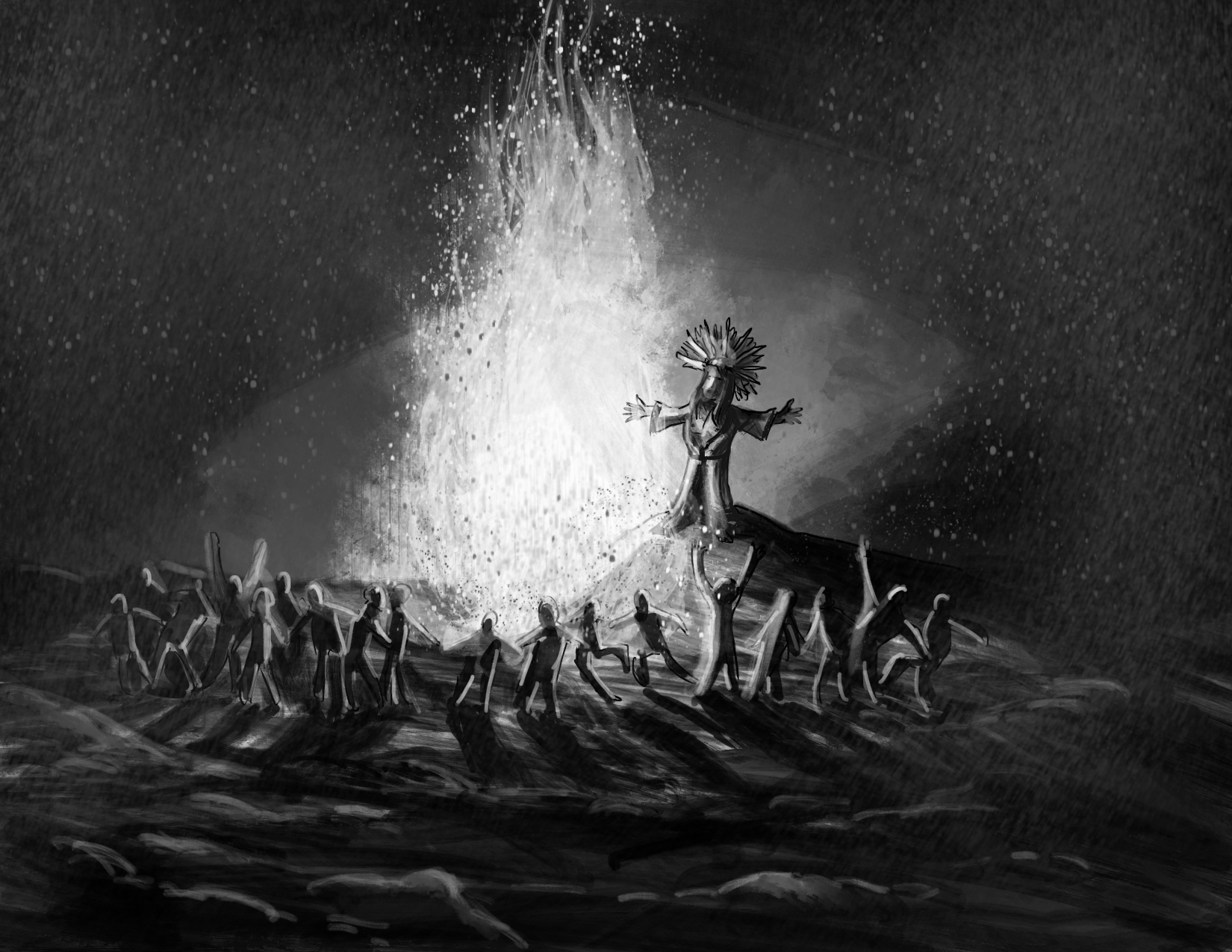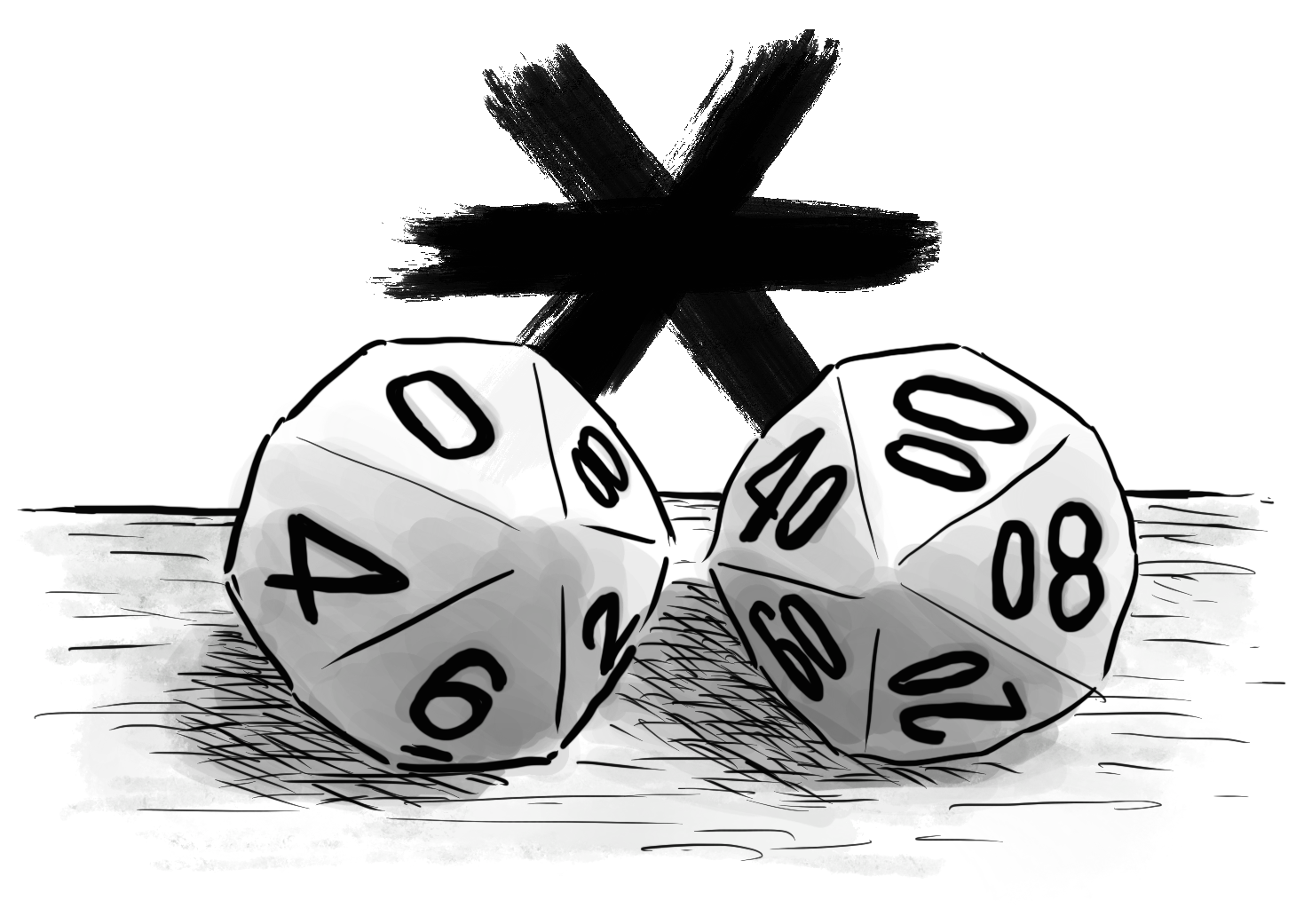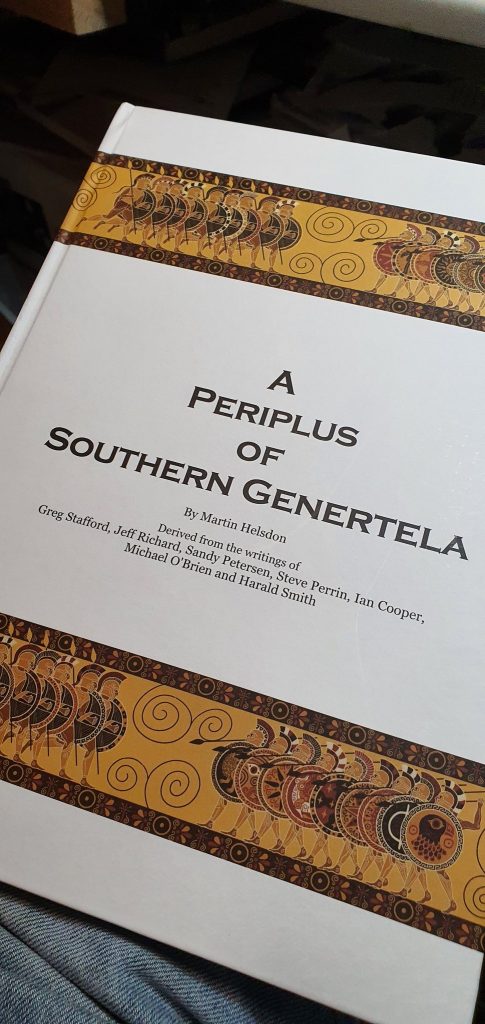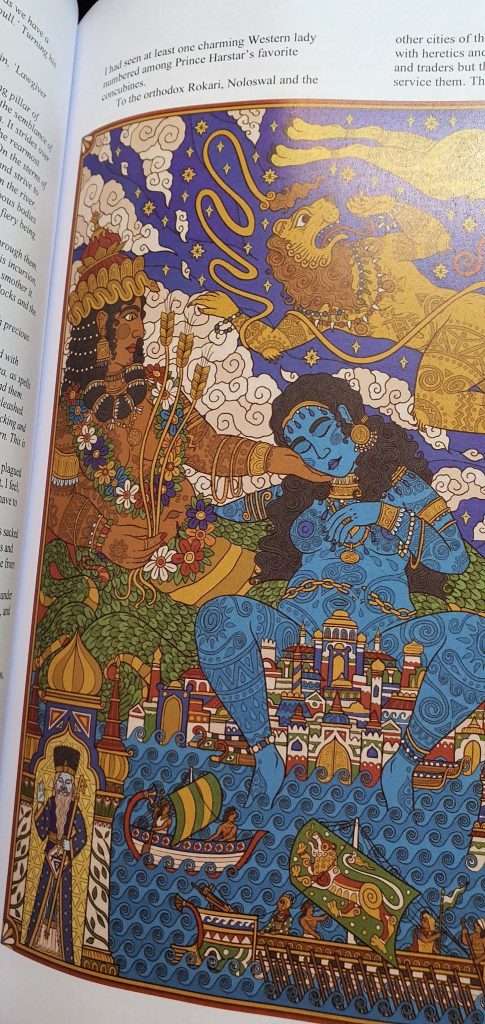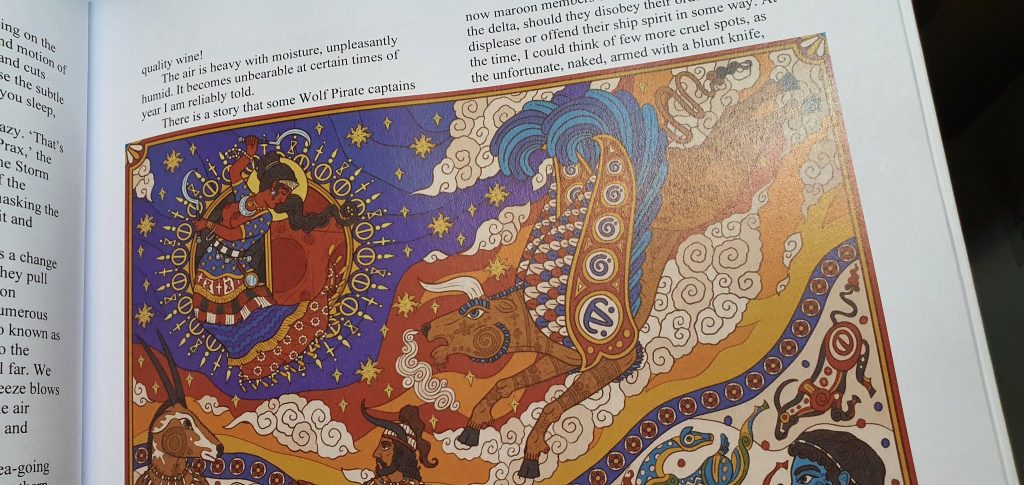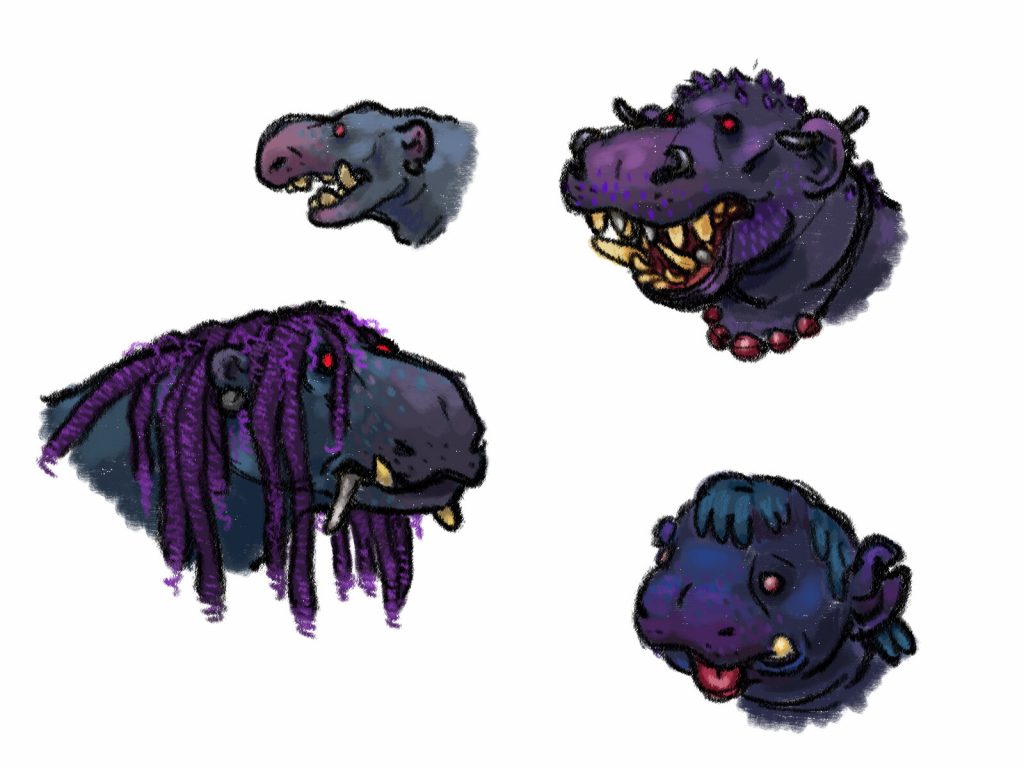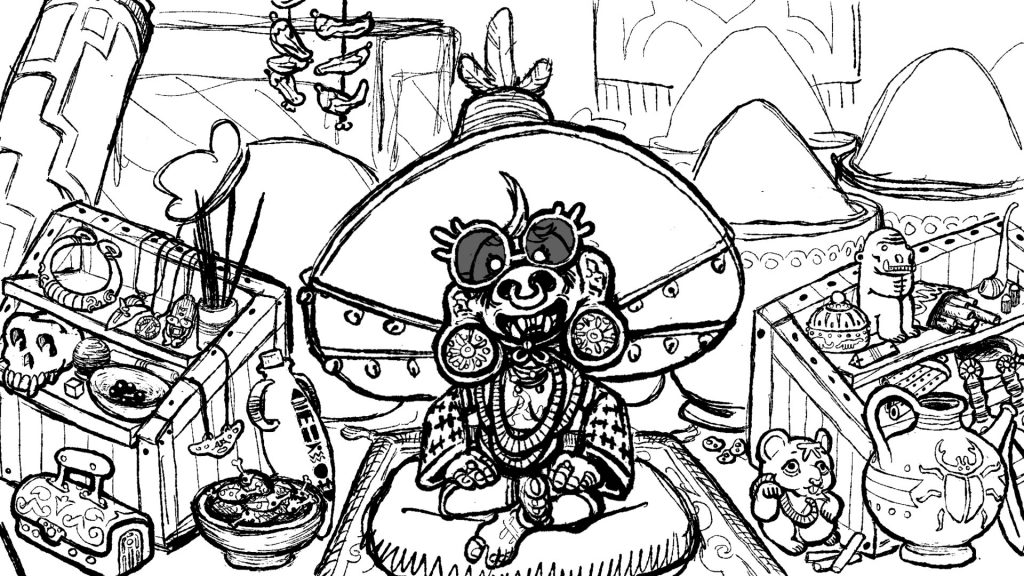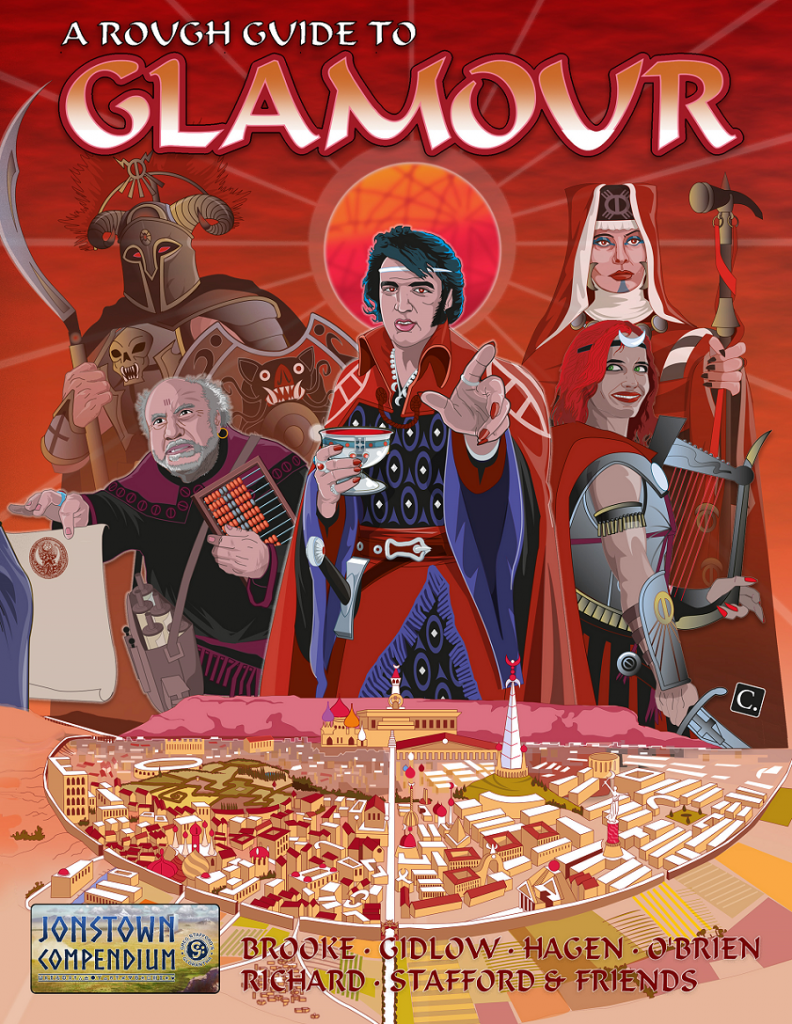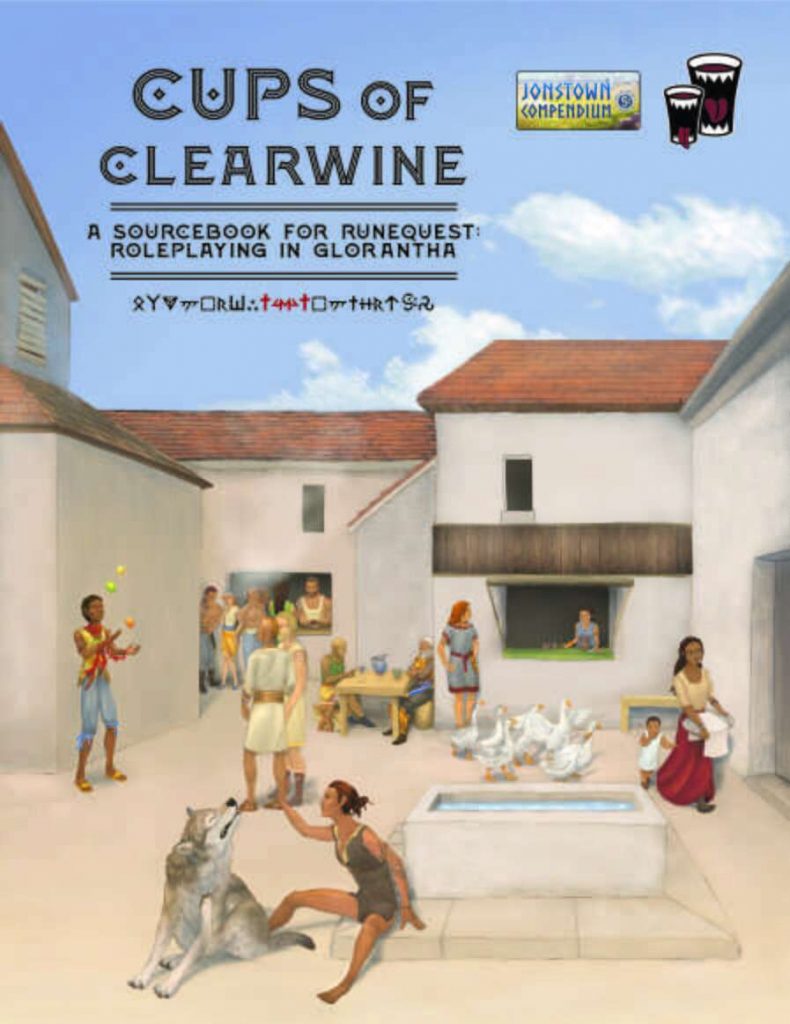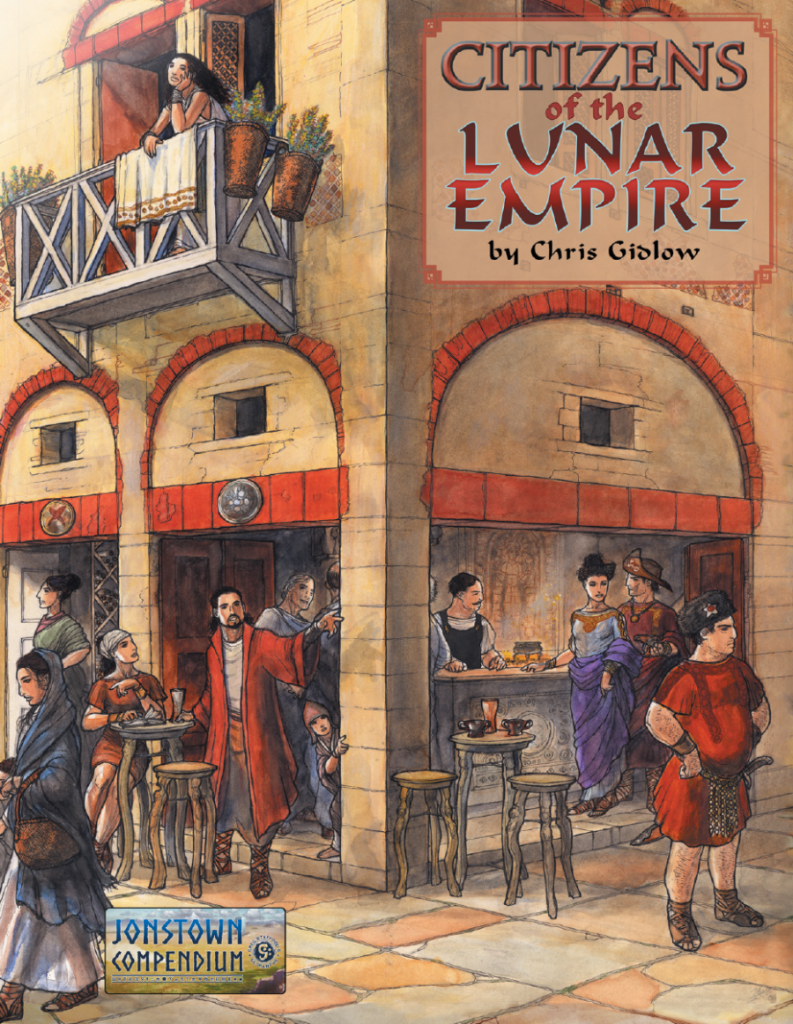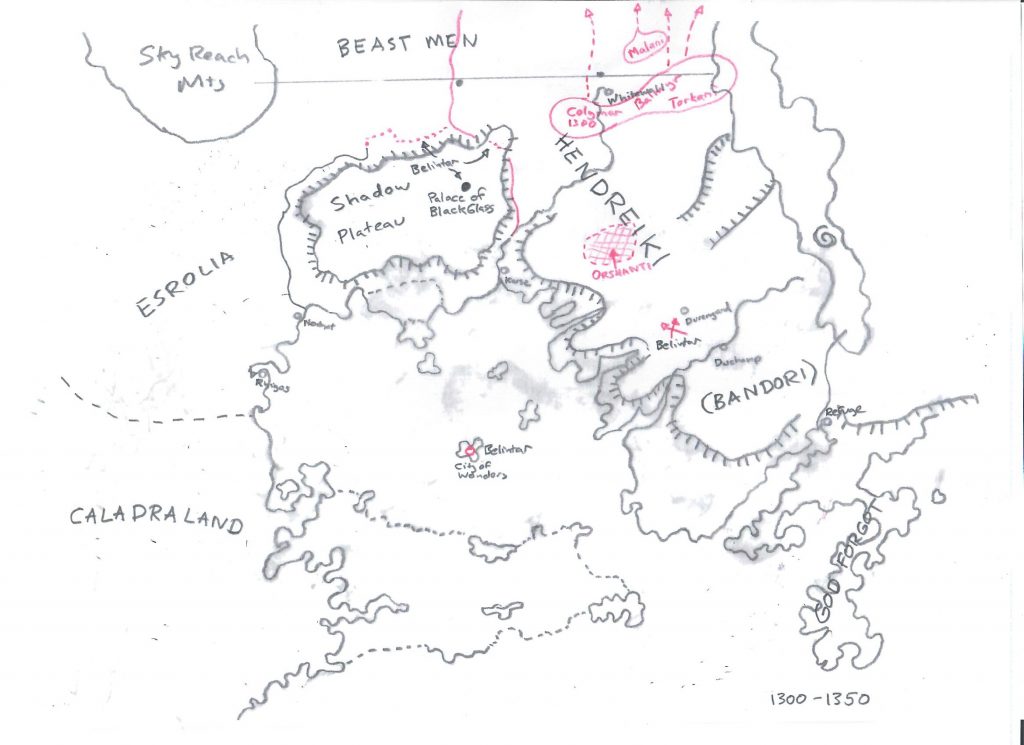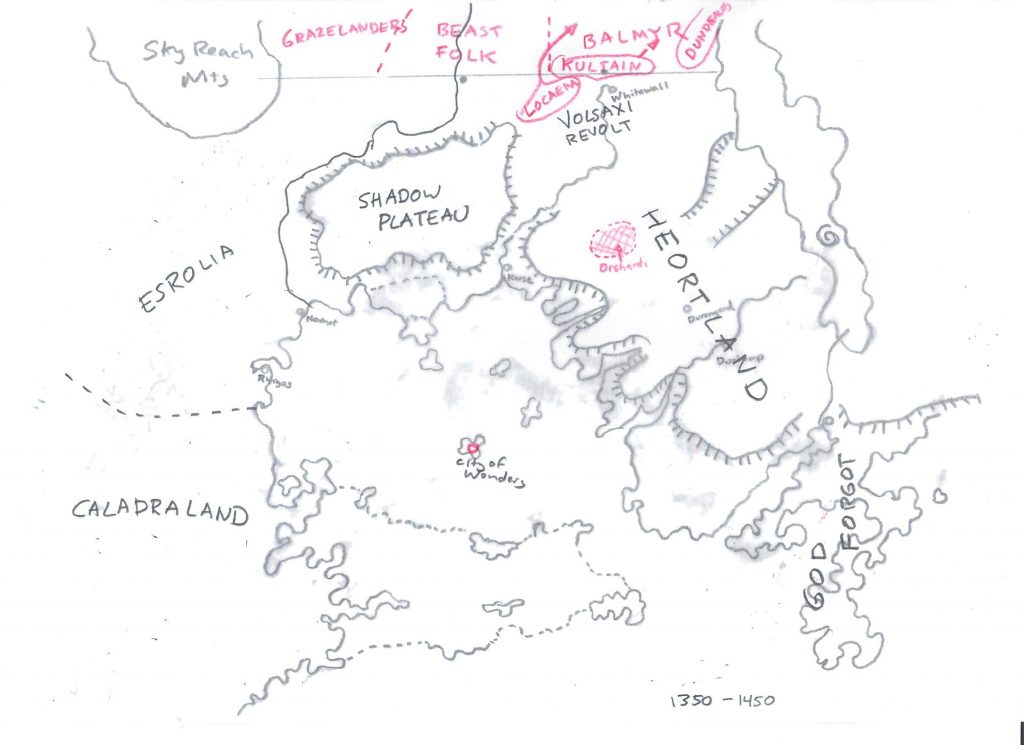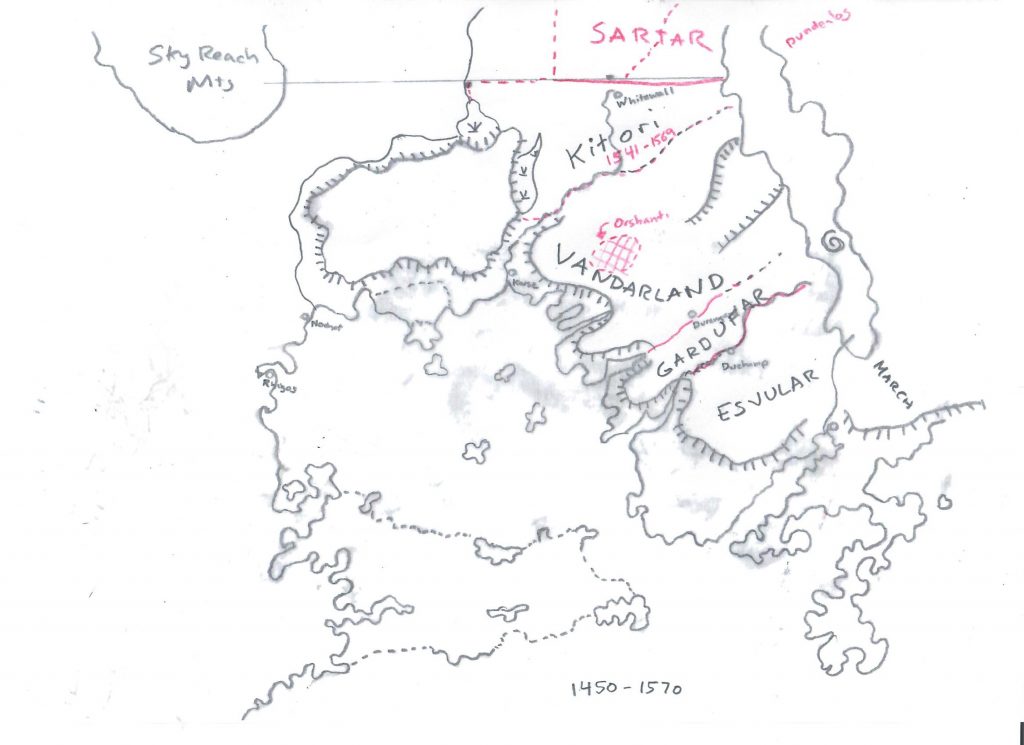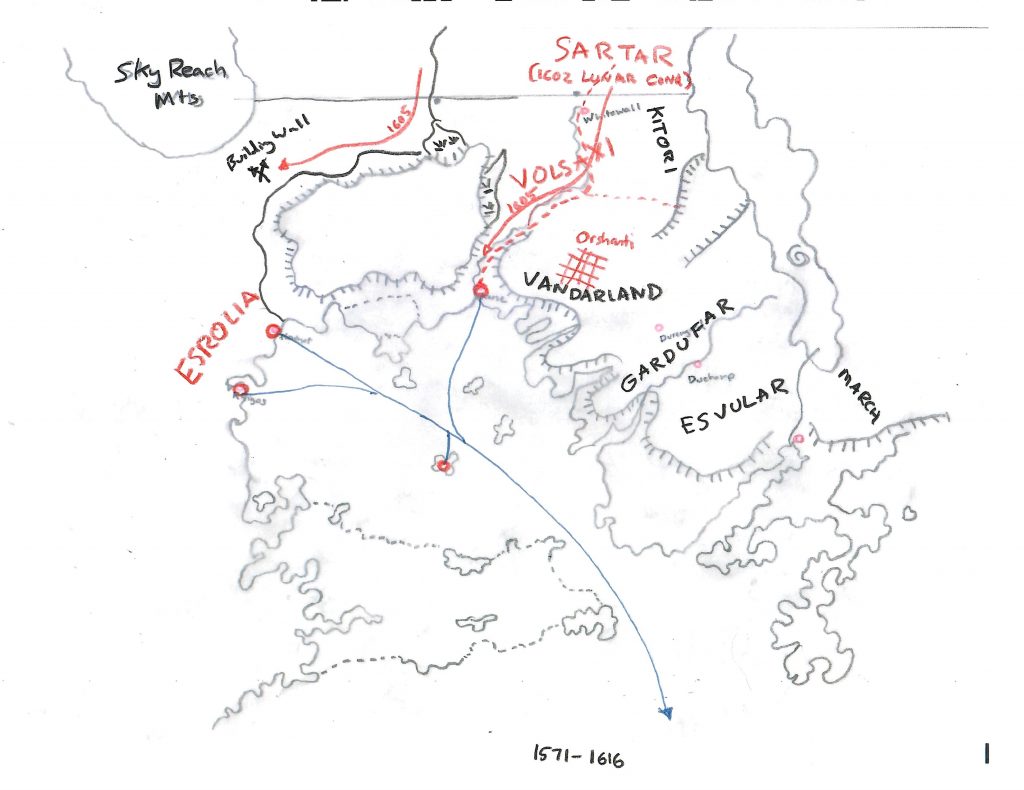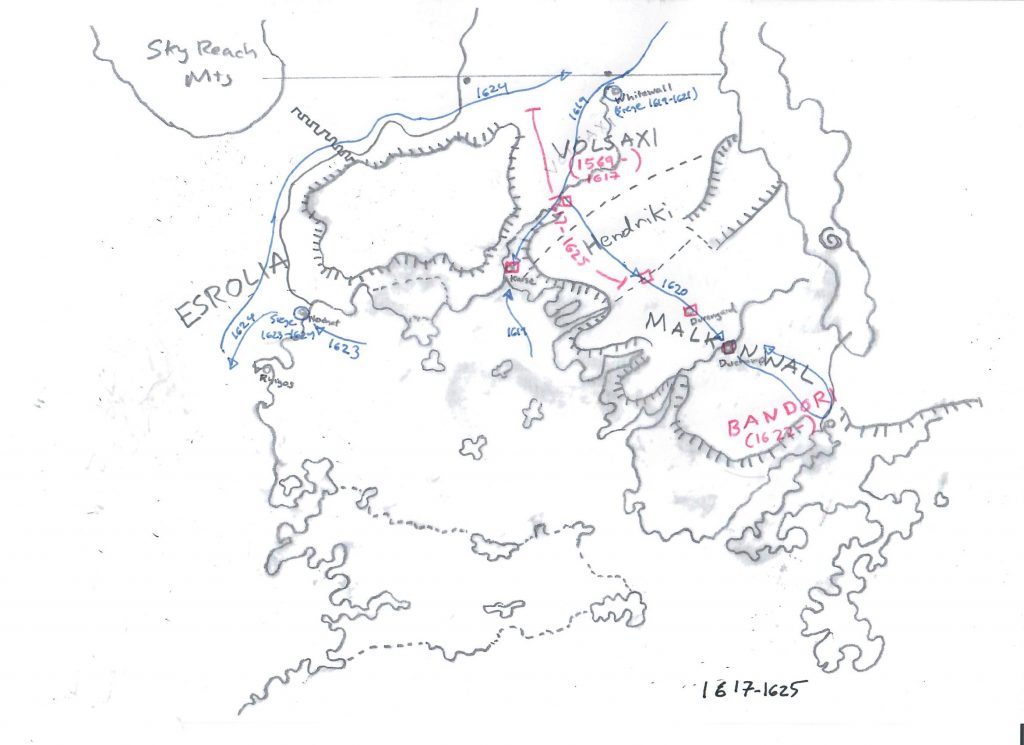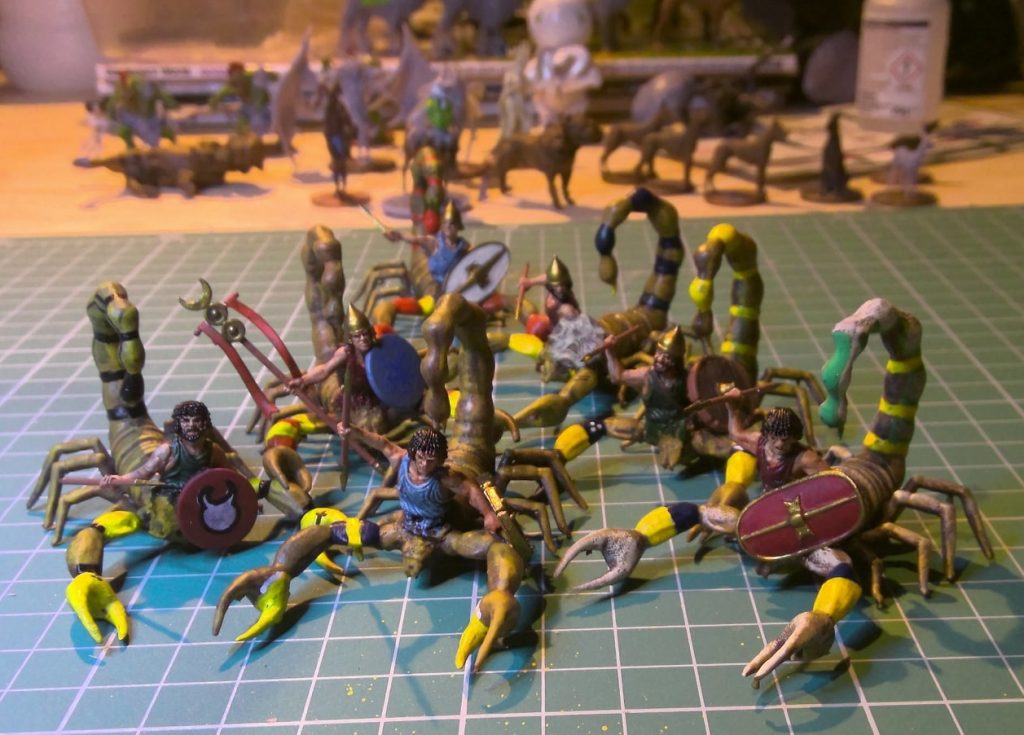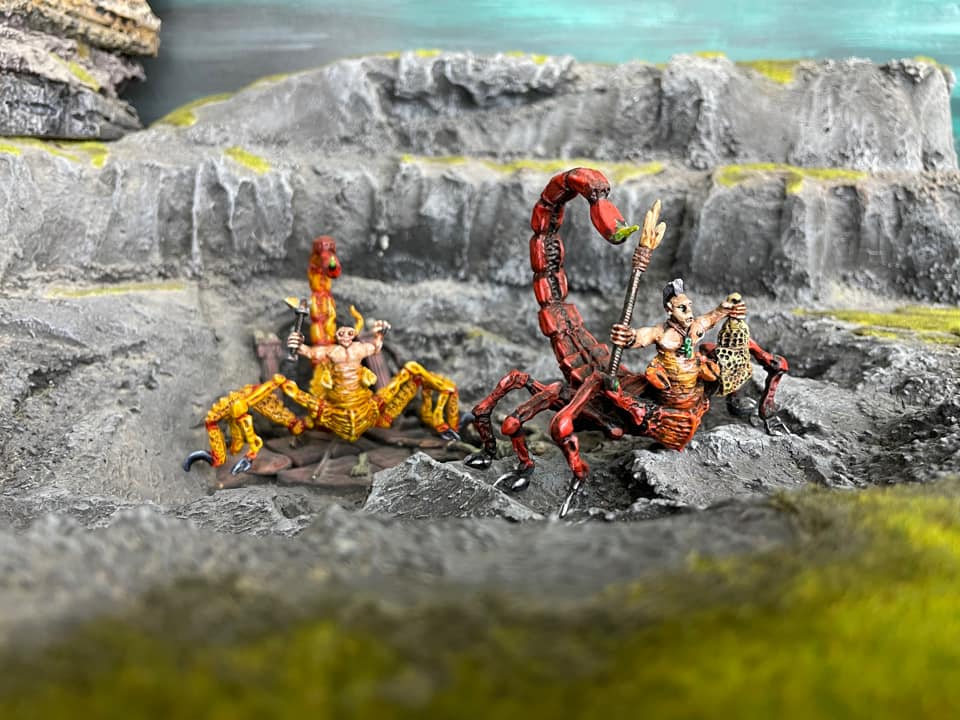Assuming Sacred Time happens just before Yelm returns and daylight increases again… happy Sacred Time! We hope your heroquesting was fruitful, Mallia was kept at bay, and boons and gifts will bless your upcoming year!
Welcome to a new issue of the Journal of Runic Studies, the premier Malkioni publication for studies into the nature of Glorantha. If you haven’t subscribed yet, please consult with the spirit bound to the appropriate electronic page.
This week we had a LOT of posts by Jeff on the Facebook groups, a new Glorantha Initiation Series episode, and that leaves little room for anything else in this issue of the Journal.
God Learner Sorcery
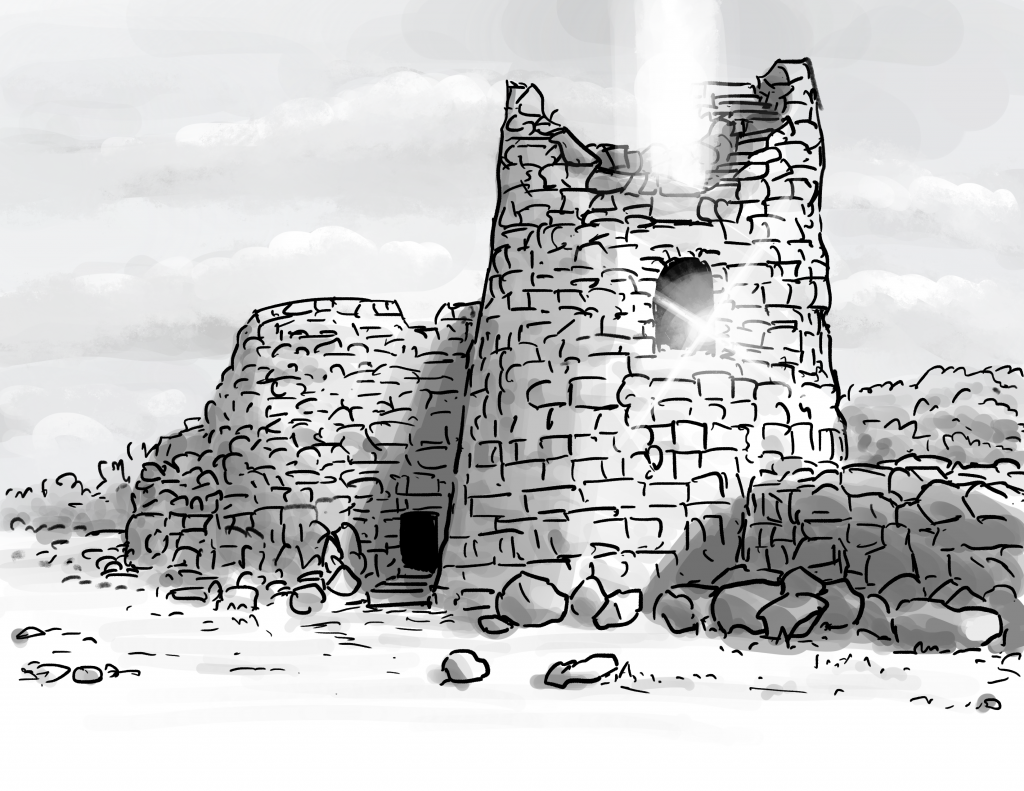
We are now occupying a nice little tower with a long history of previous occupants who have left behind documents, tablets, artifacts, and other kinds of junk. As we clean up and archive these things, we share the most interesting ones with you.
Initiation Series Episode 2

We released the second episode of our “Glorantha newbies” interview series. Our guest Russano Greenstripe talks about bringing Glorantha to D&D, finding inspiration in the Guide, and struggling to convince people to play RuneQuest. Check it out!
A History of the Glowline
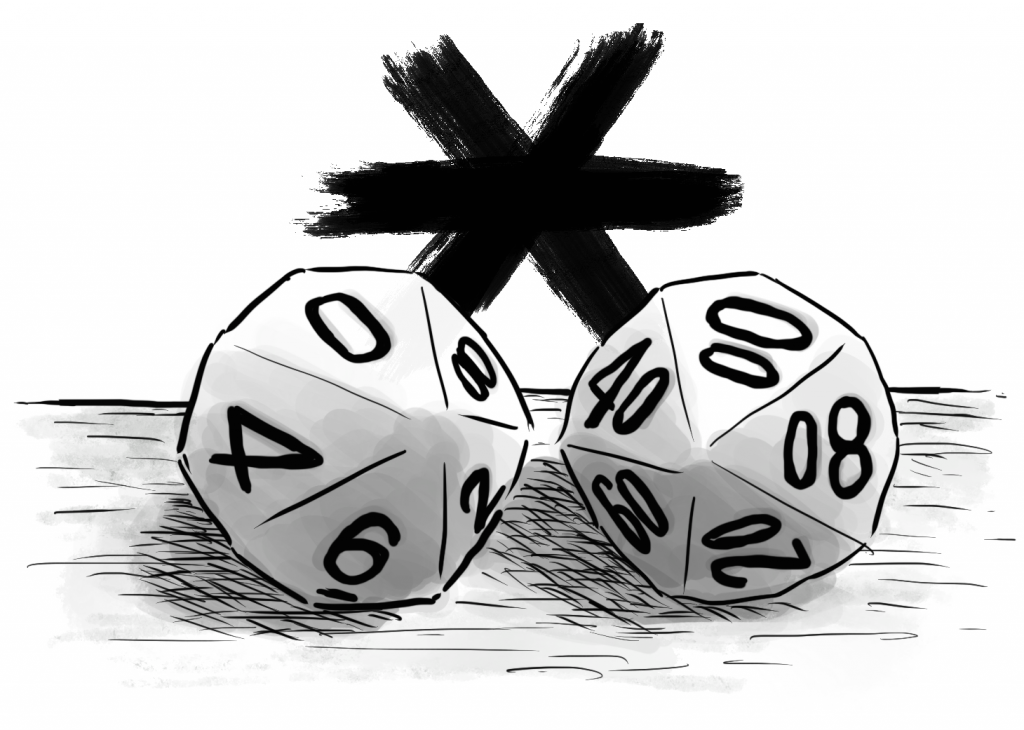
I wrote an article about the history of the Glowline rules in RuneQuest over the editions… Don’t ask me why, I think it was just fun to look through a bunch of books and PDFs. Keep reading into the “Jeff’s Notes” section for Jeff’s in-world take on the Glowline, though!
Chaosium News

Here are this week’s Chaosium news!
New Gamemaster Month 2022
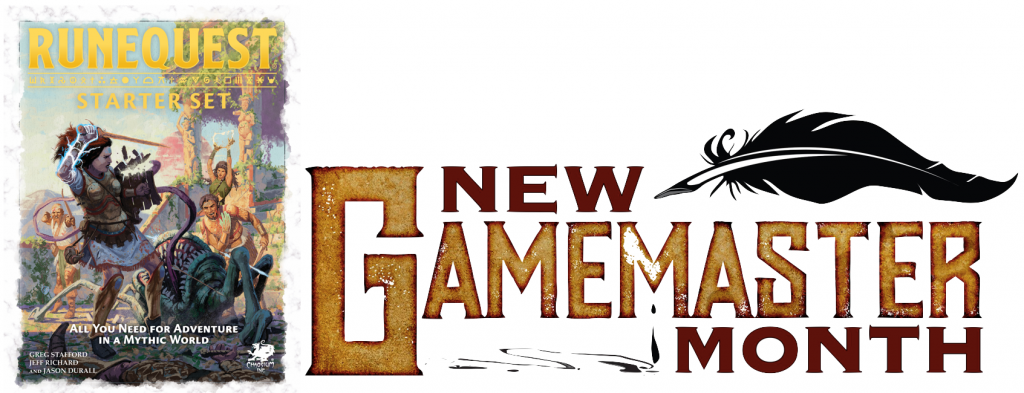
Every January, the people at Monte Cook Games (who publish chunky good stuff like Numenera and Ptolus) organize “New Gamemaster Month“, an initiative focused on helping people make the jump from player to GM (or go straight to GM, too, I guess, that works). They provide several resources for getting started on a few handpicked games, with an active community ready to help on Facebook, Discord, and other places.
For 2022, the game picks include several of my absolute favourites (Delta Green, Unknown Armies, Trail of Cthulhu). As you might have guessed, the selection also includes our good old RuneQuest. You can even get a 10% discount on the core rulebook and/or the starter set to get yourself started…. then, in January, the website will start featuring articles with instructions for preparing and running your first game. So keep an eye on that if you or someone you know wants to start GMing RuneQuest or any of these other fine games.
Jonstown Compendium

The Jonstown Compendium is Chaosium’s community content program for all Gloranthan games, hosted on DriveThruRPG. Disclaimer: all the relevant links are affiliate links that hopefully will let us cover some of the hosting and maintenance costs for the website and podcast! Thanks for using them!
Hsunchen of the East

Paul Baker continues his exploration of Genertela outside of Dragon Pass, with a sourcebook on two eastern Hsunchen tribes: some Yak folk, and some Tiger folk. It includes background and rules for creating characters belonging to these tribes.
Holiday Dorastor: Seven Hills
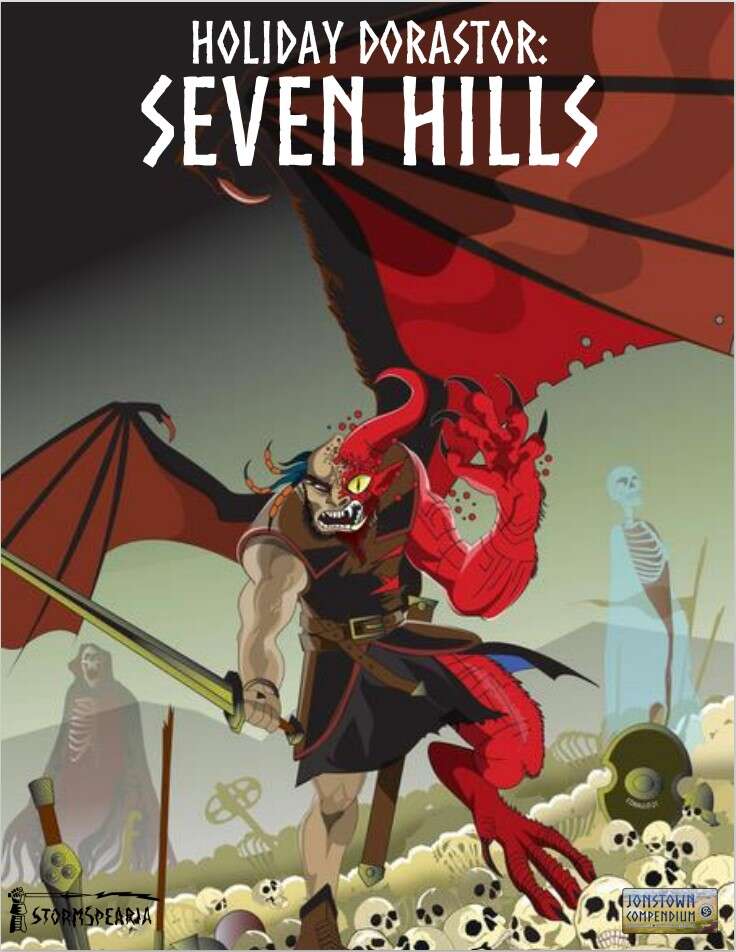
Meanwhile, Stormpearia continues to explore Dorastor (it’s so nice this time of year, isn’t it?) and in particular the area known as the Seven Hills. Expect the usual Stormpearia Dorastor goodness, such as foul creatures, new magic items and spells, and a scenario… or two… or… wait, no, there are eight (8!) scenarios in there! Simon Phipp and Leon Kirshtein promise us that they range from “beginner to advanced”, but I’m not sure I want to see what their idea of “beginner” is…
Holiday Dorastor: Krampuslauf
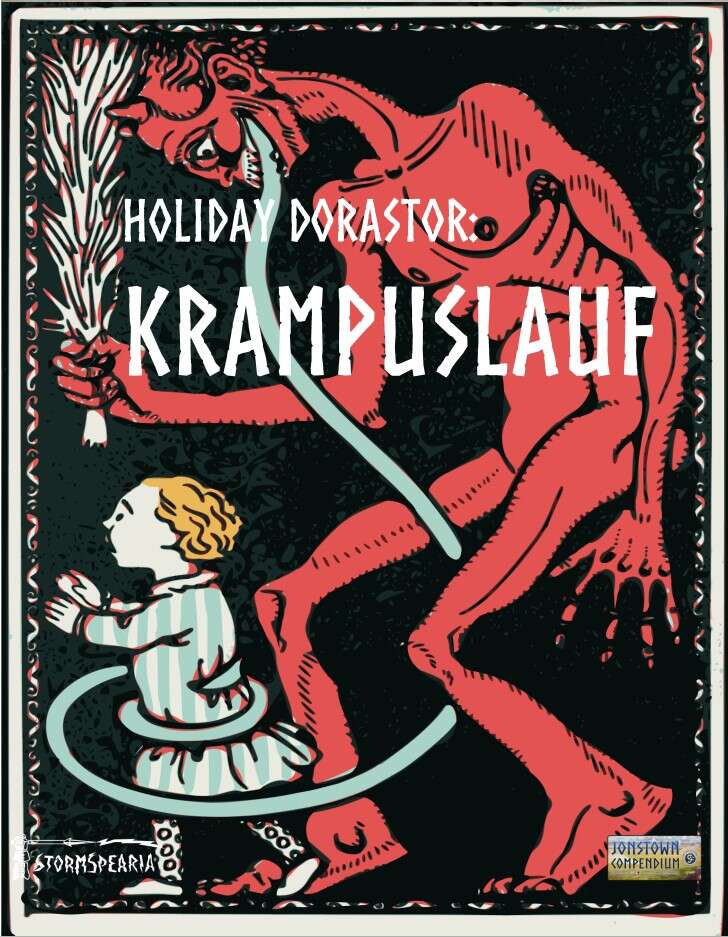
Apparently the previous 130 pages weren’t enough, so Stormpearia also released a much more modest 5 pages supplement to get in the holiday season spirit… have you been naughty or nice? Is Eurmal going to give you candy, or is Krampuslauf going to whip you?
The Company of the Dragon Gets Some Love

No, I don’t mean it that way, you pervert! What I mean is that Andrew Logan Montgomery’s best selling campaign was featured in Geek Native’s “Other Best Selling Fantasy RPGs of 2021“. Congrats Andrew!
Other nice appearances on that list include some Warhammer material, Mythras’ Mythic Babylon sourcebook, and the aforementioned Ptolus monster of a book.
Jeff’s Notes

Jeff Richard, the current mastermind on everything Gloranthan at Chaosium, is often posting notes and thoughts on the RuneQuest Facebook group. Here’s our curated list from the past week. A partial archive of these sources is compiled on the Well of Daliath.
Vasana’s Tattoos
We know that Jeff has been working with artist Anna Orlova to make detailed “turntable” illustrations of several key figures like Argrath and the Feathered Horse Queen (featured in a previous Journal issue). Jeff now shares that they’re also working on detailing exactly what tattoos they have, where, and what they mean. Here’s Vasana:
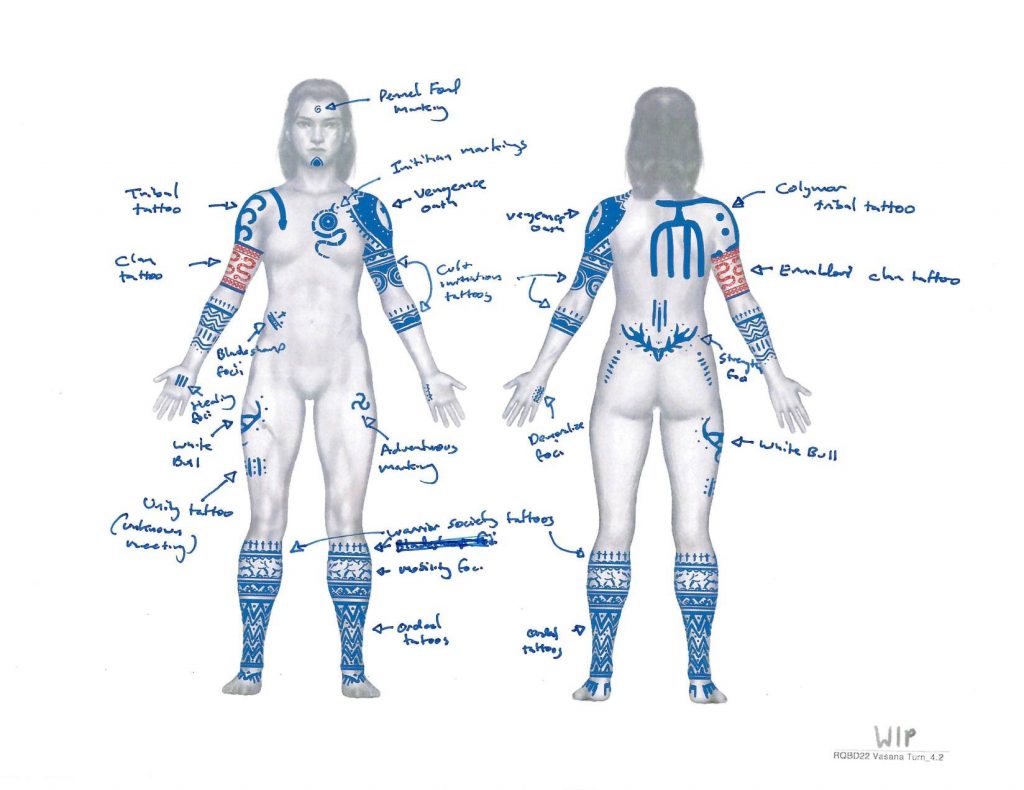
We can spot Vasana’s initiation tattoos, clan and tribe tattoos, tattoos from other factions like the White Bull, and foci for various spells. Of note, there are also “ordeal tattoos” from particularly big feats such as heroquests or delves down Snakepipe Hollow. Pretty cool! You can glimpse the important events in Vasana’s life this way.
This helps us tremendously with achieving a higher level of artistic consistency – and also lets us gain insight into these characters.
Remember, these tattoos are going to be far more painful than modern tattoos. That pain serves a magical purpose as it allows the recipient to focus on them without seeing them – the pain enhances their magical nature.
The Good Old Times
Jeff talks about the difference between survivors of the God Time, and mortals:
Waertagi, Golden Wheel Dancers, Mistress Race Trolls, elder Giants, Brithini – Glorantha has many relics of the Godtime that exist (to the extent they still do) in defiance of the world of Time. They continue their ancient ways, often refusing to acknowledge or accept Time and its changes. All of these peoples are dying out to a greater or lesser extent. The Golden Wheel Dancers were presumed extinct, at least until 1621.
Mortals, on the other hands, “have proven most successful in Time”. They experience the God Time (through worship and heroquesting and Rune Magic and so on), but as means to affect the mundane world.
Such mortals – in particular, the Orlanthi, the Lunars, and the Malkioni – have played a disproportionate role in the History of Time.
The Orlanthi and Malkioni are not trying to “revive” the good old times of the Storm Age or whatever. They are just tapping into it to be more successful here and now.
They are all good at recognizing the value of an old story or myth at providing guidance for dealing with a different now – but they also can see that the story is not a perfect guide.
[…]
The Orlanthi know that their greatest hero – Harmast Barefoot – assembled the pieces of the Lightbringers Quest from countless stories. And they also know that those stories were not sufficient guidance for him to complete the Lightbringers Quest. He needed to bring in new elements and new experiences to succeed.How do they know that? Because Harmast told them that. Twice.
The Lunars though are a bit more crazy:
They revived a dead goddess and created a Godtime inside of Time. And this Made in Time Godtime is being used at least in part to revive a Golden Age empire. The whole thing is a mad paradox worthy of Illumination points if studied for any length of time!
If you still want another big meta-plot lead (as if we didn’t have enough!), Jeff leaves this for you:
The idea of recreating the Empire of Wyrms Friends might have far more appeal though…..
Human Population in Dragon Pass
Would anyone think about the non-humans? Jeff goes over the early Dawn Age, when “the World Council of Friend (centered on Dragon Pass) united five mortal species, each of roughly equal strength and numbers – humans, trolls […], dragonewts, aldryami, and mostali”. Human population grew a bit faster than the other elder races, but it’s only in the Second Age that they became prominent, mostly because the others “tore themselves apart”.
In the Lunar Heartlands, most humans have likely never seen one of the Elder Races – certainly not the fearsome dragonewts or trolls, and even elves and dwarfs are rarely seen.
Things are different in Dragon Pass and the Holy Country. In the Holy Country, two of the sixths are dominated by Elder Races. Triolini are commonly seen in coastal areas and the trolls still rule their Shadow Plateau and in the Troll Woods.
In Dragon Pass, nonhumans occupied the region without ANY humans prior to about three centuries ago.
That was after the Dragonkill War, in 1120, when several Dream Dragons and True Dragons rose up and killed countless humans out of the blue. Well, not really out of the blue… the humans were threatening Dragonewt cities and nest eggs, I guess. Woops. That’s why you leave the Dragonewts alone now.
This was followed by a couple centuries of the “Inhuman Occupation”, when no humans were seen or dared enter in Dragon Pass. But of course we came back.
Since then, humans have regained their position as the dominant species, but still about a fifth of the population is non-human. Most humans have seen one of the Elder Races, and interaction is frequent. Beastmen, dragonewts, trolls, dwarfs, and elves are commonly seen, certainly along the roads and in the cities, but sometimes even in small villages. Morokanth are seen as often as any other of the Great Tribes, although they are feared (and often despised) as cruel slavers.
The Dragon Pass cultures are thus seen by many in the far West or in the Lunar Heartlands as being essentially non-human in some key regards.
So I guess I should have a lot more non-humans hanging around my markets in Sartar!
The Hill of Orlanth Victorious
Do your Orlanthi adventurers ever go on this pilgrimage?
It is roughly 20 miles from Boldhome to the Hill of Orlanth Victorious – a roughly comparable distance from the Akropolis of Athens to the sanctuary at Eleusis. No trade road connects the two, but countless Sartarites have made the pilgrimage.
During the rule of the Princes of Sartar, the Hill of Orlanth Victorious was where many Sacred Time rites were performed by many tribes and cults, overseen and supported by the Prince, and aided by the Red Vireo. People would travel from Boldhome, Jonstown, or beyond, take lodgings in nearby villages or camp in the fields. Priests and rune lords would offer sacrifices, perform rites and ceremonies, and Orlanth and his Lightbringers would be invoked by all.
The “Red Vireo” is not mentioned in any existing material, but will be in the upcoming Sartar Homeland boxed set: it’s the name of the clan whose lands include the sacred hill. See this map, previously shared by Jeff:
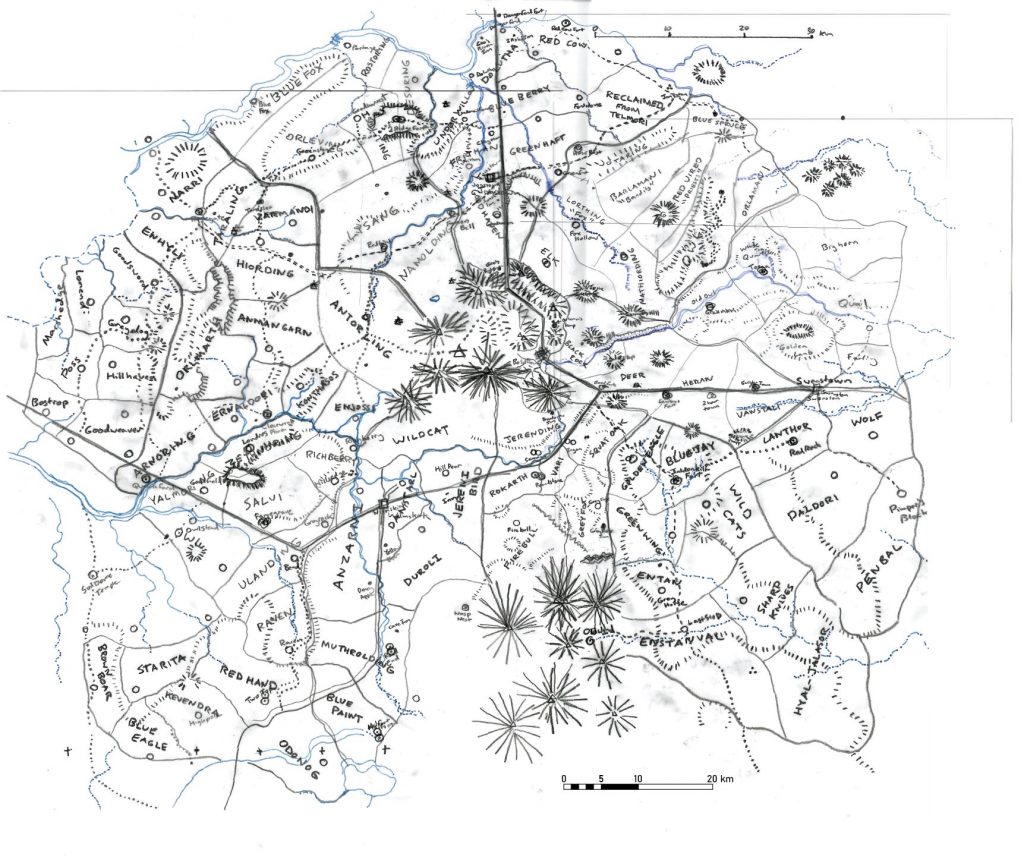
Having a big event like that in a game could be a big deal: besides the cool “Woodstock” or “Burning Man” vibe of a whole bunch of people camping together, this is a good opportunity to meet new NPCs, forge new ties, engage in gossip, and more…
Thousands of people, sometimes tens of thousands, would attend these rites. Priests and temples would jostle for priority, but for generations the Hill was under the direct protection of Hofstaring Treeleaper, a close ally to the Sartar Dynasty, and appeal to the Prince was thus rare.
There were of course many lesser celebrations of Sacred Time in Sartar, but the sacrifices at the Hill of Orlanth Victorious was THE celebration. The Prince, his household and companions, the leaders of the Lightbringers cults – all attended.
If you want a visual reference for the hill, Jeff suggests Bear Butte, in South Dakota:
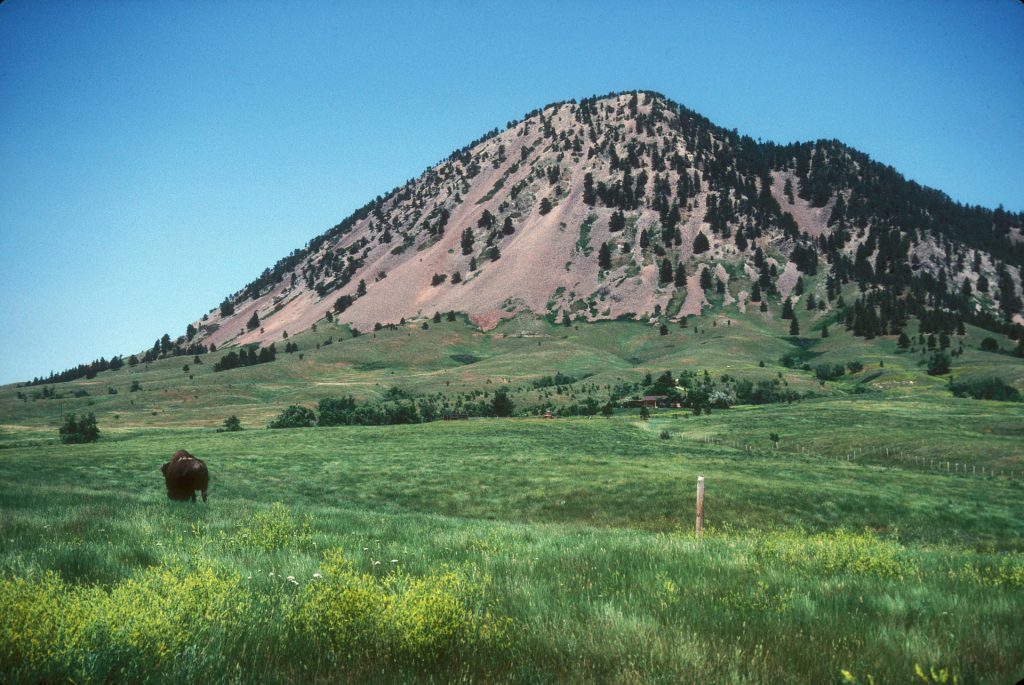
After Starbrow’s Rebellion, the Hill was guarded by the Yelmalio Cult (instead of by Lunar soldiers), and the celebrations were much smaller (and notorious rebels were turned away from the hill). With the Liberation of Sartar in 1625, arranging the Sacred Time rites at the Hill of Orlanth Victorious were viewed by many to be the single most important and pressing priority of the new Prince.
Jeff notes that the Yelmalions guarding the Hill is “a direct repetition from the Greater Darkness“… that’s nice of them, although getting paid by the Lunars is not quite the same.
Don’t forget that the Hill of Orlanth Victorious is classified, in game terms, as a Great Temple, so there is bound to be a lot of associated cult activity, too, from sages and merchants to clowns and berserkers…
All the tribes of Sartar would be present, one way or another, temporarily setting aside any rivalry. However:
Of course some tribes are overrepresented – the Culbrea, the Cinsina, the Kheldon, not to mention the urban populations of Boldhome and Jonstown. And other tribes are underrepresented – the Ducks, Lismelder, Locaem, and Kultain are present in only small numbers if at all.
As the place from which Orlanth began his Lightbringer’s quest, and where Harmast Barefoot began two heroquests of that myth, the Hill of Orlanth Victorious has a pretty “permeable” boundary between the mundane world and the Other World:
Steps are taken to make sure the participants do not begin the Lightbringers Quest (as that quest is known to be extremely dangerous and unpredictable). For example, the Bad Rain is not normally summoned and the full ring not gathered.
But after the Liberation of Sartar, Prince Kallyr Starbrow begins preparations to perform the Lightbringers Quest (although she makes preparations to limit its dangers and unpredictability). Her quest, ultimately a failure, accelerates the Hero Wars and dissuades any from following in her footsteps for another generation, when Prince Argrath, desperate in the face of renewed Lunar might, performs the quest without any limitations or reservations.
Holy Places of Dragon Pass
Speaking of holy places where the boundary between worlds is thinner, Jeff gives a list of the notables ones: Hill of Orlanth Victorious (as we just saw), Kero Fin, Shake Land (which I assume is the area around the Shaker Temple?), Wild Temple, Quivin Peak, Dragons Eye, Caves of Chaos, Castle of Lead, Tarndisi’s Grove, Dryad Woods and Forest of Wondrous Beasts, and Arrowmound Peak.
I’m actually surprised to see Tarndisi’s Grove there: I assumed this one one of several elf groves around Dragon Pass, and not something special enough to make that kind of list. Or maybe all elf groves would make that list?
Many of these places have been centers of cult activity for centuries or even millennia. When you see them, you know that this is something wondrous and remarkable. Mortals gather at these places to interact with the Godtime, and spirits and gods can be easily contacted there.
Such magical locations have power comparable or greater than the greatest temples, even without the presence of the mortal worshipers. They are were great acts of Creation took place, where the world took its present form, or linger remnants of a world that otherwise died in the Great Darkness, or both.
What About the Triolini?
Jeff thinks that the Triolini don’t get enough attention in games centered around Dragon Pass, the Lunar Empire, or Prax… and I mean… yeah? There’s so much to do inland that adventurers probably don’t go down south to the shore very often.
It is worth considering that there are some 33,000 triolini in the Choralinthor Bay, mainly ludoch merfolk, but a smattering of mightier beings.
Fatalistic and often harshly practical, the ludoch are about as interested in landwalker politics as humans are in the conflicts beneath the sea. Their gods are often similarly ignored by the landbound species, but within their watery domain they are supreme.
I’ve always found the non-human pantheons overly simplistic, which can easily be explained out of game (people play humans the vast majority of the time, and therefore need more material there) and in-game (the God Learners who classified these deities are humanist elitist assholes… and I say that with much fondness in my heart). I think if I had a game that took a closer look at the merfolk, I would hint at little-known gods and heroes…
Until a little more than 40 years ago, the surface of the oceans were impassable to the landbound. Prior to that only the triolini had access to the blue waters. With the Opening of the Seas, the Mirrorsea ludoch are a tremendous ally for the sailors of Kethaela. They know (or can easily learn) the currents, conditions, and dangers of each body of water and can often intercede with the rulers of the waters on behalf of their friends.
One day I’ll get to play this long-distance trading campaign I’ve had in mind since I started reading about Glorantha. I think alliances and safe passage with the Triolini would feature just as much, and maybe more, as alliances and safe passage with various tribes, trolls, and other factions on land.
The Crimson Bat, and Other Terrors
Jeff mentions that, just like in Call of Cthulhu, the world of Glorantha is populated by horrible giant monsters: the Crimson Bat, Cwim, the Mother of Monsters, the Chaos Gaggle, the True Dragons, etc. The difference, Jeff posits, is that there are also heroes that are capable of defeating them, hinting that he has for instance seen games where Argrath defeats the Crimson Bat.
As a long time Call of Cthulhu player, I would add that the Mythos creatures have a few other things Gloranthan Terrors don’t have:
- A tendency to be a lot more “weirdly supernatural” (such as those who stalk you across time and manifest through acute angles, or those who are hyperdimensional beings who only appear as a color that can’t possibly perceive)
- An ability to blast your sanity way more effectively (Terrors have spot “fear” rules that arguably make these monsters more personalized and flavourful, but few have that kind of power, and their effects are never permanent)
- The ways to destroy them consistently involve corrupting yourself with their nature (I don’t think I’ve heard about anybody who had to take on a Chaos Taint to defeat a Terror, but that’s a great lead for an adventure if you ask me…)
Anyway:
But the presence of things like the Crimson Bat, as well the Lunar College of Magic, the Crater Makers, Jar-eel, the Full Moon Corps. etc – these are the backbone of the Lunar Empire’s incredible successes. The regular army units are better than average, but not powerful enough to defeat Sartar led by a member of its royal dynasty. But with its magicians, the Lunar Army can roll over most foes.
Unless of course they have their own magicians and heroes….
Jeff continues:
The importance of the Crimson Bat for the expansion of the Lunar Empire cannot be understated. We all know it is awesomely powerful in its own right, able to devour an entire regiment, spirits, and more – but it is also a Glowspot. Within about 10 miles of the Crimson Bat, Lunar magicians suffer no penalties even on crescent and dark Lunar phases.
The pinkish glow of the Crimson Bat can be seen for many miles, and its presence in the borderlands of the Lunar Empire strikes terror into the hearts of outsiders. One can assume if the Crimson Bat is heading your way it is accompanied by soldiers, magicians, and more.
During The Strong Making Peace wane, the Lunars used the Crimson Bat and Yara Aranis to strike fear into those nomads not led by Sheng Seleris – even those two demons were insufficient to strike against Sheng Seleris directly. But against tribal uprisings or confederations, they are normally more than sufficient.
I imagine there must be a big difference between a citizen’s view of the Empire, and that of a foreigner. The citizen’s view is about living in or near a city with art and culture and wealth and an idealized image of the Red Goddess and the upper class. People at the edge or outside of the empire see it as a ruthless imperialist machine with weapons of mass destruction, a highly corrupt and potentially insane ruling class, and a tendency to create their own enemies. Any similarity with a real-world nation would be coincidental…
That’s why I find it interesting to explore the difference between Passions like Hate, Devotion, and Loyalty to the Red Emperor vs the Red Goddess vs the Lunar Empire vs a specific nation like Tarsh.
About the Glowline
Speaking of the Lunar Empire, Jeff talked a bit more about the Glowline (and I did too in a recent blog post on its game mechanics):
Normally, Lunar Rune magic and Lunar magical techniques are only at full effectiveness three days out of the week. The other four days a week, Lunar magic is either underpowered or not available at all.
During the wars of the Zero, First, and Second Wanes, this was not that great of a disadvantage. Few of the Empire’s foes really understood the Lunar Cycle, and the Lunar magicians were a minority within the army. Most soldiers belonged to non-Lunar cults – Lodril, Yelm, Humakt, whatever – and were usually just lay members of the Seven Mothers. Lunar commanders would maneuever [sic] so that battle would occur on Empty or Full Half days, or even better during the Full Moon, so that the Lunar magicians could play a decisive role in the battle.
As the Lunar religion grew, more and more soldiers were members of Lunar cults, and the Lunar magicians grew in importance.
Jeff then explains that the Third Wane was a disaster, since Sheng Seleris figured out that he could outmaneuver the Lunars and force them to fight on waning days. This was especially easy since Sheng’s army was entirely composed of highly mobile horse-riding nomads.
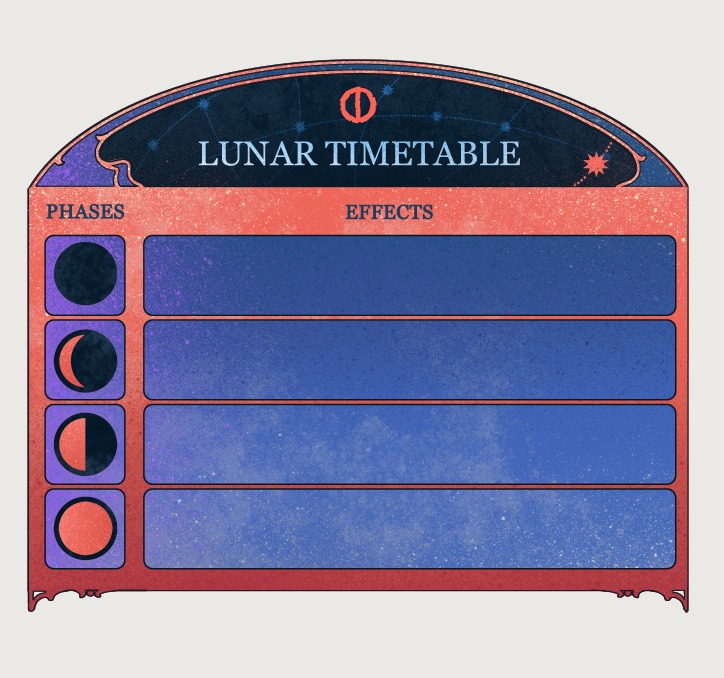
Yara Aranis was created to resolve this weakness. Her temples provided centers for magical defense, and the Glowline which they created eliminated the weakness of Dark and Crescent Moon days. Within the Glowline, it is always effectively Half Moon day. Lunar magic is fully effective, and the superior resources and training of the Lunar magicians mean that they are usually a match for any comparable number of opposing magicians. And since the Lunar empire has not foe capable of mustering a comparable number of opposing magicians, this means that within the Glowline there is almost no foe that can stand against the Lunar College of Magic.
Outside of the Glowline is another story. Four days out of the weak, the decisive arm of Lunar victory is denied to the Lunar Army. The Lunar Army tends to be tentative, hesitant, and easily routed outside of the Glowline, unless led by the Red Emperor, accompanied by the Crimson Bat, or led by a first tier leader like Fazzur Wideread.
If you’re wondering why Yana Aranis didn’t make the Glowline permanently “full moon” (which I looked at in my article from a purely game design perspective), Jeff gives a more in-world reply:
[It is] outside of her power. Can’t get something for nothing, not even for the Red Goddess.
And if you’re wondering why an expansionist empire would make costly stationary temples to support their magic, instead of an entire fleet of mobile Glowspots units, Jeff also has an explanation for you:
When they created the Glowline they were definitely NOT an imperialistic expansionist culture. They were a barely holding on, trying to survive being conquered by a World Conquerer.
Heroquesting Lunar Myths
While we are with the Lunars, here are some notes about heroquesting their myths:
Few non-Lunars have ever dared explore the experimental landscape of Lunar mythology. Most celestial cults are reluctant to look into the shadows, and the Earth cults rarely look up into the sky. Maybe some of those Water cults might take a back route there along the path of the Blue Moon, but who cares about merfolk!
This is generally interesting, and somewhat validates some hook I used recently in my game: elves were reluctant to heroquest into Darkness deities’ stories, and got the adventurers to do that for them… well, my players ended up refusing to go down in that pitch black hole so I guess it didn’t work, but fun times anyway.
So who might be bold enough to explore Lunar mythology? Jeff has two candidates in mind:
The more intrepid Darkness cults like Subere are comfortable in the deepest darkness of the Underworld and might be able to find some of those same paths. Heck, might know some of them better than She does. So if I were the Red Emperor I’d be cautiously wary of the trolls as much as I despise them as vile digijelm.
The other candidate would be a god famed for assembling a band of misfits and then forging a path through the deepest Underworld to its very bottom. One who was willing to get lost, to lose everything, in order to find the right path through the deepest darkness of the Underworld and then unite others to defeat the God of Chaos. One whose defining Quest is so very similar to that of the Red Goddess herself that it might be that his quest be uncomfortably near the source of Her power? Yes, I would keep on eye on that one as well.
To me however the question isn’t so much “who would dare heroquest into Lunar myths” but “what would they do with it”! Got any good scenario hooks? Please share them!
Karse
Let’s bounce down to the other side of Dragon Pass, to the city of Karse. It’s in Hendrikiland, south-east of Sartar, on the shore of the Mirrorsea Bay. Jeff notes that it’s very old, as it dates back to the Dawn.
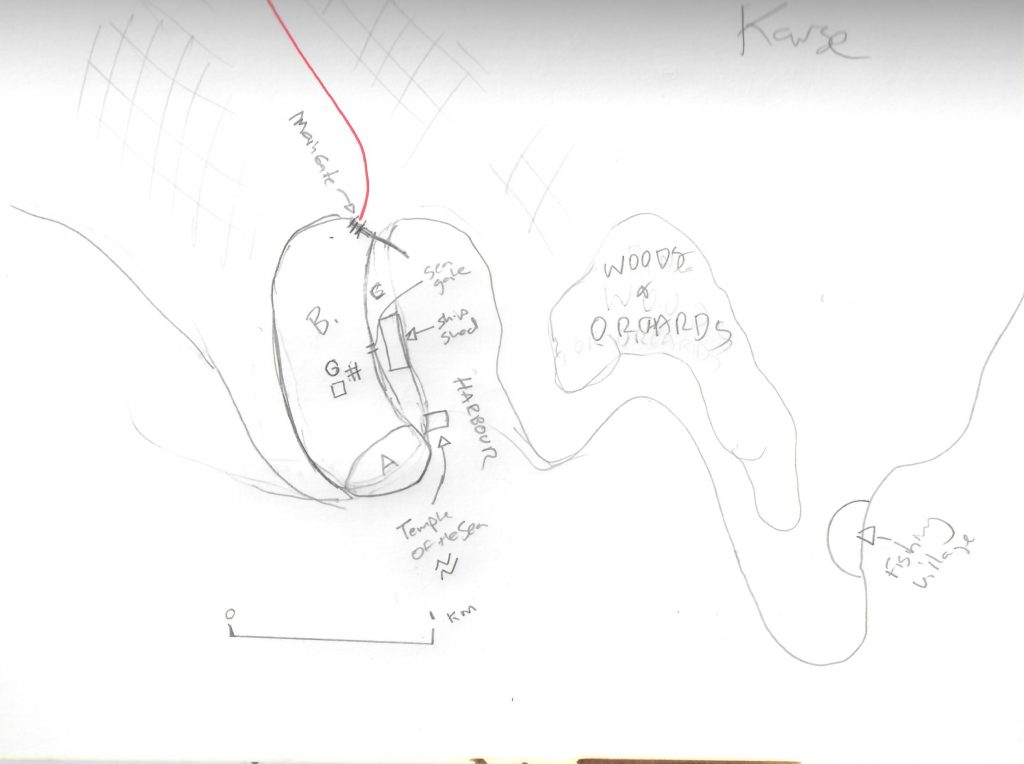
Karse has a fortifications all around, with two main gates – a Land Gate (the main gate) and a Sea Gate (that leads to the harbour).
A. Fortress. This fortress guards the harbor. It fell to an assault of dragonewts in 1619. It is now the base of operations of whoever rules the city.
B. Main City. Here are the temples, residences, markets, and warehouses. The enclosed area probably has several open areas, for tanning, and other crafts, or for storage of bulk goods or animals. I imagine there are a lot of inns – caravanserai – in the city.
C. The Beach. This is where boats are beached. There’s a ship shed for repair, maintenance, etc., that probably can house 20 ships. There’s a wall near the end of the harbor, past that small fishing boats are beached. Also on the Beach is the Sea Temple, with shrines to Magasta, Choralinthor, Diros, Dormal, and the gang.The Harbor is a natural inlet that has been worked on for the last 1500 years.
Beyond the harbor are coastal pine woods and orchards, and a large fishing village.
Jeff provides a little bit more information in follow-up comments: elements of the cyclopean walls from before the Greater Darkness are probably still used, “but those are thousands of years old, and likely much has been replaced“.
This should be enough to flesh out the city for a campaign!
Jeff also recommends looking at Massalia as an Earth analog for Karse. Massalia is the ancient name for the contemporary city of Marseille, in Southern France. It was founded as a Greek colony around 600 BCE, and might have looked like this during its Hellenistic heyday:
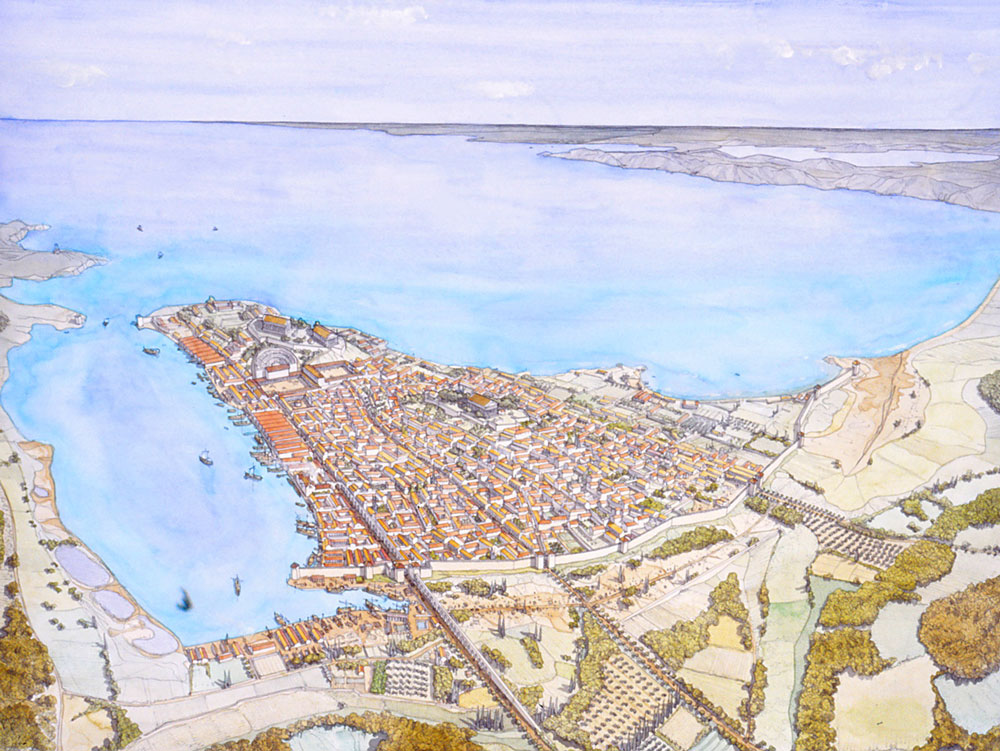
Notice the roughly rectangular harbour, with the city on the left side (when sailing in) in both Karse and Massalia. With this harbour, Karse is a notable trade city, so it is “going to have lots of inns and caravanserai as it is an entrepôt for the trade through Dragon Pass to Peloria and Prax“.
The city is no doubt filled with Sartarites and Esrolians, perhaps more than Heortlanders. There are likely some Etyries merchants still there, as they are protected by the Issaries cult, but I suspect most of the Seven Mothers cultists fled in 1624.
Jeff notes that in the early 1600s, Etyries merchants and Seven Mothers cultists would have been present too. Sure, they could report back on any war effort related to the Lunar invasion of Sartar, but so would Issaries merchants going to Peloria. There’s a lot of trade anywhere from Karse to Furthest.
“Few Gloranthans believe in total war – certainly not the central Genertelans“, says Jeff, so all leaders across Dragon Pass prefer to keep the very lucrative tolls and taxes coming from trading rather than close their borders when a war is going on. In particular, the King’s Roads in Sartar are under the direct protection of the Prince of Sartar, whose main deity (Orlanth) is neutral towards the Etyries cult anyway.
Martin Helsdon added a bit of historical context if you have trouble reconciling war and trade going on in parallel. As often, I see these situations as opportunities for more fun and adventure. The adventurers might escort a caravan and be approached by spies of one faction or other, asking to carry secret messages, spy on their employer, or whatever else. They might find a route temporarily closed for a reason or other, and have to bribe their way through, or find a detour. They might even be framed, as a patrol searching their stuff finds something they shouldn’t have!
Community Roundup
The community roundup is our highlight of interesting things being mentioned in the Glorantha-related Facebook groups, sub-Reddits, and other similar online places.
Crawling Through the Rainbow Mounds
You might know the map by heart if you’ve played the Rainbow Mounds from its classic incarnation to its RuneQuest Starter Set revamp… but do you know how claustrophobic it feels when you’re actually inside? Fear not! Err… well, actually no, do fear!
D R is working on building the entire cave complex in Unreal Engine (a quite fine choice of game engine if I say so… ahem). Check it out:
According to some status update on the BRP forums, the modelling is done, but there’s still work to be done on the textures.
The Iconic Podcast Reviews the Starter Set
JM and Evan delve into the RuneQuest Starter Set for almost an hour, with the most in-depth review to date of this product.
A Cool Looking Wood Lord
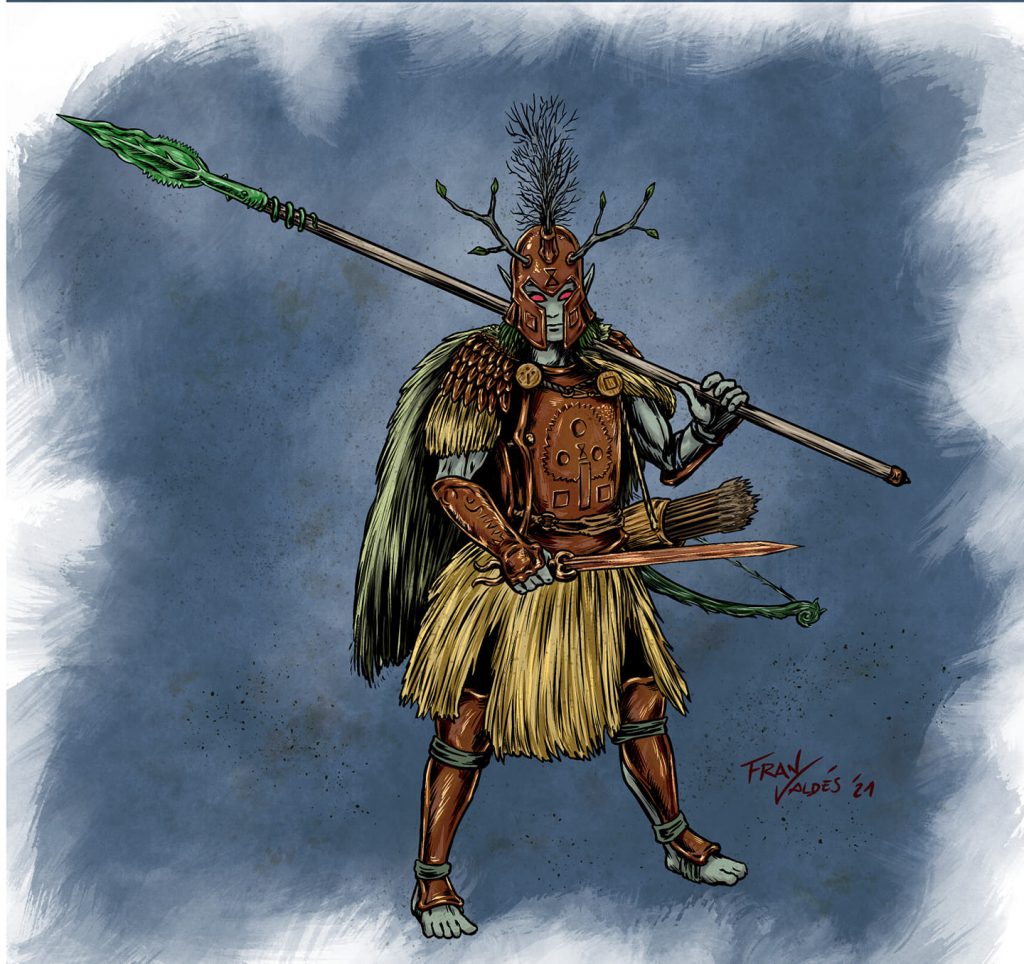
Fran Valdes painted this nice looking Aldryami warrior!
Aldriami vronkali, Wood Lord in arms. Runic cooper plate armor and sword. Spear head hasvested from a magic plant. Hail Aldria!!!
Elsewhere on Arachne Solara’s Web
Not everything is about Glorantha, although most things are! Here are loosely relevant things that we found on the interwebs.
Real-Life Dryad
I’ve seen this image popping up a lot in my feeds this week! Hard to say if it’s an image manipulation, or if the tree has been “nudged” into shape, or if it’s a totally natural occurrence, but it sure is a great art reference for a dryad:
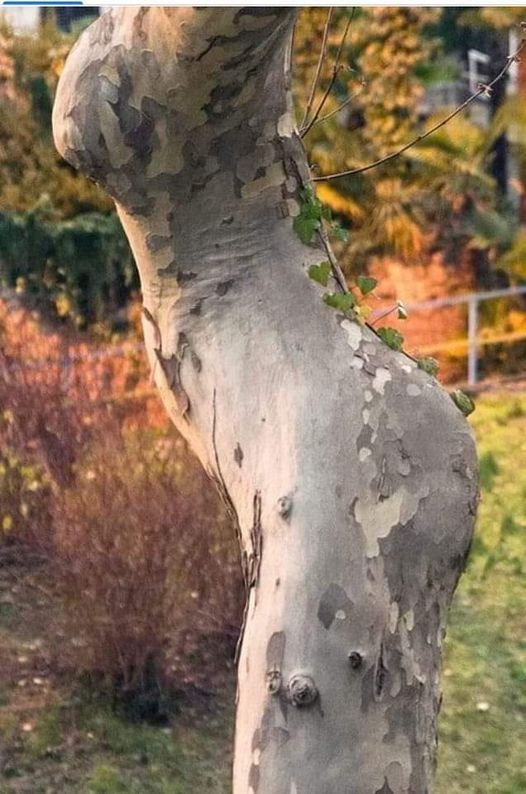
Another nice one is the “dragon tree” in North Carolina:
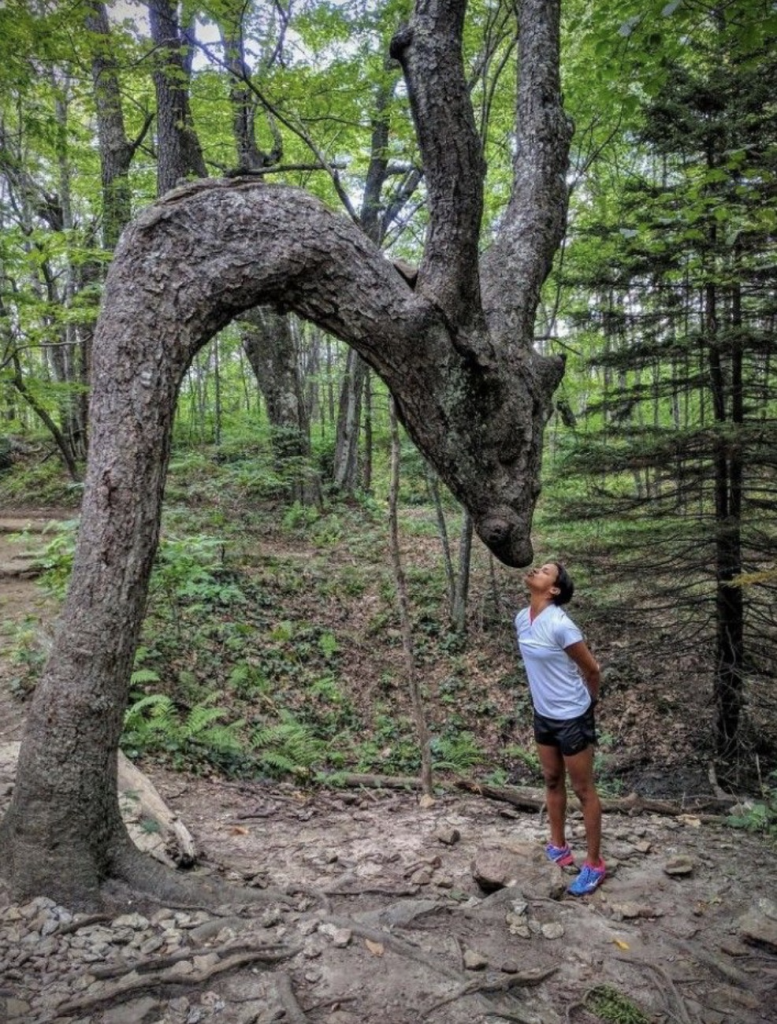
Thank you for reading
That’s it for this week! Please contact us with any feedback, question, or news item we’ve missed!

Runic Rants is an irregular series of thoughts, opinions, and experiments about RuneQuest.
Today I was nerd-sniped by a question on the BRP forums about the Glowline’s change from making it so that the Red Moon’s effect is always “full” (in RuneQuest 3) to always “half-full” (in HeroQuest and RuneQuest Glorantha)…
What’s the Glowline?
First, a bit of context: the Glowline is the geographical region under which the Red Moon’s light affects Lunar magic positively, and where Lunar citizens can always bask in the visible glory of the Red Goddess.
The Lunar Empire and most of its provinces are under its influence, and construction of additional Temples of the Reaching Moon extend this influence… when they’re not eaten by a big Brown Dragon rising from under them, that is (which is the inciting incident that kickstarts the 1625 timeline of the new RuneQuest Glorantha product line).
The Glowline Through the Editions
So I did a little archaeological digging about Lunar magic, Lunar cyclical effects, and the Glowline.
White Bear & Red Moon (1975) had the Glowline provide “Full Strength” to “cyclical Magicians”, and the Crimson Bat already had its own “wandering glowspot”. During the 80s, both RuneQuest 2 and 3 kept the full-strength of the Glowline with mentions in Cults of Terror (1981), Griffin Mountain (1981), and Gods of Glorantha (1985) among a couple others.
But although HeroQuest’s Sartar Companion (2010) also mentions a full-strength Glowline, I think it’s because it re-used the text from Cults of Terror for the Crimson Bat without a proper edit. As far as I can tell, the HeroWars and HeroQuest rulebooks (2000 and 2003) are the ones that introduced the concept of a Glowline that gives “neither bonus nor a penalty” to Lunar powers. According to the charts in these rulebooks, it corresponds to the half-moon phases. Pavis: Gateway to Adventure (2012) reiterates this statement of a half-moon moon inside the Glowline, which is then cemented in the Guide to Glorantha (2014).
The HeroWars and HeroQuest sourcebooks established another aspect of the Glowline, too:
Lunar worshippers who have learned the secret of their religion have an even greater connection to Sedenya. While within the Glowline, their Lunar magic is always boosted as if under a Full Moon. This
is a tremendous aid to the Empire when it defends itself from outsiders, and is one of the reasons for the great sense of security felt by Imperial citizens.
This creates a two-tier benefit for the Glowline: it acts as half-moon for Lunar cult initiates, but as full-moon for those who have “learned the secret of their religion”.
Our own Joerg posits that this “secret” might be a form of Illumination. I think it’s probably more about initiated into the Red Goddess’ cult, but being Illuminated is a prerequisite for it anyway, at least according to RuneQuest 3’s Gods of Glorantha. I guess we’ll know more when the Cults of Glorantha boxed set is released.
The “New” Glowline
Now if we put ourselves in the shoes of a designer who wanted to define Lunar magic for, say, an upcoming new version of RuneQuest firmly placed in Glorantha, we end up with a bit of a conundrum. We have a mix of texts saying that the Glowline gives “full strength” to Lunar magic, or that it acts as “full moon”, or that it gives “neither bonus nor a penalty”, or that it acts as “half moon”. Additionally, there are two existing RuneQuest rules on Lunar magic: one from Cults of Prax (1979) which has no lunar phase giving “neither bonus nor a penalty” (there’s either a limit on the size of Rune spells, or a boost on spell duration), and one from Gods of Glorantha (1985) which establishes half-moons as having no limits nor bonuses.
Given that Rune magic is a lot more powerful and freely available in HeroQuest, it makes sense to me that it introduced a two-tier approach to the Glowline, as mentioned earlier. It’s backwards compatible with White Bear & Red Moon, too, since that game was only concerned with elite Lunar sorcerer troops anyway. As Joerg says:
It can be safely assumed that all the units with cyclical phase in combat or magic would be ones initiated into the secrets of their respective Lunar denominations, hence the regiments receive full bonus.
One can even argue that it’s what RuneQuest 3’s Gods of Glorantha meant, since the text only mentions spells cast by “Lunar priests”, which would map to Rune Levels in RuneQuest Glorantha. As for Cults of Prax or Griffin Mountain, these were vastly unconcerned with the Glowline, being set in regions located outside of it, so… <shrug>?
With RuneQuest Glorantha also having freely available Rune Magic (not quite as much as HeroQuest, but much more than previous RuneQuest editions), and given Chaosium’s general stance that the Guide to Glorantha is the “ground truth”, I think it’s good that the latest edition went with what we have now for Lunar magic. That is: a Glowline that isn’t completely overpowered by default (it merely levels the playing field between Lunar Rune Magic and everybody else’s), but with some extra power for high-ranking Lunars.
Jeff gave his two cents on the topic:
Now [the Glowline] was [created] because Sheng Seleris quickly figured out that all he needed to do to beat Lunar armies was delay battle until the Dying/Black Moon phase and then use his superior mobility to force battle. Normally Lunar magic is only effective three days a week – Full Moon, Empty and Full Half Moons. Four days a week, Lunar magic is underpowered and two days a week it is effectively useless. The Glowline resolves a giant weakness in the Lunar magical system – which is powerful enough. It means that all of the time, all Lunar spells are available and freely stackable.

Funnily enough, the Glorantha Bestiary for RuneQuest Glorantha retained the old text from Cults of Terror: the entry for the Crimson Bat mentions that the Glowline makes the Red Moon always full… this text has travelled pretty far and wide! Like the Crimson Bat!
If you have any comment about this Runic Rant, or some ideas for a future installment, please send them to us!
Podcast: Play in new window | Download (18.2MB)
Subscribe: Apple Podcasts | Spotify | RSS | More

On this second episode of the Glorantha Initiation Series, we interview Russano Greenstripe.
Russsano discovered Glorantha with King of Dragon Pass, a game by A-Sharp, available on pretty much any platforms you’d want to play on.
If he could start a Gloranthan game, Russano would pick QuestWorlds as a ruleset. In the meantime, he has brought Eurmal to his in D&D game. We also discuss 13th Age: Glorantha, available from Chaosium. The core system is available from Pelgrane Press.
D’Aulaires Book of Greek Myths is available on Amazon and most probably in your friendly local bookstore.
The music album Carmen Miranda’s Ghost is on YouTube.
Information on Greg Stolze’s REIGN is available here, including access to PDFs and Print-on-Demand of the first edition. Information on GODLIKE is available from ArcDream. Unknown Armies is available from Atlas Games.
Visit the Wyvern’s Tale in North Carolina!
The (unofficial) Chaosium Discord is found here. The Cult of Chaos Discord is for members of the (free and easy to join) Cult of Chaos.
Archives of old Gloranthan discussions are on Tapatalk (such as here), but there’s also a lot on Chaosium’s Well of Daliath. The old mailing lists are archived here by a good Samaritan.
Podcast: Play in new window | Download (18.2MB)
Subscribe: Apple Podcasts | Spotify | RSS | More
Welcome to a new issue of the Journal of Runic Studies, the premier Malkioni publication for studies into the nature of Glorantha. If you haven’t subscribed yet, please consult with the spirit bound to the appropriate electronic page.
This is a short week: neither Jeff nor us wrote anything. But at least Jeff has an excuse: the week was dominated by the release of the latest RuneQuest book!
Chaosium News

Here are this week’s Chaosium news!
The RuneQuest Weapons & Equipment PDF it Out!
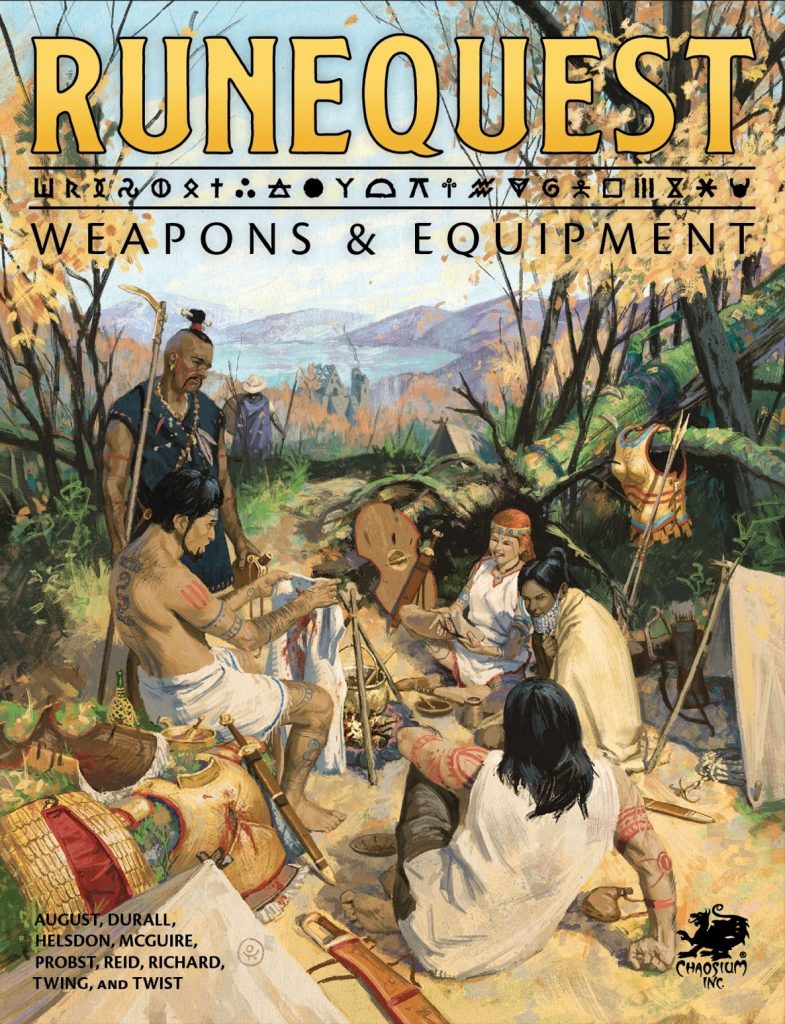
The Weapons & Equipment sourcebook for RuneQuest is out in PDF!
From the little I’ve read so far it’s a great addition to the RuneQuest line. Like the Bestiary before it, it’s a lot more than what you’d think at first glance. Both books are not just a list of creature or equipment stats because, in traditional Gloranthan fashion, they firmly anchor these creatures and items in the setting, providing extremely valuable world-building in the process. In particular, the Weapons & Equipment books provides much welcome information on the everyday life of the people of Dragon Pass. So if you’re not too interested in the book because you felt the rulebook was providing enough, know that there’s a lot more to it than extra tables of swords and shields!
Also, it feels like I spotted the Beer With Teeth mark in some of the more archeological flourishes of the text… I can tell, because I learned a whole bunch of new words!
ChaosiumCon Events

Chaosium has released a preliminary list of the events that will run during ChaosiumCon! Seminars, VIP game sessions, community content creator game sessions, an auction, a Gloranthan LARP, and more… this is exciting!
Also, ChaosiumCon is now accepting submissions for events!
In addition to Call of Cthulhu, RuneQuest, Pendragon and 7th Sea, we want everything from the entire history of Chaosium. Run that game of Stormbringer! Or run something new, such as Würm. Who has some decks of Mythos they want to play?
You just have to fill up a Google Form document to get started.
(Ludovic writing here) Note that if everything goes well (which often doesn’t these days…), I’ll be at ChaosiumCon. I hope some of you will come say hello!
Primers on Orlanth and Ernalda
Chaosium’s James Coquillat started a series of interviews with Jeff Richard on the deities of Glorantha. The first two videos are out, on Orlanth and Ernalda respectively. They’re great short primers that are appropriate to forward to some new RuneQuest players, for instance.
Elf Pack Manuscript Completed
Shannon Appelcline has completed his manuscript for the upcoming Aldryami sourcebook, currently called “Elf Pack” as a sort-of call back to the original “Trollpak” sourcebook.
That’s not the only reference to it since the manuscript is similarly divided into 3 section: “Book of Aldryami” (for creating and playing elves), “Aldryami Lore” (elf legends and history), and “Into the Woods” (elf adventures). The whole thing comes up to a whooping 137000 words, including a few funny extras, again like Trollpak:
I also wrote a few handouts that could go in a box, including elf poetry in “triku” (treeku?) form.
Shannon shared some information about the making of the book:
This is my third take on Gloranthan elves, one of the previous ones published (for MRQ), one not (for HQ). I am quite confident that it’s the best of the set. I was happy with my MRQ book, but it was written *very* quickly; while the unpublished HQ book was too big picture, making it more of a worldwide Guide than a gameable supplement. But this time, Jeff had defined a very gameable line for RQ:G, centered on Dragon Pass, so that ensured that my book would be very gameable too.
That also led me to writing my four goals for the book:
1. Depict an alien race
2. Create a fantastical sense of wonder
3. Make everything very playable
4. Make much of the material very local
Don’t get too excited yet though: the manuscript still need to go through editing, art direction, layout, and so on, so I don’t imagine we’ll see its printed dead tree pages until 2024 or something.
Jonstown Compendium

The Jonstown Compendium is Chaosium’s community content program for all Gloranthan games, hosted on DriveThruRPG. Disclaimer: all the relevant links are affiliate links that hopefully will let us cover some of the hosting and maintenance costs for the website and podcast! Thanks for using them!
Secrets of HeroQuest is Available in POD
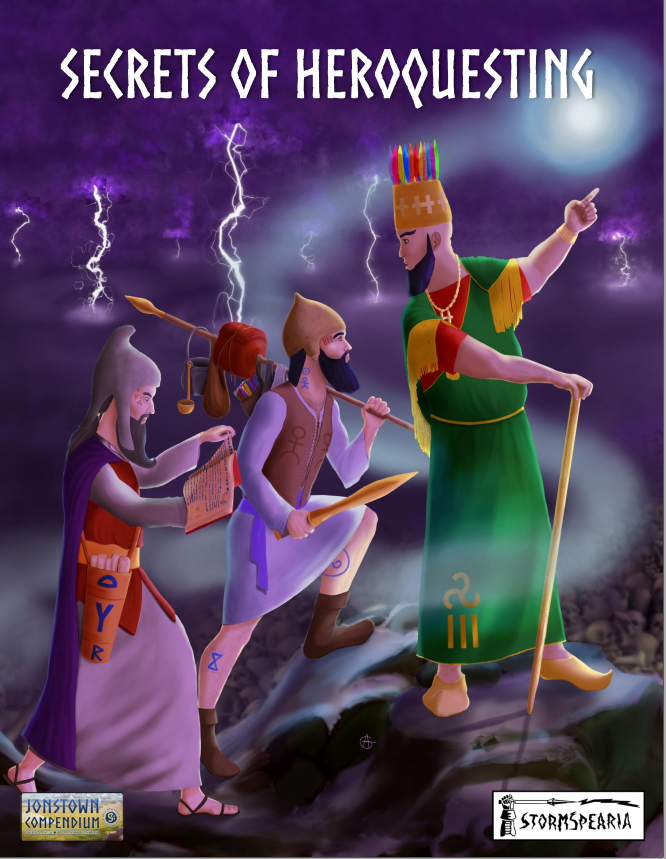
Simon Phipp’s Secrets of HeroQuesting is now available in hardcover on DriveThruRPG. The book gives you Simon’s, err, secrets on, err, heroquesting.
The Seven Tailed Wolf is Coming
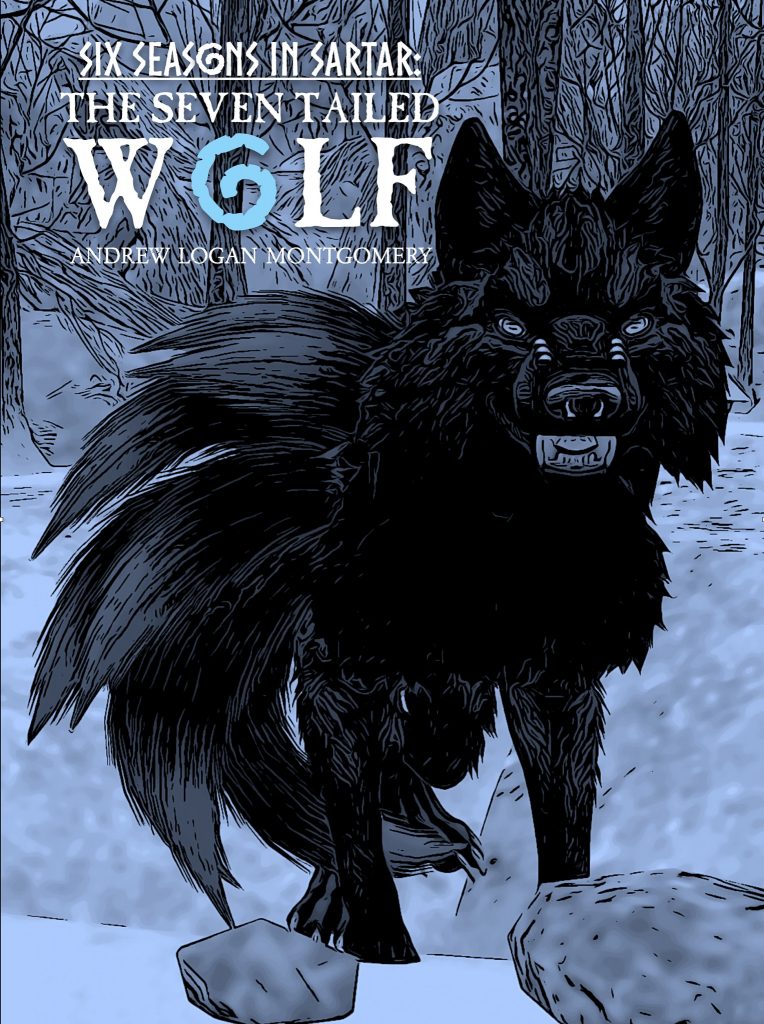
Andrew Logan Montgomery is teasing the third instalment in the Haraborn series, after Six Seasons in Sartar and Company of the Dragon. It features adventures for the surviving members of the Haraborn clan who come back once again to their lands, plus some material originally intended for the first two books that was cut for space.
Community Roundup
The community roundup is our highlight of interesting things being mentioned in the Glorantha-related Facebook groups, sub-Reddits, and other similar online places.
Teasing the Periplus of Southern Genertela
Martin Helsdon (of the Armies & Enemies of Dragon Pass fame) has been writing a “Periplus of Southern Genertela”, a half-fiction, half-fake-archeological-item where the narrator travels around the Holy Country and beyond, telling of their travels and encounters. He was posting them on Facebook at first but it quickly grew too big for that. So he has made a book, and recently commissioned Katrin Dirim to illustrate it. Here’s a sneak peek, courtesy of Fenris Games:
It’s unclear where that book will be available from, though: the rules of the Jonstown Compendium exclude the possibility of publishing non-gaming material such as pure fiction.
Weapons & Equipment Reviews
Some people apparently read a LOT faster than me, or just, you know, have a lot more free time to dedicate to reading RPG books. Probably a mix of both… lucky bastards. But anyway, sure enough, the new RuneQuest book has a few reviews already available, in case my little blurb up there didn’t convince you.
Andrew Logan Montgomery (of Six Seasons in Sartar‘s fame) does a good overview of the book’s contents, with a sprinkle of his opinion on the book:
Look, it is easy to call anyone of these titles “indispensable.” The Red Book of Magic is the “indispensable” guide to spirit and Rune magic, the Glorantha Bestiary is the “indispensable” book of Gloranthan monsters, beasts, and Elder Races. But Weapons & Equipment is different. GMs and players should both want to have this, because even just reading random sections of it, Glorantha springs to life. It is like going from 2 to 3D.
RPG Imaginings already has a video, too:
On Twitter, he says:
RuneQuest’s new Weapons and Equipment supplement deftly avoids one of my biggest gripes in fantasy TTRPGs: it is not about bigger numbers for your hit-point smasher. Chaosium’s RuneQuest stands apart by putting culture and setting first.
Weaving Stories in RuneQuest
SkullDixon has a lengthy but very interesting play report over on his blog, titled “Baboons in the Apple Orchard“. He frames it as what to do during downtime, but the interesting bits for me were how he’s effectively weaving multiple storylines into his game (the original Apple Lane scenario, the new Apple Lane setting, the HeroWars “meta-plot”, including the upcoming Battle of Dangerford, and so on), and how he’s playing with time-frames with (that is: it’s not so much “what we do during downtime” for me and more “let’s fast-forward by a day or two here and there and let the story unfold over a longer time frame“, which is something I like doing occasionally).
Non-Violent Characters in RuneQuest
The Beer With Teeth blog is getting a lot of posts (you have to wonder if Diana has time for her day job anymore), but one that stood out was the collection of notes on creating and playing a non-violent character in RuneQuest. I’m looking forward to more notes from Xenofos about Lenta!
Citadel Miniatures Trolls
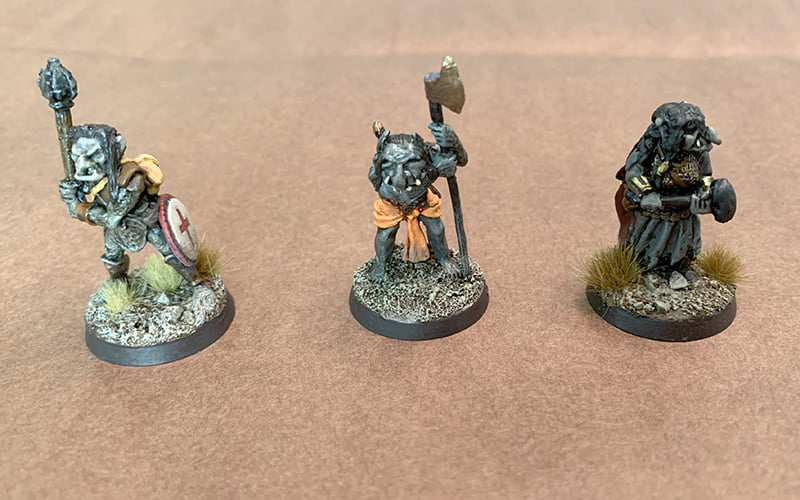
Here are some lovely painted troll miniatures from back in the RuneQuest 2 days when the trolls had a folk-ish “old witch” sort of look, courtesy of Phil Leedell.
Phil also showed his great painting skills by reproducing one of the shield designs from the RuneQuest Starter Set’s SoloQuest cover:

Esrolian Militia Miniatures

And here are some more miniatures, this time thanks to George Maczugowski. It’s an Esrolian Town Militia with “snazzy goose motif shields“!
Elsewhere on Arachne Solara’s Web
Not everything is about Glorantha, although most things are! Here are loosely relevant things that we found on the interwebs.
Where to Build Your Village
This is a great video for worldbuilding. Andrew Millison is a permaculture instructor, and what he says here can be used to put your Sartarite hamlets and towns in believable places, with building shapes, orientations, and distributions that make sense. There’s even a “fluvial geomorphology” aside that might give you ideas for how correctly placating the local naiad can affect the landscape and people (including the ability to not place your village “where it makes sense”!)
Thank you for reading
That’s it for this week! Please contact us with any feedback, question, or news item we’ve missed!
Welcome to a new issue of the Journal of Runic Studies, the premier Malkioni publication for studies into the nature of Glorantha. If you haven’t subscribed yet, please consult with the spirit bound to the appropriate electronic page.
God Learner Sorcery

We are now occupying a nice little tower with a long history of previous occupants who have left behind documents, tablets, artifacts, and other kinds of junk. As we clean up and archive these things, we share the most interesting ones with you.
Episode 6: Gamemastering RuneQuest
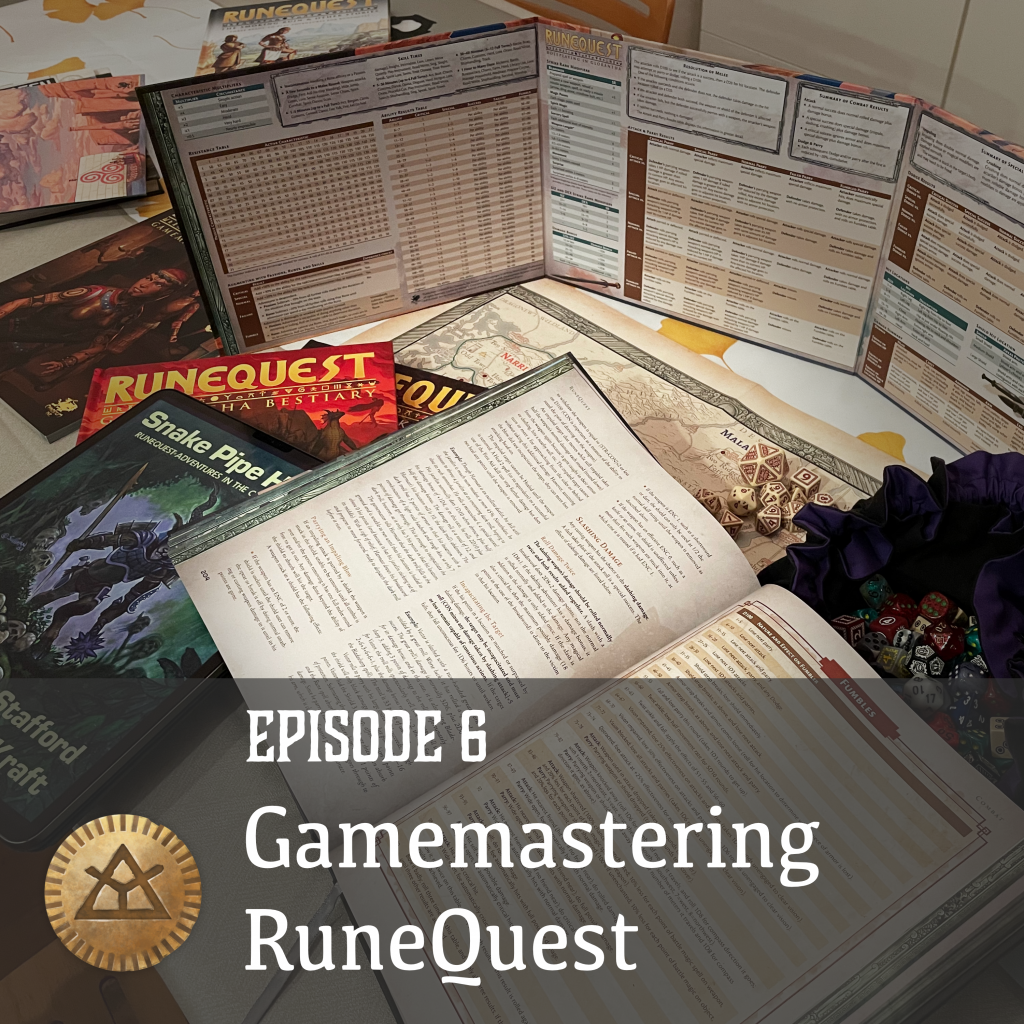
We have released a new episode of our podcast! We are joined by Jonstown Compendium authors Neil Gibson and Jon Webb to talk about the art of gamemastering RuneQuest Glorantha (although a lot of the discussion is generally applicable to many other RPGs). We discuss various tips and tricks to handle the system’s complexity, speed up combat, share game anecdotes, and generally agree on too much stuff…
Runic Rants: When You Don’t Know
Speaking of gamemastering, here’s a bunch of advice for GMs who are somewhat new to Glorantha:
[…] Start small, keep it simple, and so on. Between the fabulous Quickstart adventure, the excellent Gamemaster Screen Adventures book, and the great new Starter Set, you should have everything you need.
But Glorantha is a big and complicated setting, and as a gamemaster you’re bound to make “mistakes”, or get stuck with something you don’t know. Here’s some advice on that, from my short past couple years of RuneQuest.
It’s all in the article!
Chaosium News

Here are this week’s Chaosium news!
RuneQuest “All Stars” Game
The Brian Holland-led Starter Set adventure playthrough is now up on YouTube after having been streamed live last week. I haven’t watched it yet so I’ve got no comments on it… maybe next week!
ENWorld Interviews MOB

RPG news outfit ENWorld has an interview of Michael O’Brien on the topic of the upcoming ChaosiumCon. It mostly repeats the information you might have already read via Chaosium’s own channels, but with a sprinkle of extra anecdotes.
Jonstown Compendium

The Jonstown Compendium is Chaosium’s community content program for all Gloranthan games, hosted on DriveThruRPG. Disclaimer: all the relevant links are affiliate links that hopefully will let us cover some of the hosting and maintenance costs for the website and podcast! Thanks for using them!
A History of Malkionism
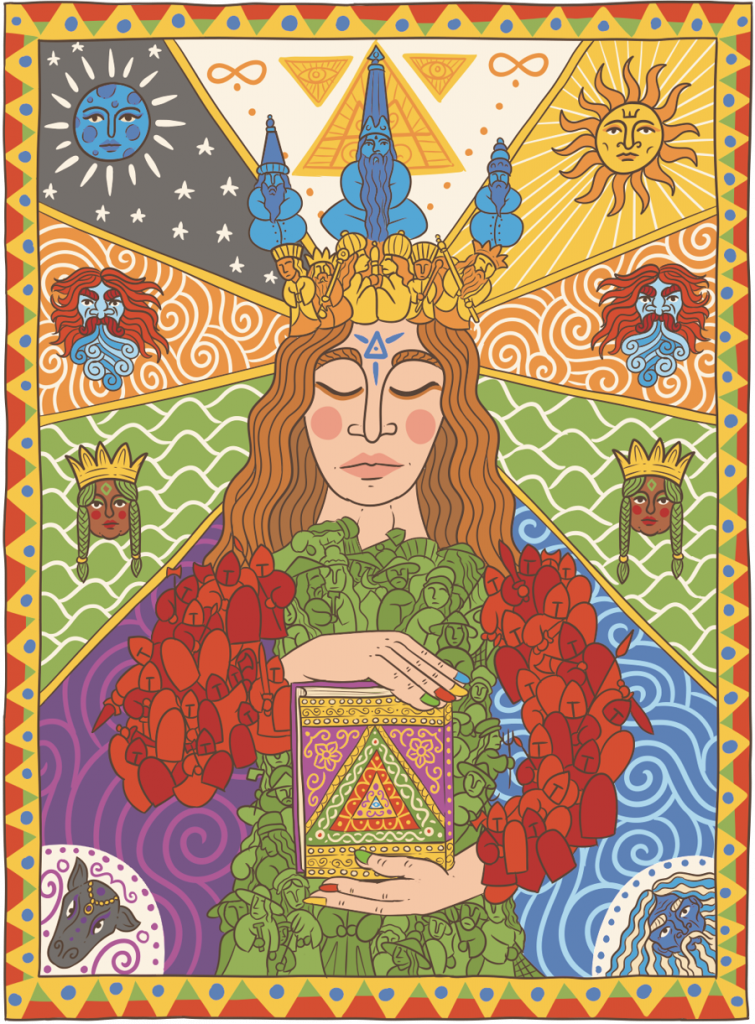
Nick Brooke released some more out-of-print material, with some new illustrations by the awesome Katrin Dirim. It’s A History of Malkionism, which details parts of Western Genertela, including the Brithini, the Waertagi, and the Vadeli.
A Site to Die For
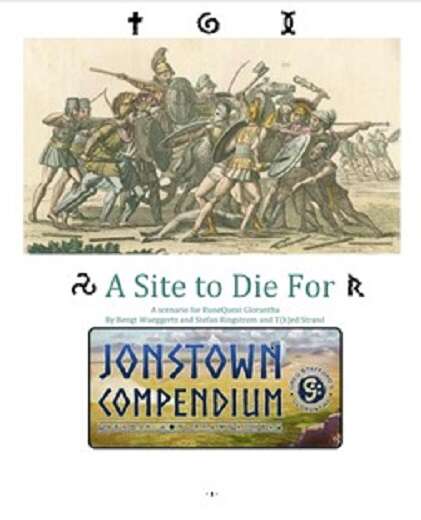
Here’s a new release from some new names, as far as I can tell. A Site to Die For is an adventure where your players will protect a week-long ceremony to consecrate a shrine to a Greydog Clan hero. Of course, there will be several enemies to defend against… and if your players are not playing in the Greydog Clan, you might be able to repurpose this book as something they can attack!
Six Seasons in Sartar Reaches Platinium Level
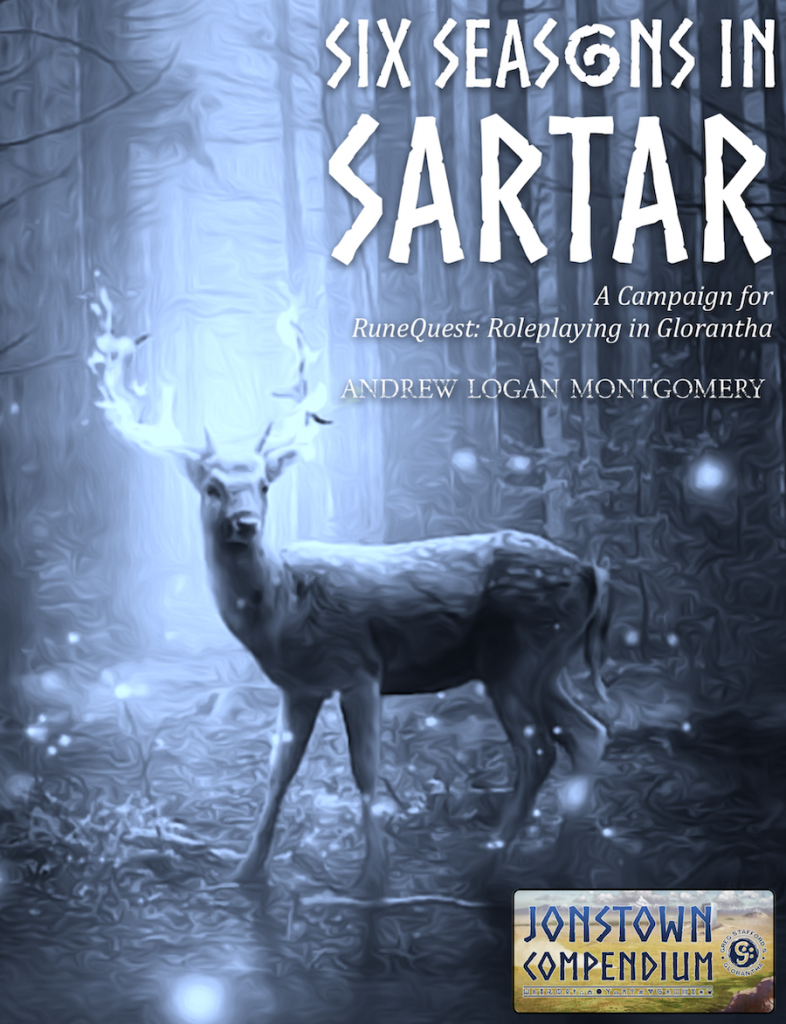
Six Seasons in Sartar is the first Jonstown Compendium title to reach Platinium Level! This means more than 1000 sales, which only less than 1.5% of all titles in DriveThruRPG (including “professional” titles) ever reach. Congratulations Andrew!
Nick Brooke on the Armies & Enemies of Dragon Pass
Still now sure about getting that big book? Nick Brooke goes over everything that’s inside to get you all hyped! Plus, some answers to common questions such as “why isn’t there a colour print edition?“
Jonstown Compendium Sales Analysis
The ever productive Nick Brooke (does he ever sleep?) has an in-depth analysis of the Jonstown Compendium sales over on BRP Central and on the Chaosium blog. It includes pretty graphs, and you know I like pretty graphs as much as I like pretty maps.
There isn’t too much surprising data in there (although I like seeing how crazy Black Spear sold from the start!), but Nick always has some good conclusions to help Jonstown Compendium authors prepare, publish, and price their works. He was definitely a great pick as “embassador” for Chaosium.
Jeff’s Notes

Jeff Richard, the current mastermind on everything Gloranthan at Chaosium, is often posting notes and thoughts on the RuneQuest Facebook group. Here’s our curated list from the past week. A partial archive of these sources is compiled on the Well of Daliath.
The Spread of Grains
You guys know by now that I love maps, right? Well check this out:
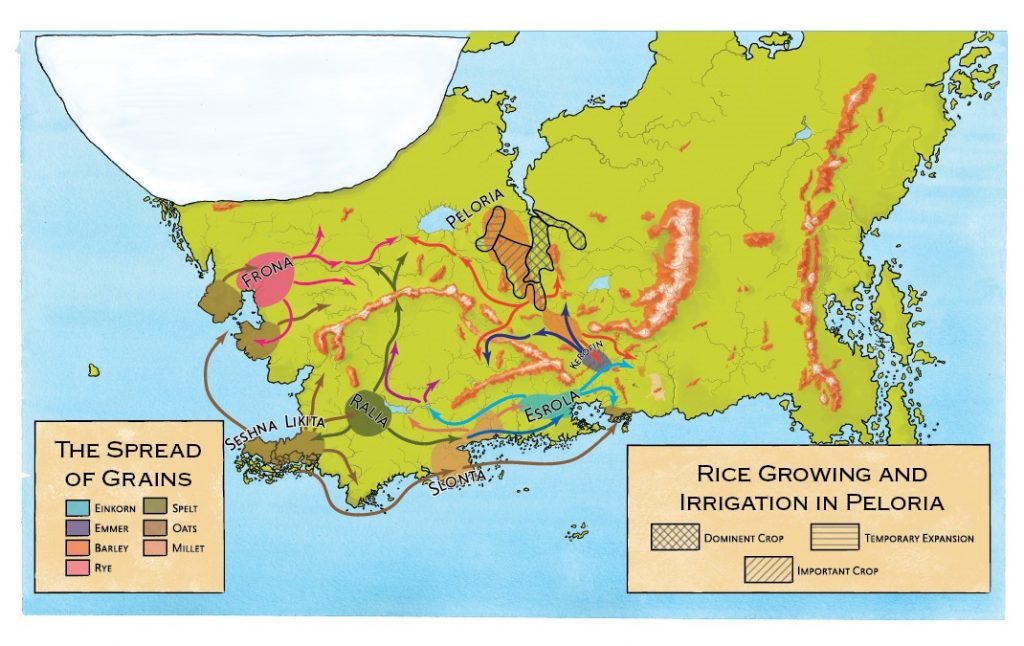
This is a work in progress map showing the spread of grains across Genertela. If you’re an ESL person and/or not very knowledgeable about agriculture (I’m both!), Jeff had previously posted about the different types of fields (thanks 7Tigers!):
- Einkorn Wheat: “This cereal grain is relatively short, usually less than 70 centimeters tall. It can survive on poor, dry, marginal soils where other varieties of wheat will not.“
- Emmer Wheat: “This awned cereal grain gives good yields on poor soils.“
- Barley: “This cereal grain is a highly resilient crop, able to be grown in varied and marginal environments. It has a short growing season and is relatively drought tolerant.“
- Rye: “This cereal grain grows better than any other cereal on heavy clay and light sandy and infertile or drought-affected soils.“
- Spelt: “This husked wheat is adaptable to cold climates and is easy to store.“
- Oat: “This cereal grain is eaten chiefly as porridge. Oats are cold-tolerant and are unaffected by late frosts or snow.“
- Millet: “This annual grass is grown as a cereal grain. It can reach a height of 120 to 200 cm. It is well adapted to drought, low soil fertility, and high temperature.“
Matt is still working on it (colours will be tweaked and typos fixed, don’t freak out!) so at this point I’m not sure how to read it yet. As far as I can tell each land goddesses has a “special” grain, which you can use in any heroquest involving the Flamal the Father of Seeds’ various unions with these deities. Imports and exports seems mostly balanced, except for Esrolia where it looks like they’re exporting more than they’re importing. This doesn’t necessarily translate to actual trade of goods, but it might be a factor for that country’s wealth.
Prax and The Wastes
And another map! Yay! This one is on Prax and the Wastes, with the green cross-hatching showing the fertile grounds:
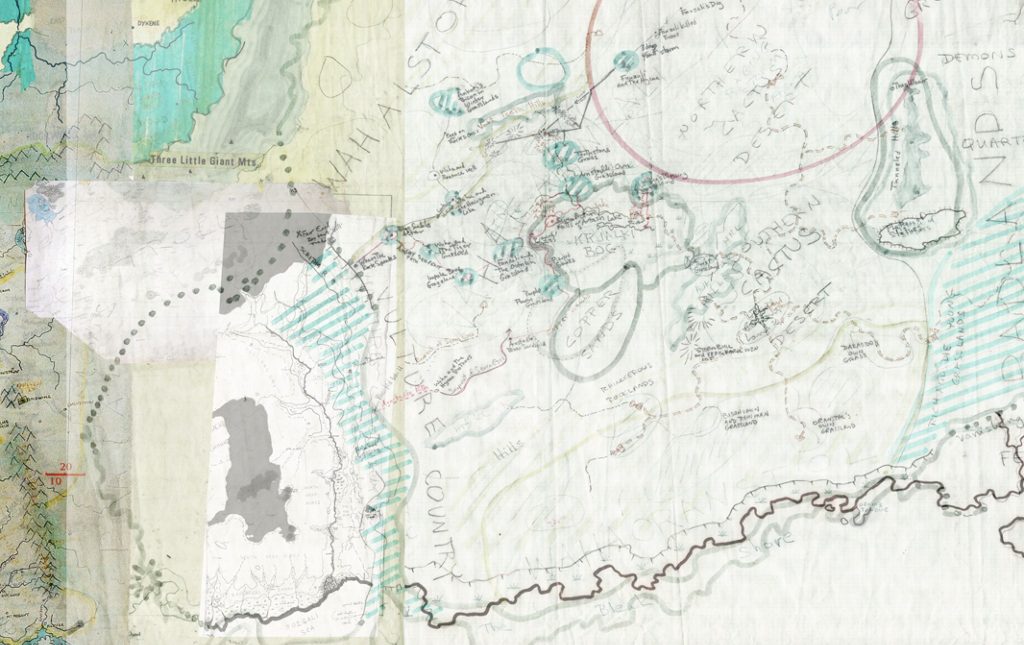
As far as most settled people are concerned, all of the Wastes are basically like Vulture Country – inhospitable to man and beast, with terrible dust storms (worst are those from the Copper Sands), and populated by broo, scorpion men, and other monsters.
But the Praxians know how to survive in the Wastes – Waha shows them the way. It is harsher and more demanding than fertile Prax, but herds can move from grassland to grassland protected by the nomads. Gods and spirits walk the Wastes – it was in the Wastes that Jaldon Goldentooth became a Hero. And it is there in the Wastes that Storm Bull defends the corrupted corpse of his friend and liege Genert.
If you’re simple-minded like me, your original understanding of the Praxian tribes might have been that Waha’s way was about surviving in Prax. Because they’re called “Praxian tribes”?
Well apparently not. Based on previous material shared by David Scott, it seems the Praxians spend most of their time in the Wastes:
During the Lunar Occupation, many Praxians exiled themselves to the Wastes. Many joined the White Bull Society, which began in the Wastes. Now they are returning to Prax at Argrath White Bull’s invitation, and they are making preparations for the Final War against Chaos.
And if you want maps of grazing regions in Prax, David Scott has you covered (there’s more in the next pages in the thread).
Note that the Praxian tribes being in the Wastes isn’t new to the Lunar Occupation. They’ve gone there many times, such as during the Second Age when the Pure Horse People invaded Prax. At some point, they also expanded northwards:
After the Dragonkill War and the closing of Dragon Pass, the Animal Nomads entered into a period of comparative calm and growth. Their intertribal warfare continued, often disintegrated into inter-clan fighting in the Genertelan Wastes. Yet they prospered, relieved at last of the troublesome influence of the civilizations in Dragon Pass. Minor adventures in the Holy Country, Kralorela, and Teshnos were viewed with alarm from the inhabitants of those regions, but their retaliatory raids failed to do long-lasting damage to the Animal Nomads. It is probably fortunate for those regions that the ancient ancestral grudge against the Horse Barbarians of Pent was greater than their lust from the luxuries of civilization.
Cut off from other areas of expansion the nomads expanded northward into Pent. This was a gradual process of many generations, yet proved inexorable. Both the Animal Nomads and the Horse Barbarians have stories about the famous battle of No-Feet-on-the-Ground, where even the sun and storm took part so that the earth itself recoiled and withdrew from contact with the battle. Its date is uncertain, and the multitude of conflicting information makes a sensible recollection impossible. Regardless, the battle was a disaster of immense proportions for the Horse Barbarians. They were split into East and West divisions, and reeling into civilized lands in the north. Their arrival in Peloria was during the Lunar Third Wane.
I actually much prefer these nomads being out the Wastes, personally. One thing I was bothered with when I started with Glorantha was how small Prax is for all these nomadic tribes… the size of the Wastes makes more sense to me.
Associated Deities
Jeff has some information on associated cults, and how much cross-pollination there is with priests and initiates of one cult participating in rituals of another:
For example. Ernalda’s husband deity participates in many of her mysteries – Orlanth in Sartar, Yelm in parts of Saird, etc. The Orlanth initiates gain access to some of Ernalda’s magic (but using Orlanth’s Rune points) and Ernalda gets their sacrifices and magic points.
I think we can see this in the White Bull campaign where a lot of the adventurers are at least lay members of several other cults, participating in their worship and getting Rune Points back by association. This shouldn’t be underestimated in a RuneQuest campaign, and only Humakt gets the short end of the stick, having no associated cults. Everybody else in the general Lightbringer pantheon has several associations. This is why Orlanth and Ernalda are so much more powerful as a cult choice.
Lunar Nobility
Jeff notes that there are many powerful families (or clans) surrounding the Red Emperor, all of which have some sort of kinship (distant or direct) to him. I’d love to play with this kind of court intrigue and imperial spycraft personally… Anyway, when you build Lunar patrons or villains for your campaign, make note of this:
Those “born in the red” are of course superior to those born while the mask was a mere mortal, although I have heard convincing speculation that only daughters are ever born in the red (Hwarin Dalthippa, Hon-eel, Jar-eel, etc.) but that might just be the murkiness of imperial genealogy. That being said, I am unaware of any confirmed son of Moonson.
The Silver Shadow Satrapy is filled with these imperial kin, but most Dara Happan nobles now claim at least some kinship with Moonson. Being descended from Moonson means that you are but a few generations from divinity and can claim descent from both the Red Goddess and Yelm!
Some of the most powerful clans are presented in the Guide. They include the satrapal clans like the Eel-arish and the Taran-il, think of these like daimyo clans in Imperial Japan. They are related, but conspire against each other, raise private armies, and fight with each other through assassination and secret wars. They are focused on the real prize, of course, and that is control of the Red Emperor and domination of the Lunar Empire itself.
“Satrapal clans” are family-run divisions of the Lunar Heartleands (as opposed to the Lunar Provinces).
The Daimyo were the classic feudal lords you see in the most popular stories set in Medieval Japan. They were subordinate to the Shoguns, and then to the Emperor (I’m not sure who the Shogun-equivalents would be in the Lunar Empire). If you’ve seen or heard any story set in, say, the Edo period, with samurai and ronins and all that cool stuff, think of the often complicated politics between regional lords always bickering and plotting among each other… like I said, I’d love to play in there!
Chaotic Features in the Lunar Empire
While we’re dealing with the Lunar Empire, how about a side-order of Chaos?
The Red Book of Magic had already hinted that the Red Goddess cult has access to the Chaos Gift spell, which grants someone with a Chaos Feature (temporarily) and a Chaos Rune affinity (permanently). Jeff also shared that this spell is granted (through cult associations, I assume) to senior priestesses of the Seven Mothers, and to several individual cults of these deities.
So let’s assume somewhere less than 1% of the Lunar population is tainted by Chaos, but that percentage is primarily in the ruling class or its henchmen.
Remember that a Chaos feature is much more than just a cool power – it is something that warps and mutates the recipient. Often it results in mutated horrors, but even when beneficial the results can be inhuman. People with features too smooth, uncanny valleys, exaggerated or grotesque body parts, and so on. But also those gifted have the sensation of wielding blasphemous power ripped out of the cosmos.
Now 99% of the population have never experienced Chaos Gift, but that less than 1% are tainted by the experience. Many are Illuminated, but many are not. Needless to say this likely has some cultural effect.
My own take on this “cultural effect” is that, depending on the place, the ruling class people would be seen either as perfect superior humans, alien creatures, horrible monsters to be feared, and so on. This would foster a different views and opinions on the difference between the leaders of the Empire, and the ideals of the Empire. There’s some interesting stuff to explore there.
Trading in Genertela
Genertela was not having a great time between the Closing of the Oceans (in the mid-900s) and the end of the Dragonkill War (in the mid 1100s).
[…] trade (and thus urban civilization) was minimal. Ralios and the Holy Country had contact through the Manirian Road – a series of caravans that went from Esrolia to Safelster and Tanisor.
Peloria was cut off from the south and Ralios, and had only the long river route down the Janube to Sog City. This route was controlled by the Carmanian Empire, but its long distance made it very expensive and slow.
It’s the founding of the Kingdom of Sartar (in 1492) that brought high-volume trade between the other main parts of the continent, especially as they build many roads and inns.
The Holy Country and Sartar grew wealthy hand in hand, and trade and cultural connections grew even stronger.
When the Opening took place in the 1580s, this became supercharged. Trade with the whole world became possible through the Holy Country, and spices, herbs, silks, and other exotic luxuries came across Dragon Pass into the Lunar Empire. The Lunar nobility greedily bought whatever luxuries they could, and coveted the great riches they brought the rulers of Sartar and the Holy Country.
In a follow-up post, Jeff expanded on the topic of trading, using silk as an example:
Silk is something found among the elites in the Heartland, in Lunar Tarsh, in Boldhome, and is quite common in Nochet, Rhigos, and Karse. Assuming the Lunar Empire has roughly the same level of elite access to silk as the later Roman Empire, it needs about 5 or 6 tons of silk per year.
Jeff then goes with some quick math. Let’s assume that Kralorela exports 10 tons of silk per year by ship through the Holy Country, and 6 tons of silk per year to the Kingdrom of Ignorance “to keep them quiet” (the Kingdrom of Ignorance used to be a great troll kingdom, and is now a decadent land ruled by “malignant humans who worship gods which would be best forgotten“).
The Holy Country keeps half the silk going through their ports, and the rest travels from Karse on northbound caravans. The Sartarite elite takes 1 ton of it as it passes through their lands, which is “enough silk for 800 silk tunics or 1600 silk dresses“. The Kingdom of Ignorance passes 2 tons of silk onto the Red-Haired Caravan (which I assume is a collective of merchants from the Red Hair Tribe of Pent) which also brings it to Peloria.
So that’s how the Lunar Empire gets their 6 tons of silk per year to keep the elite exquisitely clothed.
In theory, you could put that all in one big silk caravan, but of course it isn’t. Each caravan might have one mule with silk – but that still is enough for about 60 silk tunics, which is going to be a good return!
As an aside, if you’re wondering about spidersilk:
I suspect there is far more spidersilk produced in Dagori Inkarth (held to be superior for making of ropes and threads than the silkworm silk of Kralorela and Teshnos) than from [the Kingdom of] Ignorance. But it is also produced in much smaller amounts, coming only from the Aranea Cult.
Spidersilk is therefore more expensive, and first used by trolls for more practical things than fancy pajamas. If you like danger, you could try to start a new trade route starting from the Spiderwoods of Dorastor…
Anyway, now expand this trade volume to the “900 tons of goods that gets sent each year up from the Holy Country to Furthest“. Jeff does exactly that but his math didn’t seem to line up — I’m pretty sure it was just a typo in the first number, but I also figured it would be fun to do it myself! I’m also approaching it from a different methodology here.
A mule can apparently carry about 90kgs on average. That’s about 10000 mules a year passing through Sartar from the Holy Country to Peloria. Jeff splits them among 25 huge, large, and medium caravans. I’m going to tweak his numbers and say that a “huge” caravan is 1000 mules, a large one is 500 mules, and a medium one is 100 mules. This gives a split that’s very close to Jeff’s, with 4, 10, and 10 respectively of these caravans, for a total of 24 caravans moving northward along the King’s Roads.
If you consider a fixed point along those roads like, say, Jonstown, that’s one caravan passing through every two weeks. Jeff’s math comes up at one caravan passing through every two days, though… which would be possible in my model but with smaller caravans. But I figure that large caravans might stop at cities like Jonstown for a few days anyway. And if you add a similar trade volume coming the other way (from Peloria to the Holy Country), plus a smaller volume from Prax, we would indeed reach Jeff’s conclusion of one caravan every couple days.
These caravans are the life blood of the Kingdom of Sartar, and so keep that in mind when you think about the economics of the kingdom.
This is part of that big explosion in trade following the Opening – which interestingly is about the time the Red Emperor takes a personal interest in Dragon Pass.
Dawn Age Wenelia
How about some notes on Wenelia and the Pralori Elk People, which I frankly didn’t know much about until now?
First, let’s check out the Wenelia map from the Argan Argar Atlas:
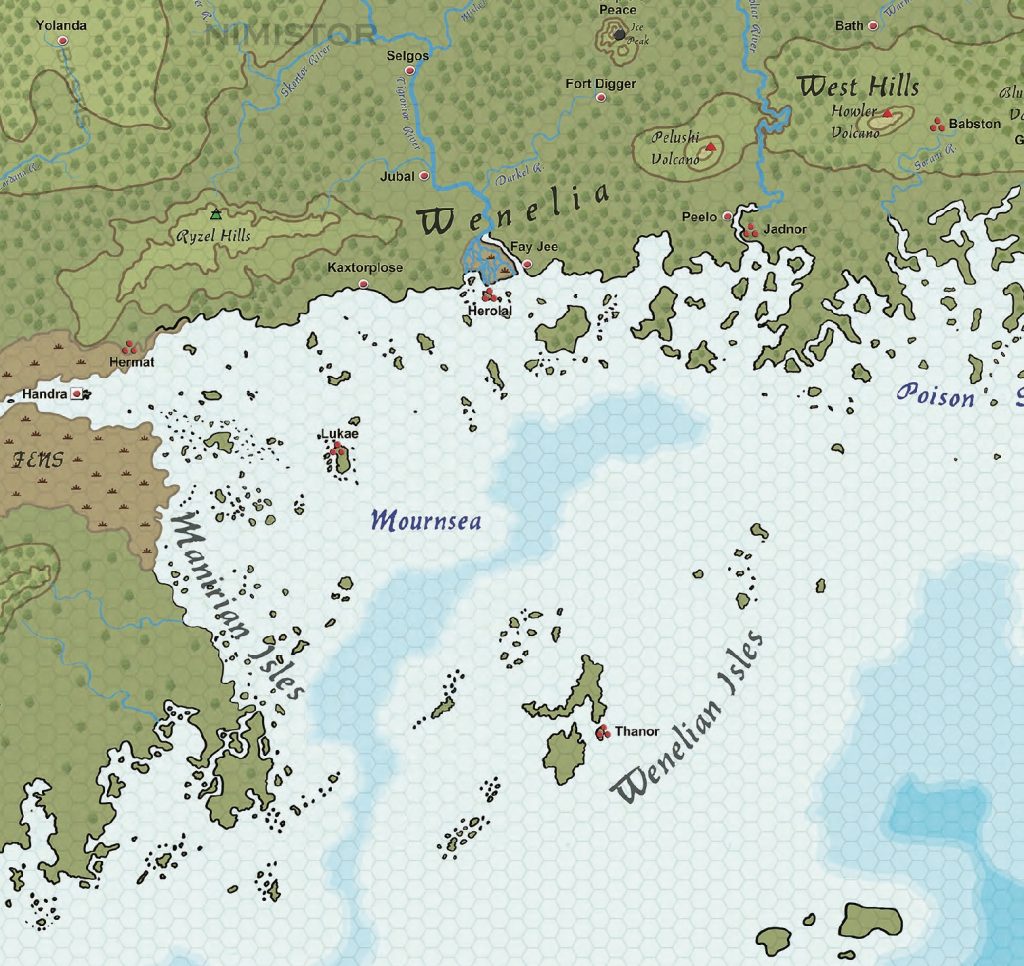
Wenelia is located between Maniria and the Holy Country, on the southern coast of Genertela. See these Wenelian Isles? There used to be a peninsula there, along with some bigger islands, before Slontos was sunk as part of the general cosmic backlash against the God Learners (which also sunk Jrustela and Seshnela, and Closed the Oceans). There’s a map of what it looked like in the Guide, but Jeff also shared his own historical map:
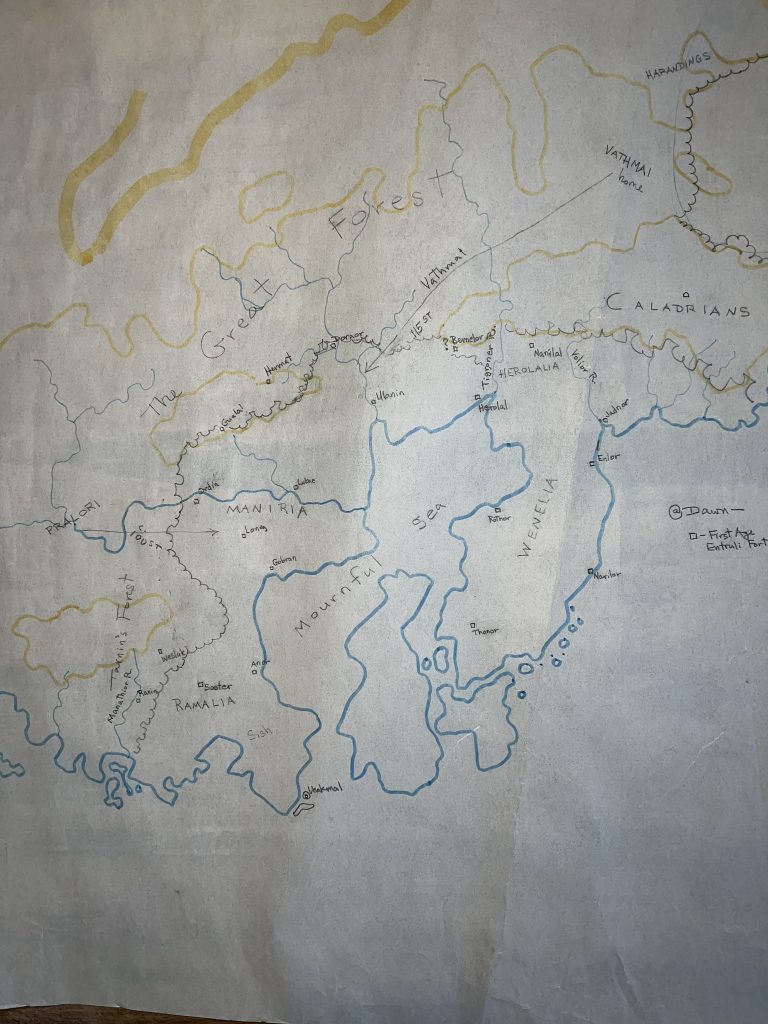
So anyway the Pralori Elk People used to live here in Wenelia at the Dawn. These are Hsunchen people, so when we say they’re “elk people” we really mean it: they shapeshift into elks. They also tend to be more primitive than the cultures of Dragon Pass.
The traditional foes lived to the south and were called the Entruli. These were a branch of the Mraloti, or boar-folk, who had survived the Darkness in relative strength and delivered their civilization to their cousins after the sun rose. Thus, the Entruli ruled all of the peoples to the south.
So these people are fighting all the time like it’s still the Great Darkness, until:
In the year 97, the Entruli did what the Pralori could never do. Their ruler broke an ancient taboo which angered the gods. A great flood came rushing upon the land, drowning everything in its way and destroying the land. Only the capital, Porluftha, escaped because a Kolat clung madly to the buildings and held firm as the water washed over him. The city and its ancient inhabitants were preserved in a great air bubble undersea, lost to the outside world, undiscovered for many years.
I haven’t seen any references to this before, including a town called Porluftha, but according to the Guide the Mournful Sea (or Mournsea in the first modern map) used to be called Porluftan Sea! I guess we know where this underwater city roughly is…
Going back to the story, the Entruli and Pralori were still plundering each other, this time with the Pralori having the upper hand, but the Entruli got a break:
[…] there came a leader who was related to the old Entruli dynasty. He and his tribe came from the Shadowlands, where the Only Old One ruled over a nation of trolls and subject populations. A time had come when the Only Old One offered many of his subjects their freedom if they left his lands, or else commanded them to accept his rule.
This leader was Lalmor, of the Vathmai tribe. With the help of Aram Ya-Udram (whose descendants the Aramites, fun fact, became the hated Tusk Riders), he:
[…] united the Entruli, helped them rebuild their strongholds, and led them to a great victory in driving off the Pralori. He arrived in 115, was finished with his victories by 122, and died in 138.
King Lalmor’s arrival was more than simply a unification of the Entruli peoples. He brought a new religion with him, and he was also aided by many inhuman peoples. Lalmor came from Dragon Pass, where the Unity Council had been formed and where they worshiped the world-saving Lightbringers. Lalmor brought worship of Orlanth and his pantheon. With these new cults he was clearly ascendant.
So this is really the detailed story behind the Guide’s shorter account: “The people of Slontos were liberated from Pralori oppression in 115 by Lalmor of the Vathmai, a Theyalan tribe“. Shows you how much room you have to spin
After that the Theyelan missionaries spread from Entruli lands to meet the Pralori, who apparently received them well:
The Pralori recognized the superiority of the new gods over their own animistic spirits. It did not unify the tribe, nor did it split it.
The Lightbringers faith did not ensure the unity of the Entruli. After the death of Lalmor in 138 the Entruli heirs divided his lands into several kingdoms. Some were coastal and thrived upon the increasing sea-trade borne by the ship-living Waertagi race which ruled the surface waters. Some were buffer states between the coastal cities and the inland barbarians. Others were barbarian kingdoms living in woods and plains.
My mind immediately tries to find the connection between the aforementioned sunken city and the Waertagi. Is there already some material I have missed?
Community Roundup
The community roundup is our highlight of interesting things being mentioned in the Glorantha-related Facebook groups, sub-Reddits, and other similar online places.
RPG Imaginings Reviews the Starter Set
What it says on the tin: the RPG Imaginings channel, which fans of Call of Cthulhu would know very well, does a review of the RuneQuest Starter Set.
Andrew Logan Montgomery Interviews Claudia Loroff
The author of the aforementioned Six Seasons in Sartar has a nice treat for us on his blog: an interview with Claudia Loroff, who worked among other things on rewording and revamping the female-oriented cults in RuneQuest Glorantha. She’s also Jeff’s wife, by the way, and you can see her playing a Ty Kora Tek initiate in the White Bull Campaign stream.
The interview is mostly focused on the role of Ernalda, her cult, and her initiates, both in Glorantha itself and in gaming.
To make a long story short – your Ernaldan in your adventurer’s group is usually the key to get people to trust you and get their support. She can be very convincing, and her parties are legendary.
At the same time, we had to make sure that she can be a real threat in a battle. An Earth Elemental is not funny and commanding swine can make the life of Tusk Riders very difficult.
The whole interview is very interesting, including the origin of the pre-generated character Yanioth, how to deal with sex, pregnancy, and sacrifices in your campaign, and more!
Greg Stafford’s White Dwarf Interview
Do you read the GROGNARDIA blog yet? No? You should! It’s great!

James Maliszewski recently published an article about White Dwarf #17 (1980) which features a very interesting interview of Greg Stafford. There’s a lot of interesting stuff, such as what Greg had in mind when he created the main figures of the Hero Wars, how to pronounce White Bear & Red Moon’s acronym WB&RM, or what is the appeal of RPGs. Go check it out!
DiceBreaker’s Great RPGs That Aren’t D&D
DiceBreaker released a follow-up video to their original “10 Great RPGs That Aren’t D&D” (which featured surprisingly varied and opinionated choices… which is good!), with “6 More Great RPGs That Aren’t D&D“. Of course, since it’s here in this newsletter, you can bet they talk about some Glorantha game… RuneQuest, in this case.
[…] the game continues to stand-up as a singular in fantasy roleplaying, a mix of visionary world-building and ambitious gameplay that offers something very different to the likes of Dungeons & Dragons. A powerful meeting of realism and fantasy, it’s a tabletop RPG that has remained a cult classic for decades. It may not be as well known as Dungeons & Dragons, but it deserves to be discovered by more players.
Refereeing and Reflection, Reflecting on the Starter Set
The RPG blog Refereeing and Reflection did a pretty nice review of the RuneQuest Starter Set which delved into some “comparative reviewing” that I hadn’t seen yet so far. Mainly: the reviews delves into the similarities and differences between the RuneQuest, Call of Cthulhu, and Warhammer Fantasy Roleplay Starter Sets (they’re all great, get them all!). For instance:
Another important distinction is that whereas the Call of Cthulhu Starter Set included a compact character generation process, there are no character generation rules here. RuneQuest has always had a somewhat crunchier system than Call of Cthulhu and other Basic Roleplaying-derived games (after all, Basic Roleplaying was originally derived by taking RuneQuest and then pruning it back to the core), and the current edition is no exception – between their cultural backgrounds, Runic affiliations, passions, cult memberships, magic, and so on, your typical RuneQuest character simply has far more in the way of game mechanical moving parts than a Call of Cthulhu PC.
Read the full review here.
Six Ages Makes RPS’s Top 100 PC Games

Video games review website Rock Paper Shotgun has an annual Top 100 of their favourite PC games, and Six Ages made it on this year’s list at 77:
In 1999 we were visited on this earth by a fantasy tribal management game called King Of Dragon Pass. It was a blessed time. But those days are gone, and now… wait, what glimmering is that from the woods? Ah, it is Six Ages, the spiritual successor to that ancient game of decision-making and clan-gathering.
Art by Zoja Barylko
Jonstown Compendium authors take notice: you can get commissions from Zoja Barylko, who has a pretty original take on Glorantha! Top-left is a Maran Gor initiate, top-right are hippo-looking trolls, and bottom is a trollkin shop-keeper.
Elsewhere on Arachne Solara’s Web
Not everything is about Glorantha, although most things are! Here are loosely relevant things that we found on the interwebs.
Ancient Warfare Expert on Movie Battles
The Insider channel brought ancient-warfare Roel Konijnendijk to comment on a whole bunch of battle scenes from movies ranging from the Bronze Age to the Middle Ages and through a few real-world-influenced fantasy things like Lord of the Rings and Game of Thrones. He provides a few very interesting nuggets of information, such as “how can ancient warriors tell who they’re supposed to stab?” over the course of both videos.
Thank you for reading
That’s it for this week! Please contact us with any feedback, question, or news item we’ve missed!

Runic Rants is an irregular series of thoughts, opinions, and experiments about RuneQuest.
Today’s Runic Rants column isn’t about RuneQuest rules, but about general gaming in Glorantha.
There’s a lot of straightforward advice out there for introducing new players to Glorantha (start small, keep it simple, and so on), but these are often geared towards these players being handled by a gamemaster who is already familiar with Glorantha. I didn’t find so much advice for when the gamemasters themselves are new to the setting… so what’s a Glorantha newbie gamemaster to do?
Well, my advice begins in a pretty similar way: start small, keep it simple, and so on. Between the fabulous Quickstart adventure, the excellent Gamemaster Screen Adventures book, and the great new Starter Set, you should have everything you need.
But Glorantha is a big and complicated setting, and as a gamemaster you’re bound to make “mistakes”, or get stuck with something you don’t know. Here’s some advice on that, from my short past couple years of RuneQuest.
When You Don’t Know
Ignore It or Postpone It
The first question to ask yourself is whether you need to know something. A player asks whether Sartarites wear brightly coloured clothes or earthy tones in order to know if they would stand out in the forest? It’s not too relevant because “not standing out in the forest” will be determined by a Hide or Scan roll anyway. You can describe the clothes any way you want, or not describe them at all, without impacting the game…1
If you want, make a note about it and research the topic in the following days. You can then bring it up at the start of the next session, possibly during the recap phase, and now everybody’s on the same page.
Make It Up and Move On
Most often you need to know something right now, because a player is asking a genuine question and your answer will inform their next steps.
The easiest kind of question in this category is the one for which you can make shit up without too many repercussions. The players might want to know if there’s an elf living in Clearwine, because they need some Aldryami translator. Sure! His name is… errr… (here you can fake looking through your notes) Nulye Ferncloak! He lives in the Lower City but often takes a walk through the vineyards, where he acts as a kind of consultant with the Earth Temple. Or something. Note that the most important question to ask yourself here isn’t whether it’s “correct” or not that there is an elf in Clearwine, but whether it’s best for the pacing of the adventure to have this Aldryami translator easily found nearby, or if it’s best to have a side-quest going to, say, Tarndisi’s Grove. And in the very unlikely event that some later published material makes a big deal that there isn’t any elf in Clearwine (so much so that your version of Clearwine having one is a problem), then maybe Nulye Ferncloak has moved away, or he’s very discrete, or something. I’m sure you can figure something out!
Another type of question is the one with multiple possible answers. For instance, the players might want to know if Orlanthi farmers are initiated into Orlanth Thunderous (with access to its magic), or into various cults (with access to various spells), or are simple uninitiated lay members. This is because they’re considering recruiting a few of those farmers to defend their lands against a possible Tusk Rider raid, and they need to know what kind of “firepower” that would represent… Well, just pick something among the few possible answers! Let’s say that, yes, farmers are typically initiates of Orlanth Thunderous. Great, now if the players can convince the farmers, they will have a number of Air Elementals and Thunderbolts to back them up. If you run your combats in a very simulated way, you’ll know the kind of magic that will be thrown around. And if you run your combats in a more narrative way (especially for the NPCs), this will let you describe the scene appropriately, compared to a version where the farmers are mostly brandishing axes and pitchforks.
There are many questions who similarly have only a few possible answers: is our clan riding horses or bisons or zebras or what? Which cult are the chieftain’s bodyguards part of? Do inns have only big common rooms, or individual rooms too? Do shamans only ever live in isolated huts in the wilderness, or do they also live in the city? Just pick whatever answer seems right, given your historical influences, your favourite movies and TV shows, the pacing of the adventure, whether it’s near the end of the game session, and so on.
But what happens if you picked “the wrong answer”? We’ll look at that shortly.
Last, there is the trickier case of the fairly open-ended questions. For example, your players are going to Caladraland in the Holy Country, and you have to expand the write-up of Solung from the one paragraph found in the Guide to Glorantha into a playable adventure site. If an official Caladraland book ever gets published, there is a very high chance that the city of Solung ends up quite different from whatever you invented. But that’s fine! You went there because you wanted to make your own stuff, right?
When You Were “Wrong”
Ok, you have answered many player questions and played through many exciting scenes, but as you read some random Chaosium book you realize you “messed up” and gave incorrect information. What are you going to do?
Acknowledge It, Correct It
The first option is to simply acknowledge the error and see if there’s anything you can do to correct it.
In one of my campaigns, a player asked if they could learn to read and write, and I incorrectly told them that literacy was a cult secret of Lhankor Mhy. Later I realized it wasn’t the case, and that Lhankor Mhy just asks for a lot of money to teach people to read and write. I corrected the information during the following game session, and talked to the player about it. We figured it wasn’t too important since he didn’t have enough money yet anyway. If he had, we might have retroactively added the Read/Write skill to his character sheet. This might have been a slight problem if it could have played a role in the last adventure, but in this case we could have hand-waved it by saying he might have missed the roll anyway.
It’s Local Variation
The second option is to say that whatever the players encountered in the past few sessions is still valid, but is actually uncommon.
For instance, maybe you decided that farmers are typically lay members of Barntar, but you realize they should typically be initiates of Orlanth Thunderous. Or vice versa (who knows, really?) Well, either way, you can say that whatever farmers the players encountered were of one type, but elsewhere it’s different! And in fact, it makes a lot more sense to me to have different traditions in different clans and regions, rather than a uniform world-building.
In the case of Lhankor Mhy temples offering literacy courses, it could also have been a local variation: maybe most temples do indeed let lay members pay for skill training, but somehow the PCs’ local temple is run by elitist assholes who refuse teach the general population. You can transform a simple mistake into a roleplaying and adventuring opportunity! Maybe the PC will now want to become a sage in order to reform this temple!
The “local variation” solution works for many things, too: geographical features, traditions, temples and cults, monsters, animals and plants, magic spells, and so on. When in doubt, just say it was different back there.
NPCs Are People Too
People make mistakes or have different priorities. Weird situations come up.
So maybe these farmers weren’t Orlanth initiates because they failed the requirements… don’t ask, it’s a sensitive subject. Maybe the clan chieftain shouldn’t have given you half the loot, but he was feeling rather generous that day, or underestimated the value of the stuff you took. The next time he sends you on a mission, you’ll definitely get less. Maybe that Lhankor Mhy sage refused to teach your reading and writing because he wanted to take a nap that day, or because there’s a book thief that looks exactly like you. Stranger things have happened!
It’s a Different Glorantha
Sometimes, you’re not really making a “mistake”, you’re just improving the setting!
For instance, maybe your players encounter a Bearwalker (Rune Lord of Odayla) who shapeshifts into a bear several days in a row. Later you realize that they’re only able to do that on a Wildday. You could use the “local variation” option, saying that this Rune Lord knows a special version of the Transform Self spell (meaning that he can maybe teach it to one of the PCs!), but you decide to ignore the rules instead: the spell works any day in your Glorantha. In my book, that’s an improvement! It makes Odayla cultists suck less, and it greatly simplifies having one in the party… who wants to bother tracking the day of week throughout a whole campaign?

Well, as often the case, this ran a lot longer than I thought! But hopefully this advice will appease some of the concerns new gamemasters have about running games in Glorantha. Do you have other concerns? Do you have other advice? Please share!
If you have any comment about this Runic Rant, or some ideas for a future installment, please send them to us!
1 And if your players are the kind to ask for a Hide bonus because they’re wearing dark green clothes, you have other problems! Ask them whether it may actually be the other way around: that a higher Hide skill maybe means the characters has more inconspicuous clothing?
Podcast: Play in new window | Download (49.9MB)
Subscribe: Apple Podcasts | Spotify | RSS | More

This topic was actually suggested to us by our guests Jon Webb and Neil Gibson.
Jon Webb is the initiator and an author of the four volumes of the Sandheart series, following the challenges of the militia of a remote Sun County hamlet. Also featured on the Chaosium Blog.
Neil Gibson returns after gracing us in our first God Learner Podcast episode, with ducks in the pipeline.
News
Starter Set out in the Wild
We talk about the solo-quest and the scenarios. Jon needs to maintain his innocence for a while until his GM has presented those scenarios, while Neil has already spoilered himself.
Neil talks about working on a solo-quest.
Jörg points out that the solo-quest is available online on the Chaosium website.
Equipment Guide
We discuss the fantastic cover of the upcoming Equipment Guide.
Ludo talks about a rather reserved reaction to receiving an equipment book.
Chaosium Convention
April 2022 in Ann Arbor: ticket sales have started on Chaosium’s website, and other than Ludo none of the panelists are planning to attend due to distance and distancing.
We speculate on Chaosium Conventions elsewhere, and Neil reports that 2022 is not going to have an Australian one due to the pandemic.
Main Topic – Gamesmastering in Glorantha
Jon confesses that listening to episode 1 and talking about different styles of play gave him the idea for this episode.
Types of Campaigns
Ludo addresses the amount of crunch GMing RuneQuest brings compared to other games, and how that can become tricky at times.
Neil talks about his current campaign using the Sandheart books, how entire sessions can go on without combat as he uses the scenarios in the series and encounters or player-driven activities in between, and a mix of scenarios – both dungeon-bashing and bouts of negotiation and diplomacy.
Jon (unsurprisingly) has similar experiences, and mentions how Call of Cthulhu altered his GMing style, and how that may have changed his gaming group as well. He also talks about giving his players complete freedom as both he and his group dislike railroads, and how deadly combat will be (both in Cthulhu and RQG).
Ludo addresses lessons from horror and investigation rpgs, finding solutions to problems like pacing and mood and how to have the story progress.
Jörg has a railroad through the stories in his sandbox, with the players ignoring the rails, and how his games are character-driven both in the sense of character background and in the players’ ambitions for their characters. And how that can make pre-written scenarios harder to use.
Neil observes that the White Bull campaign run by Jeff Richard appears to be very Argrath-driven (as the titular NPC patron).
Ludo goes off-script discussing how the meta-plot can ground the characters into the world.
Neil expounds how being followers of Vega Goldbreath, in opposition to Count Belvani,
Making big changes to the timeline.
Subsystems in RuneQuest
Ability rolls, simple skill rolls, opposed rolls, chained rolls
Jon shies away from repeated rolls on the same skill, e.g. Track.
Neil tells an anecdote about rolling to disembark, and how a fumble doing that carried over into the combat.
Ludo plugs one of his Runic Rants articles on opposed rolls, ties, etc. and how a tied roll will change the playing field to different skills.
Jörg breaks a lance for repeated rolls analogous to combat. Ludo mentions extended contests and how a ticking clock will be a diminishing resource.
GM-Screen Usage
Neil talks about how playing online replaces the GM screen. There are rolls that the GM does rather than the players.
Jon values the brutal honesty of the rolls, even if it leads to total party kills.
Ludo talks about dice-driven games, and when he overrides the dice for the sake of a good epic story. RuneQuest with its Old School vibes can go either way.
Jörg talks about player-initiated combats vs. scripted combats, and how the scripted ones may be a lot less deadly or a bit harder as there may be ways to reinforce the story – to a certain degree. Also, turning a hopeless situation into a “barely survived as prisoners” situation (as in many a James Bond movie).
Another option is invoking heroquest conditions at a point, where the more magical environment may offer new options, and how the change in environment makes the appearance of a deity less of an ex machina. New complications may bring new options to resolve a situation.
Players rolling GM rolls – shifting the blame to the players
Leaving the gritty details like the hit location after a successful opponent’s hit to the player with the affected character.
Split parties open up the players whose characters aren’t involved in a conflict to roll the other players’ opposition. Also, in big combats, players would take over other players’ characters’ opponents and roll against them.
Ludo talks about opportunities to flip dice rolled behind the screen before revealing.
Phantom rolls, or how to stoke player paranoia with leading questions.
Rules Discipline
Diligent book-keeping and adherence. But YGGPMV – your Gloranthan game-play may vary. And game fun rules.
Not all opponents need to be at full health at the start of a combat, either.
Neil asks for name generation on the fly. Ludo comes prepared there, with lists of names, and possibly lists of personalities and motivations, too.
“Bor-ees Jan’s Son.”
Neil and Ludo use spread-sheets of all the NPCs, color-coded for attitude etc.
NPC passions, or NPC morale.
Jon advodates two modes of play – non-combat free-flowing or round-based, where only combat-related information is used. He also avoids rolling for interactions between NPCs, narrating those.
Neil laments the occasional loss of finely crafted monsters to dice luck, and we discuss ways around it, as in “monsters have mothers too”, or “it’s the same monster but with a moustache”. (Which may apply to the monster’s mother…)
When to roll, when not to roll
“If you win, the NPCs win, if you lose, they lose.”
Distributing rules mastery to the players.
Limiting players’ time for questions.
Statement of Intent. Changing intent (resulting in delays, or at lowered chances of success).
Battle Map vs. Theater of the Mind
Preparing maps for Roll 20 and similar, or for tabletop combat.
Clutter in the scene.
Different scales on battle maps.
Strike Ranks in the game as a hindrance? Strike rank tracker (as in the Starter Set).
Paired-off combatants when all player characters are engaged vs strict sequence of strike ranks.
Speeding up combat
Rolling all dice at once.
NPC actions and motivations.
Not having to look up rules details (like spells, criticals) in the middle of combat.
Disengaging from combat
Conflicts with plenty extras
Party Death, Party Size
Divine Intervention reducing character deaths.
Occasional rune levels and their influence on the game,
Reaching rune level, frequency of experience checks.
POW or CHA 18 as hard goal on the way to rune level.
Lack of ambition enjoying the human side vs, career-oriented character concepts.
Skills lacking skill check boxes
How strictly do you play “next season” between adventures to resolve experience checks?
Gloranthan holidays as reasons to refuse the call to adventure, votive figures.
Reusable rune magic for all as slightly reduced motivation to make it to rune level.
Regaining rune points from associated worship.
Sanctifying for rune points from your own ceremonies.
Tips for managing danger or threat levels.
Occasionally getting the match wrong after 30 years of GMing.
One trollkin with a critical head-shot will topple any balance.
Playing monsters sharper or dumber.
Overplaying your monsters.
The whack-a-mole monster where a monster offers few occasions to hit it.
Monsters beyond accidental kills by lucky rolls.
No clever last words…
Where to find our guests
The Sandheart books:
Tales of the Sun County Militia: Sandheart Volume One
The Corn Dolls & Fortunate Sun: Sandheart Volume Two
Tradition: Sandheart Volume Three
The God Skin & Mad Prax: Sandheart Volume Four
Neil calls for volunteers for his work-in-progress, a duck soloquest. Contact Neil on the RuneQuest & Glorantha Discord server (@BOLG), on other discords like the Chaosium Discord, or failing all those via our email collective@godlearners.com. You might know Neil’s work from episode 1, like LEGION.
Credits
The intro music is “The Warbird” by Try-Tachion. Other music includes “Cinder and Smoke” and “Skyspeak“, along with audio from the FreeSound library.
Podcast: Play in new window | Download (49.9MB)
Subscribe: Apple Podcasts | Spotify | RSS | More
Welcome to a new issue of the Journal of Runic Studies, the premier Malkioni publication for studies into the nature of Glorantha. If you haven’t subscribed yet, please consult with the spirit bound to the appropriate electronic page.
Chaosium News

Here are this week’s Chaosium news!
Ossi Hiekkala on the Weapons & Equipment Guide Cover
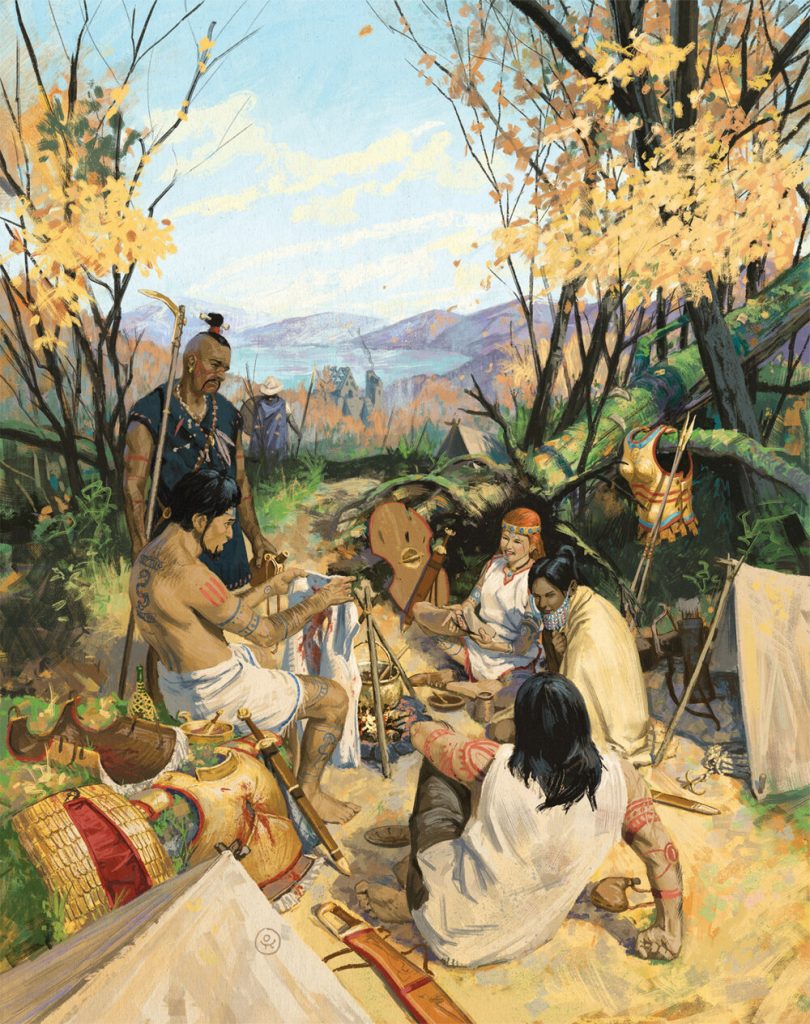
Cover artist Ossi Hiekkala blogged about his work on the upcoming Weapons & Equipment guide, which is absolutely wonderful.
Instead of the obvious choice of showing gear porn, I painted the group of pre-gen characters camping and enjoying each other’s company after their previous encounters and before the eventual hard adventuring the next day, a scene that must be very common for any RPG group, but not often portrayed in the cover art. I am delighted Chaosium was happy to go with this kind of unorthodox cover image.
Joerg was telling me recently that the German RuneQuest community was analyzing this cover and linking it to the action scene depicted on the cover of the Starter Set… for instance, is the damage on Harmast’s armor related to how his fight against the Krarshtkid went? The answer lies with Jason Durall!
The Starter Set is already out (although I’m still waiting for it to arrive…), and the Weapons & Equipment guide is coming out in PDF on December 10th.
Chaosium Hosting New RuneQuest Player Stream
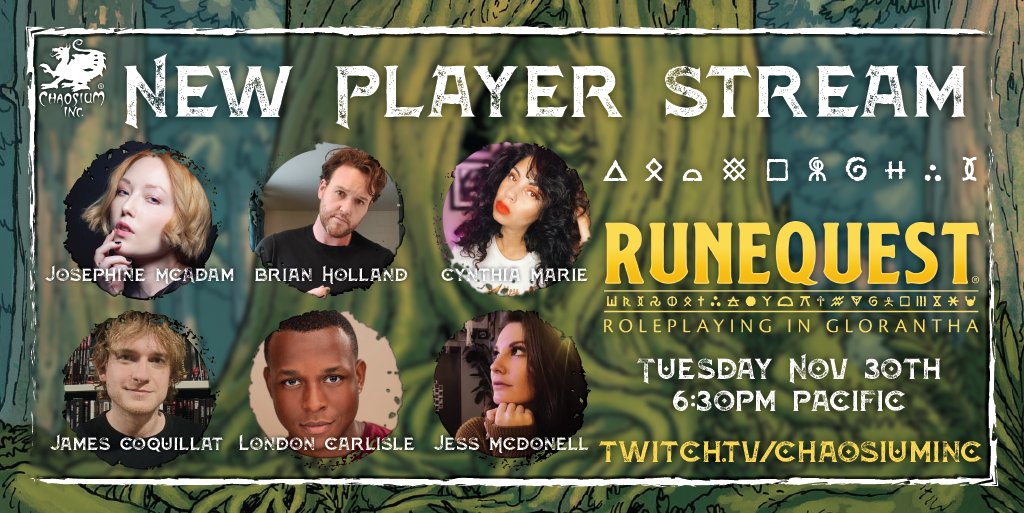
On November 30th, Chaosium’s Twitch channel will host a RuneQuest game with a diverse cast of new players. James Coquillat (of Chaosium’s YouTube channel fame) will play along, and Brian Holland (Chaosium’s Marketing Director) will act as Gamemaster.
I assume they will play one of the Starter Set adventures, but who knows? I’m pretty excited to watch this!
Jonstown Compendium

The Jonstown Compendium is Chaosium’s community content program for all Gloranthan games, hosted on DriveThruRPG. Disclaimer: all the relevant links are affiliate links that hopefully will let us cover some of the hosting and maintenance costs for the website and podcast! Thanks for using them!
Monster of the Month’s Burning Engines

It’s the end of the month so that means a new Monster of the Month! The penultimate one, actually, and it gives information about Burning Engines, some dwarven machines meant to protect their catacombs. As always, you get more than just a few monsters since this one includes adventure seeds and other cool stuff like sorcery spells to control one of those things! I’m pretty sure having a big robot as a pet would make you famous.
Armies and Enemies of Dragon Pass Now in Print-on-Demand

Martin Helsdon’s monster book has been made available in print thanks to the no-doubt herculean layout efforts of Nick Brooke. Martin received the Greg Stafford Memorial Award for Gloranthan Fandom in part for his work detailing all the warriors, soldiers, and mercenaries of Dragon Pass and its surroundings. If your players are getting involved in the Hero Wars, this is a must have source.
Note that the print version is in black & white. The PDF remains in colour, but I don’t think we’re missing much, since the colour parts were either illustrations taken from the Guide to Glorantha and other existing sources, or colored tables and text boxes. All of Martin’s core work, featuring illustrations of almost every possible fighter type, was always in black & white.
Sandheart Volume 4 Now in Print-on-Demand
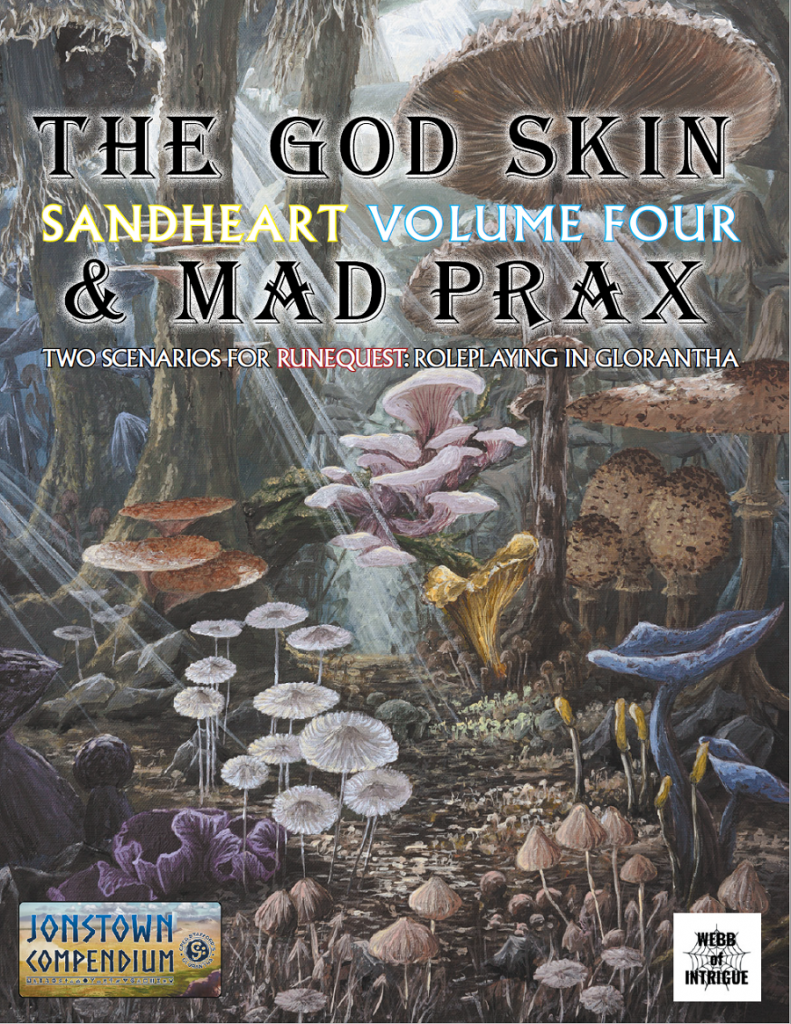
The fourth volume of the excellent Sandheart series is now also available in print-on-demand!
Thanksgiving Sales!
There are many Jonstown Compendium books on sale for the holidays! Including the books from the “Nick Brooke Cinematic Lunar Empire” (A Rough Guide to Glamour, Life of Monsoon Book 1 and Book 2, Citizens of the Lunar Empire), the Andrew Logan Montgomery campaigns (Six Seasons in Sartar and Company of the Dragon), the Sandheart books (Volume One is here but check out the other ones too!), the Beer With Teeth collection (such as the Dregs and Cups of Clearwine), Martin Helsdon’s aforementioned big-ass Armies and Enemies of Dragon Pass, and more!
Jeff’s Notes

Jeff Richard, the current mastermind on everything Gloranthan at Chaosium, is often posting notes and thoughts on the RuneQuest Facebook group. Here’s our curated list from the past week. A partial archive of these sources is compiled on the Well of Daliath.
About Aeolians
On BRP Central, Jeff shared a lot of information about the Aeolians. First, some background: Heortland is the area of the Holy Country that is South-East from Sartar, and from where (roughly) many of the Sartarite tribes originally came from (e.g. see the Colymar tribe’s history in the Gamemaster Screen Pack Adventures).
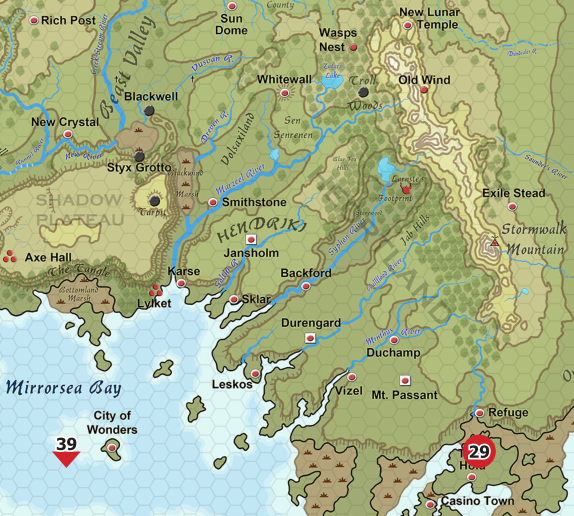
While most of Heortland is historically inhabited by Orlanthi people, the Southern part of the area is where the Esvularing people live, from Leskos to Mount Passant and all around the Bandori Valley where Refuge is located (see map above).
The Esvularing were atheists long ago (like the people from God Forgot, further South), but now they follow a henotheist variation of Malkionism which is called Aeolism. Basically, they worship the Invisible God as the Supreme Creator (like the Malkioni), but acknowledge the Orlanthi pantheon as “emanations” of this Supreme Creator. So they participate in Orlanthi rituals as well. When you’re not sure who’s correct, you might as well do both, right?
Jeff suggests looking at the Druze or Mandaeans as source of inspiration for Aeolians. From the very little I can tell about them, the Druze are monotheists who built their faith from a variety of other Abrahamic religions, and are mostly located in the Levant. The Mandaeans are originally from the Mesopotamian region but have now spread among several western countries. They feel closer to how I picture Invisible God-worshipping people in Glorantha: they are Gnostics who believe in a supreme formless “Entity”, along with various derived deities and spirits, all of which are part of cult secrets.
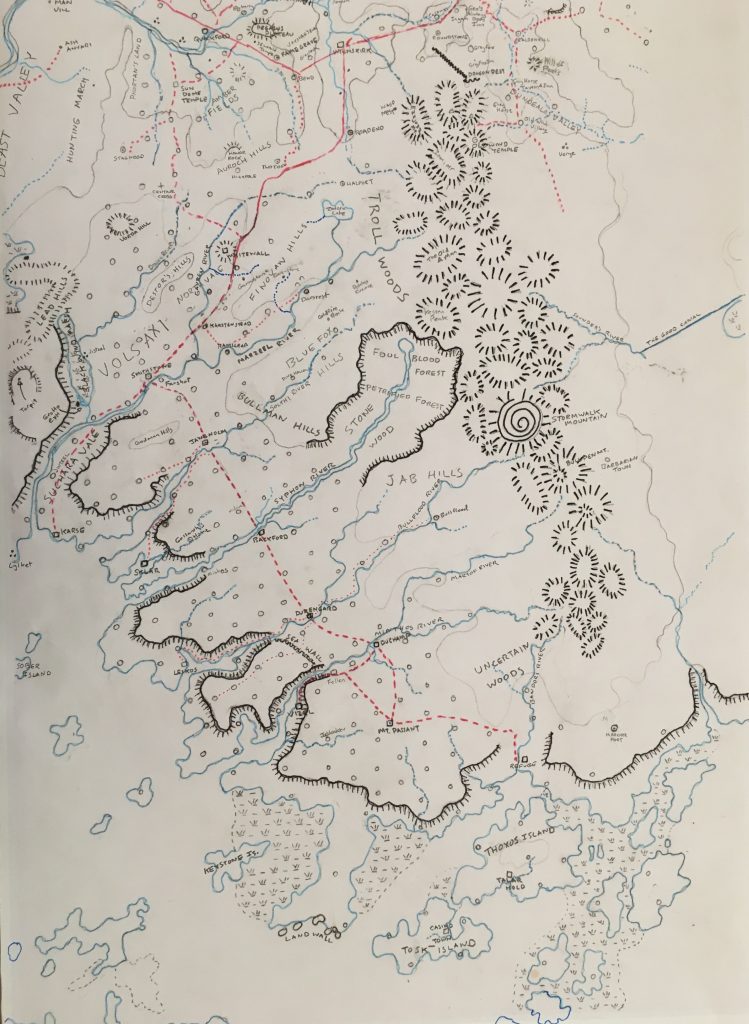
However, Jeff also warns to not “overplay the influence of the Aeolians”, especially since Heortland is quite big. The Orshanti might have a lot more importance, since this is where important figures like Sartar and Colymar hailed from originally:
Presumably the Orshanti remained an influential kinship group in Heortland, linked by blood, trade, and religion to the House of Sartar.
The geographical, cultural, and familial proximity can’t be understated:
[…] Volsaxar and Vandarland are going to have lots of ties and influences to Sartar. Marriages, shared cult, language, and culture, and trade are going to mean that the people of northern Heortland are virtually indistinguishable from Sartarites.
And yet, Belintar is the beloved God-King here because he brings the God Realm into proximity of the mundane world. Heortland is part of the Holy Country, while Sartar is carved out of the wilderness.
Meanwhile at the southern tip of Heortland, we have the Aeolians of Esvular, who are clearly influenced by both the Orlanthi and the Malkioni of God Forgot.
Awesomely enough, Jeff also shared some historical maps of the region to illustrate this point:
It shows the exodus of the original Sartarite tribes (Colymar, Balmyr, and so on) in the early 14th century, the rise of Belintar as God-King, the founding of the Royal House of Sartar, along with other population movements and important events. I believe that the last map shows the Lunar invasions and retreats around the Holy Country. Of note, and according to the Guide, the Bandori tribe was not put under Lunar occupation like the rest of Heortland. Instead, it sounds like they had a “tenuous independence from the Empire”, which I suppose was negotiated by the sorcerer rulers of Refuge.
Meanwhile in central Heortland many customs such as a mounted elite warriors that are selected from aristocratic families and their status approved in assemblies, are clearly influenced by the Malkioni, while at the same time the culture is very similarly to the Sartarites. These mounted elite warriors supported Rikard the Tiger-Hearted’s short lived kingdom (1618-1620) and now many serve as mercenaries.
As for picturing the cities of Heortland, and Mount Passant in particular, Jeff suggests looking at Pergamon and Priene (respectively by Anasynthesis and Rocío Espín Piñar):


Broos Are People Too
A thread on BRP Central asked whether Broos are considered people or not… You can bet that such a poorly phrased question immediately caught fire and devolved into the kind of nasty dispute better reserved for Thanksgiving family dinners, but hey, guess what? American Thanksgiving is today! (at the time of me writing this of course… oh and by the way, unsurprisingly enough, the thread was locked after several pages demonstrating the downsides of Gloranthan fandom)
Anyway, why do I bring this up? It’s because Jeff dropped by the thread in its early hours (yes, I was surprised about this too) to provide a few nuggets of wisdom. As always, any answer to any question depends on who you ask in Glorantha, and as always, the Lunars are the most open-minded:
“Personhood” is a complex philosophical question with all sorts of legal and political ramifications. The only group I can think of that might appreciate the question and its implications are the Lunars – for them, all self-aware beings are “persons” and are capable of embracing the Lunar Way. That includes broo, ogres, and even things like vampires or self-aware jolanti.
The Lunars have had some success with it:
Now some Illuminated Lunars believe that if broo are taken outside of their awful conditions and taught the Lunar Way (including self-discipline and social skills), they can be useful members of society. The Lunars have been able to constructively negotiate with Ralzakark, and are able to send caravans through Dorastor to Ralios without molestation. But even within the Lunar Empire, most people hate and fear broo, and things like the Seven Troubles from Dorastor are within living memory.
Dorastor is the Chaos-infested region located Southwest of the Lunar Empire. It was Nysalor’s Empire of Light a long time ago until Arkat “cleansed” it and it became a horror-filled nightmare. Yay, good job Arkat! Ralzakark is the Broo ruler of the region.
Jeff adds that other people, and other Elder Races, seem to treat Broos as dangerous monsters. Clever, yes, but monsters nonetheless. They must be killed or protected against or, at best, used as a weapon against enemies:
Most Gloranthans view broo as something like the Xenomorph from Alien – dangerously intelligent, but with no higher goals than self-propagation and infliction of pain on others. That is not actually true but it is true enough.
I figure that most Broos encountered as “roaming monsters” in a game are bound to be “feral Broos”, with not much more to them than a one big guy who tells them where to raid and kill. These would indeed be the “Xenomorph-types”, with their INT mostly allocated to predatory intelligence, and on the lower end of the curve.
Ecologically feral and wild broo are disasters. They impregnate as often as they can (think xenomorphs or parasitoid wasps) in order to propagate their species – domestic animals such as cattle or sheep are easiest, but humans or other beings also work. They have a hardy larval stage that matures rapidly, and few broo spend any resources socialising or educating the larvae (also it is rare for a broo to have any idea who its father is). Broo larvae are normally only permitted what they can take or steal. Surprisingly few die from this mistreatment but that is more due to their hardiness. The overwhelming majority of broo are unsocialised young adult males whose main goal is to survive and create a new generation of broo larvae. They are meat-eaters and are perfectly willing to eat their fellow broo. When there are too many broo in an area, they tend to kill and eat everything they can catch and need to move to a new region for food.
Another type would be “wild Broos”, which are nominally less savage than feral ones… but probably just enough to know how to say “I’ll kill your whole family” in Tradetalk, and have some Rune Magic from worship of Thed or Mallia.
Wild broo have cults and some social traditions (usually imposed by powerful and more long-lived broos), feral broo are little more than their life cycle.
But yet other Broos might be more “civilized”, such as those who are brought up as part of a complex society of Chaos worshippers, or those who form war bands employed by, say, the Lunar Empire. Sure, these Broos would still be nasty creatures who routinely commit atrocities that any Gloranthan society would punish with their worst sentence, but they have INT 2D6+6 and they can be reasoned with — the Lunar Empire and even some Praxian tribes did exactly that.
On a welcome practical gaming note, Jeff mentions that wild Broos would rarely ransom captives (or if they do, it’s a vicious trap!), but these “civilized” Broos are different:
Generally when honorable people fight broo they assume the rules of honourable combat don’t apply. That’s because most broo are feral or wild, and are treated like rabid animals. They give no quarter and ask for none. Nobody blinks an eye.
But sometimes the broo offer to parley. They sometimes offer ransom. They sometimes don’t molest their prisoners. Maybe that’s because they are civilised, or illuminated, or cleansed. Or maybe they are under orders from something they fear greatly. That’s when things get interesting, because the rules of honour require that they be followed. But at the same time, they are broos, and many cults treat them as Enemies.
And then there are the outliers, such as the “cleansed” Broo of the Zola Fel, who was freed from his Chaotic taint by the water god, or the allegedly Illuminated Wild Healer of the Rockwood Mountains, a Broo initiate of Chalana Arroy who has saved many lives, but is often mistaken for a feral Broo and hunted on sight.
Ultimately, it’s up to each gaming group to find what Broos are good for in their stories. Feral Broos are great for an hour or two of fun monster bashing every now and then, while more civilized Broos can add nuance and internal conflict to heroes whose convictions and world-views are tested against a bigger picture. As Jeff said: “that’s when things get interesting“. And I hope your games are indeed interesting!
Honour and Combat
As part of the aforementioned BRP thread on Broos, Jeff shared an excerpt from the upcoming Cults of Glorantha book on the topic of honour and combat:
Humakt demands that Death be wielded with honor and his cult upholds the code of honor in combat and war. This code is strictly adhered to by Humakti, but also generally followed by other honorable war gods such as Orlanth, Polaris, Yanafal Tarnils, Yelm, Yelmalio, and Yelorna.
Note how the Humakti follow this code “strictly” while the other cults only follow it “generally”. We know that several members of these other war-cults have committed war crimes, such as Harvar Ironfist, a Yelmalion Rune Lord, who killed and pillaged many lands during his bloody coup in 1611 in the Far Point. Arguably he was “helped” by Gagarthi warbands who have no honour, so maybe he blamed most of it on them… but I doubt it. Harvar is a piece of shit.
Honorable combat is not fought for gain or selfish reasons. Although Humakti often serve as mercenaries for pay, that payment is not supposed to be dependent on the outcome of the battle.
I’m pretty sure combat is almost always for gain or selfish reasons (vengeance, getting more land, getting the throne, etc), but I’m also pretty sure these people think it’s all honourable in their heads!
The buildup and formation of battle lines is done with the full knowledge of the other side and no surprise attacks are made.
This line got quite a lot of discussion over on the Chaosium Discord, where people took this a bit too literally, going as far as “sharing the composition of military units and attack plans with your enemy is madness! You can’t even flank them?“
I think the text here is just talking about the dishonorable aspect of launching a surprise attack on a nation, Pearl Harbor style. In this case, the “buildup and formation of battle lines” refers to the build up to a battle that can last anywhere from a few hours to several days. In the buildup to the Battle of Dangerford, for instance, both the Lunar and Sartarite armies camped on either side of the Creek, in view of each other, with the rebels ready for the Lunar phalanx’s attack. However, within that battle, each army of course adopted classic military tactics such as flanking, surprise cavalry reserves, and so on.
As for other types of surprise attacks, e.g. at the skirmish level, I would say that depends. The “never ambush anybody” geas is a common one with the Humakti, so if you don’t have it, you’re probably OK with it. Maybe don’t raise that Honor Passion too high, eh?
In battle, two warriors may duel or engage in prolonged personal combat. Both combatants must be armed and may use Rune or spirit magic, allied and other spirits, elementals, etc. Groups of warriors may fight approximately equal numbers of foes. However, multiple warriors or magicians must not gang up on a single warrior.
A warrior who surrenders becomes a prisoner of his capture and is under their protection. At the same time, a surrendered warrior must not flee his captor until ransomed or released.
This is all in line with what we see in epics, movies, and even the Starter Set SoloQuest, where protagonists fight a notable enemy while all the unnamed soldiers leave them alone, fighting their own smaller duels in the background.
Honor also dictates how warriors were to deal with noncombatants. No one should attack an enemy who has temporarily lost or dropped their weapon. The lives of noncombatants, prisoners of war, and farmers are also sacred. Pillaging the land is forbidden.
This last sentence also got debated a lot in the Chaosium Discord. My own interpretation is that there’s a fine line between pillaging recently conquered lands, and negotiation supply logistics and agreements with recently conquered populations. Alexander’s military successes were often thanks to his ability to do the latter. It doesn’t matter if he was entering these negotiations with a clear position of force and intimidation: at the end of the day, you either burn down people’s farms or you don’t. Also, like I said already, maybe don’t raise that Honor Passion too high?
Failure to follow the rules of honor can trigger a test of a combatant’s Honor Passion or even result in immediate reduction to that Passion (as per RuneQuest, page 234). Failure to act honorably may also result in a visit from the Spirit of Retribution of the offender’s cult.
Despite all of the above, Glorantha songs and stories are filled with examples of where a hero chose to act less than honorably where some other Passion (Loyalty, Love, Hate, etc.) dictates behavior instead of honor. Such conflicts are at the root of many a tragic hero.
Of note, players and gamemasters can also choose to just go with the dishonourable act without rolling anything, because they want the story to explore the adventurers coming to terms with the consequences… sometimes, the narration trumps the rules.
The rules of honor do not apply to animals, monsters, undead things unless they are capable of communicating or otherwise demonstrating that they do follow the rules of honor.
The Spread of the Lightbringers Religion
Jeff tells us about the early years of the Lightbringers Religion:
In the First Age, the Lightbringers Religion spread from its homeland in Dragon Pass across much of Genertela. These areas are where the Seven Lightbringers and their associates (Ernalda, Storm Bull, Mastakos, etc.) and friends (Humakt) are best known and recognized.
In Prax, the Lightbringers entered in the first century of the First Age. In the later Second Age, many Praxians fled to the Wastes where Waha, Eiritha, and Storm Bull proved most useful. In most of these areas the Lightbringer deities have more or less the same names, although they often have local titles and variants. Nonetheless, an Orlanth worshiper from Sartar will be able recognize and participate in worship in Ralios or Fronela. Indeed, some of the most important historical developments of these cults occurred outside of the core homeland and were only later embraced in Dragon Pass (e.g. Orlanth Rex).
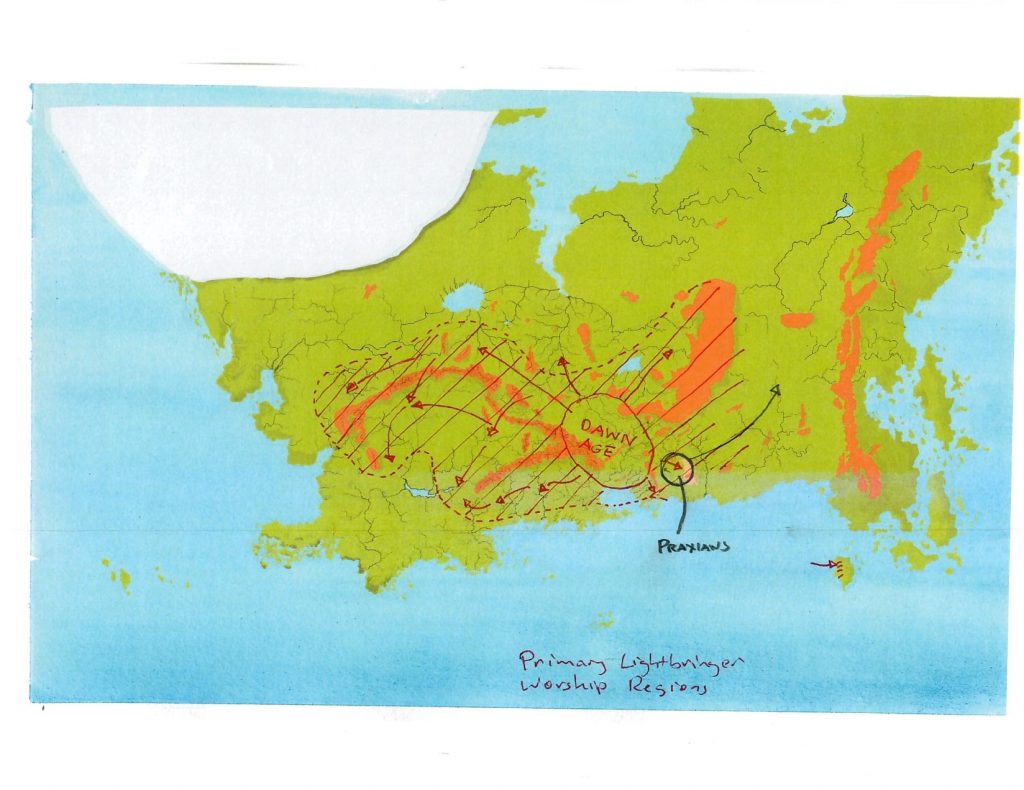
As far as I can tell, a lot of the HeroWars material, and many hard-core Gloranthaphiles, will use these “local titles and variants” freely, which can easily confuse newcomers and, well, myself. But I like the idea of occasionally using these variants (most probably by making my own because I probably can’t be bothered to remember the “official” ones) if and when my game ends up far from its homebase of Sartar. It might add a touch of “strangers in a strange land” which might lead to some fun roleplaying.
Anyway, if you wonder what kind of worship these Lightbringers displaced in the Dawn Age, it’s “whatever got the handful of survivors through the Great Darkness“.
Few of those spirits or minor gods provided much that was useful with the Dawn. The Theyalans brought social organisation, communication with outsiders, written records, agriculture and pastoralism, healing, and more. It is no wonder that the religion spread quickly across the Dawn Age landscape.
The Theyalans were nonetheless very good at proselytizing:
The Dawn Lightbringers had people who […] had great experience in recognising shared symbols and communicating that with [the locals]. The Theyalan Missionaries were probably the most skilled and successful missionaries in Gloranthan history (more than even the God Learners or the Lunars).
So when the Theyalans went out, they were looking for common points. Snippets of magical songs, secrets of life and death, magical languages, shared wisdom from the gods, that sort of thing. They’d find the commonalities and help build a shared understanding of the Dawn. Things and ideas fell into place and people embraced the Lightbringers, their associates, and friends – and the Theyalans learned from the experience.
It was thus a shock when the Theyalan missionaries into lowland Peloria were killed by horse riding barbarians who worshiped the Son of the Sun.
And now the most important bits in my opinion:
The Theyalan missionaries are why sixteen centuries after the Dawn, you can call on “Orlanth” by more or less the same name from Junora to the Elder Wilds.
You can imagine how important Issaries was in all of this. And of course Issaries continued his speaking and trade missions across the world with the Middle Sea Empire.
Community Roundup
The community roundup is our highlight of interesting things being mentioned in the Glorantha-related Facebook groups, sub-Reddits, and other similar online places.
Unboxing the Starter Set in the Nook
Pookie gets some help from a (shadow?) cat and a duck to unbox the Starter Set!
Exploring Glorantha Episode 12
JM and Evan come back to their long-running “Exploring Glorantha” series to offer a walk through the scenarios and campaigns currently available for gaming in Glorantha. They take a look at both official Chaosium material and the best fan-made books on the Jonstown Compendium.
Let’s Look at Some Miniatures
Duff Paint suggests that these minis from Hasslefree Minis could be used as Maran Gor temple eunuchs:
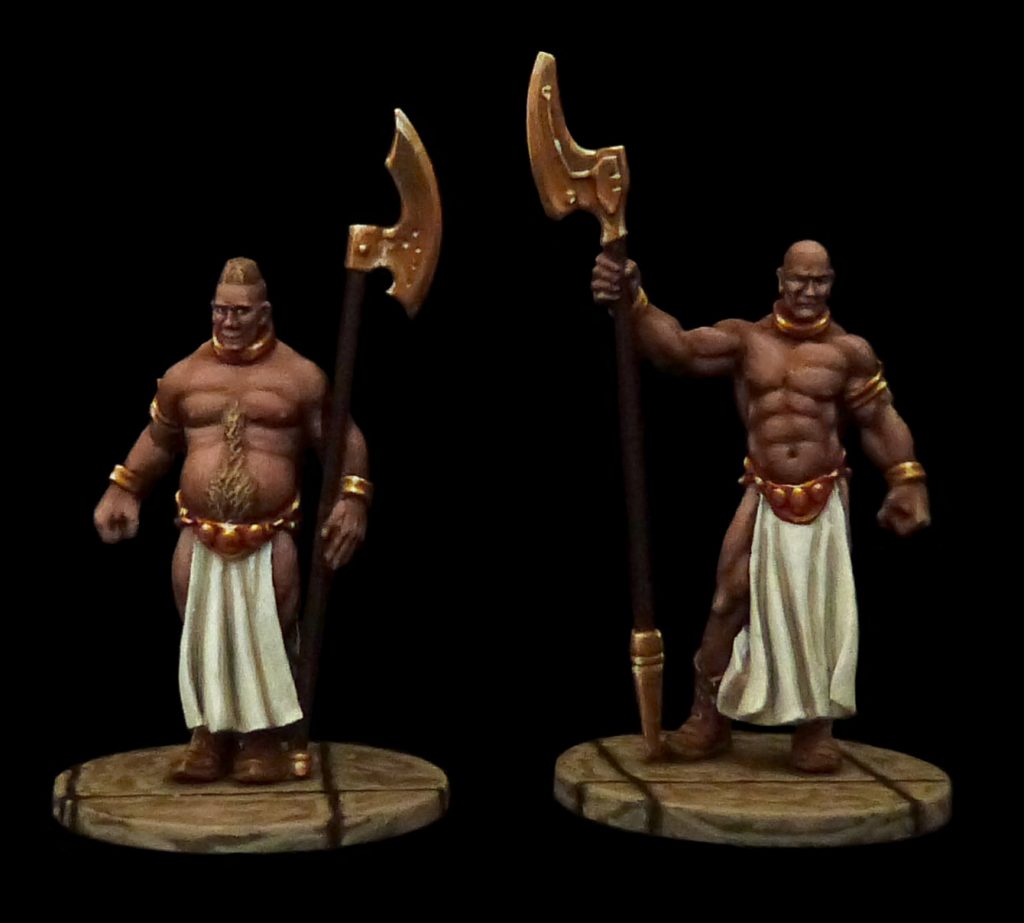
Here are some scorpionmen from Pete Rowans and Richard Helliwell respectively. Pete’s models are 3D-printed.
And last but not least, a Krarshtkid from Paul Baker!
Thank you for reading
That’s it for this week! Please contact us with any feedback, question, or news item we’ve missed!
Welcome to a new issue of the Journal of Runic Studies, the premier Malkioni publication for studies into the nature of Glorantha. If you haven’t subscribed yet, please consult with the spirit bound to the appropriate electronic page.
God Learner Sorcery

We are now occupying a nice little tower with a long history of previous occupants who have left behind documents, tablets, artifacts, and other kinds of junk. As we clean up and archive these things, we share the most interesting ones with you.
Initiation Series Episode 1: Ludovic, The Dark Eye, the Guide, and Maps
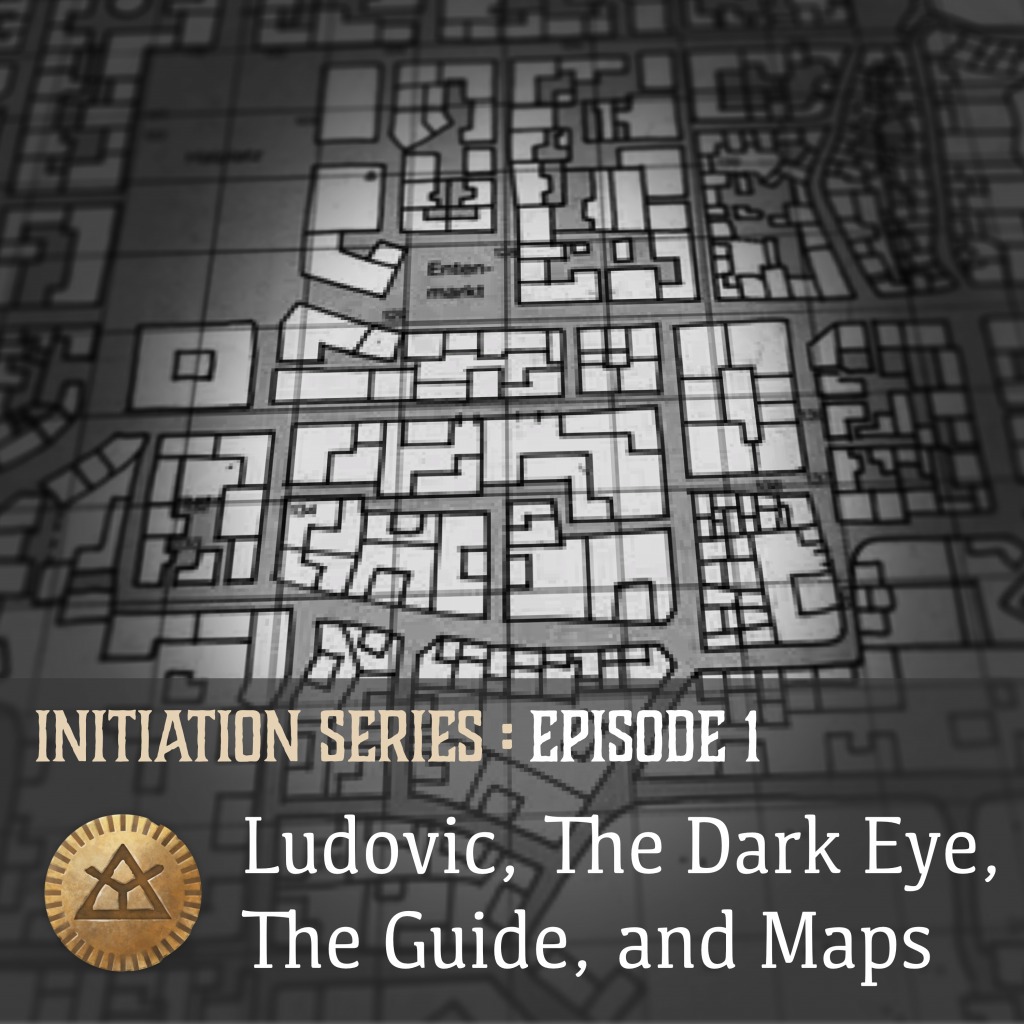
We released the inaugural episode of the “Gloranthan Initiation Series”, where we talk to people who came into contact with Glorantha and/or RuneQuest rather recently, and ask them about their experience and previous experience. In this episode, our own Ludovic (hey that’s me!) acted a guinea pig for our questionnaire, since he qualifies as a “newbie”.
We want to say thank you to all the newbies who volunteered to be interviewed for this series. Their interviews will start airing next month, on a roughly monthly basis in between “regular” God Learners episodes. We think these interviews are interesting: we learn where people are coming from, how they approach an old and complicated setting like Glorantha, and what their struggles and joys are. Hopefully this will also remind a few “old hands” what it was like to be a newcomer in Glorantha!
Chaosium News

Here are this week’s Chaosium news!
Weapons & Equipment Is Coming Next Month

I’m still waiting for my Starter Set to arrive, and we’re already getting a notice that the next RuneQuest sourcebook, the Weapons & Equipment Guide, is coming on December 10th! I really like these covers by Ossi Hiekkala…
Play the Starter Set SoloQuest in your Browser
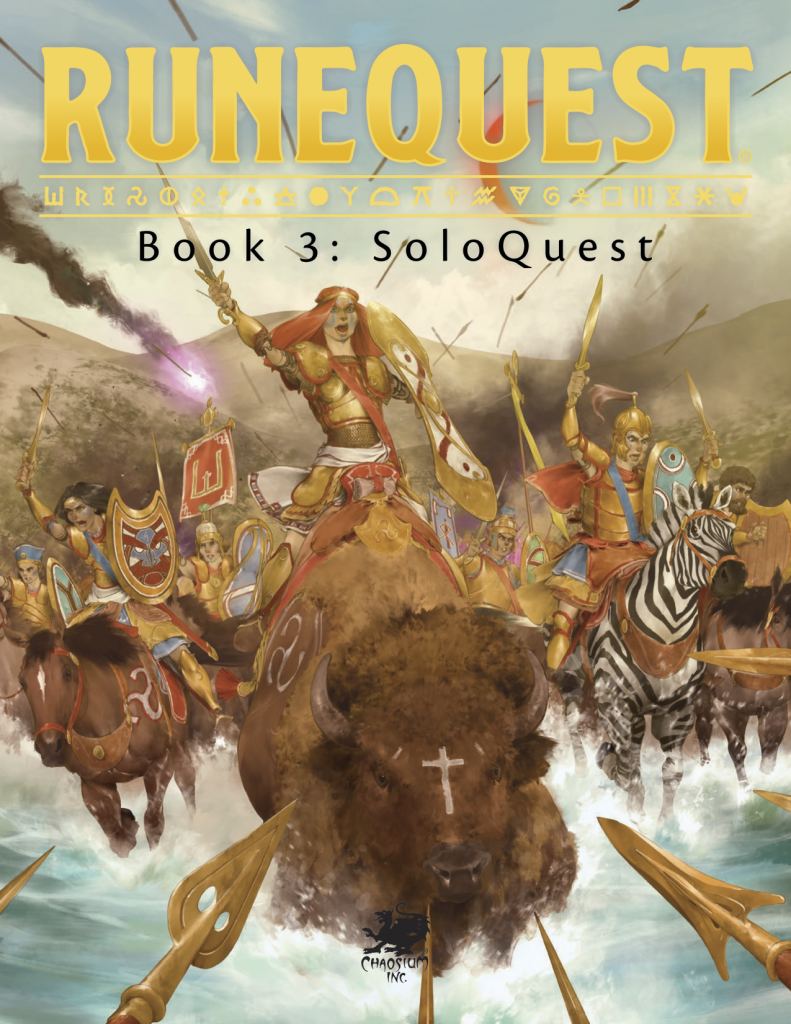
The Battle of Dangerford solo adventure from the RuneQuest Starter Set is now playable for free in your browser! This is a great way to get a taste of the world of Glorantha and the RuneQuest rules, and it’s easy to send the link to a friend. It’s also of course great if you are in a very boring online work meeting…
The RuneQuest Wiki is Online
It’s not really a wiki per se since only Chaosium people can edit it or see pages’ history, but hey, that’s what’s it’s called… anyway, it’s online!
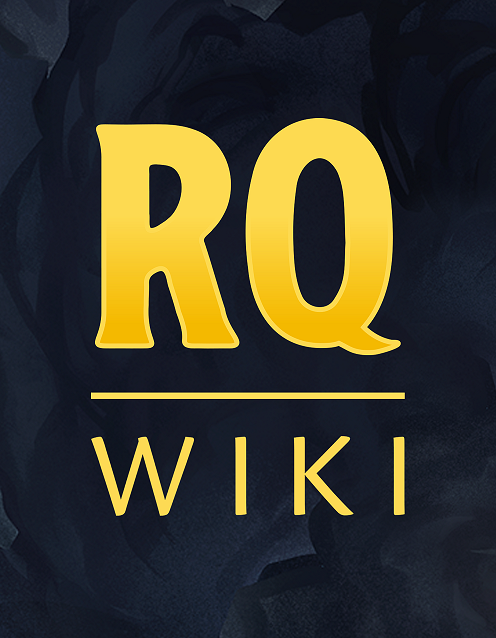
The website is meant to be an easy reference for newcomers to Glorantha and RuneQuest, so there won’t be much for those of you who have all the core books, except for a couple surprises (see below). It will serve as a handy reference for players who don’t have the books, or are on the go.
Right now, the wiki has the Starter Set version of the rules, some setting information, equipment and weapons, a short version of the bestiary, and some quick links to buy the main products. Of note, there are some quick character creation rules, which is very welcome since the Starter Set doesn’t have any, and since they are quicker than the core rulebook’s. They even include random homeland and occupations if you don’t want to choose!
Magic in RuneQuest
This was released shortly before the last issue of the Journal and therefore slipped away… it’s a short interview of Jeff Richard by James Coquillat about the difference between the three magic systems of Glorantha, which is bound to slightly confuse players coming from other fantasy games where there’s only one system.
As always with these videos, there is nothing revelatory for Gloranthaphiles, but it’s a very handy resource to send to any new or prospective players.
Jonstown Compendium

The Jonstown Compendium is Chaosium’s community content program for all Gloranthan games, hosted on DriveThruRPG. Disclaimer: all the relevant links are affiliate links that hopefully will let us cover some of the hosting and maintenance costs for the website and podcast! Thanks for using them!
Anaxial’s Manifest
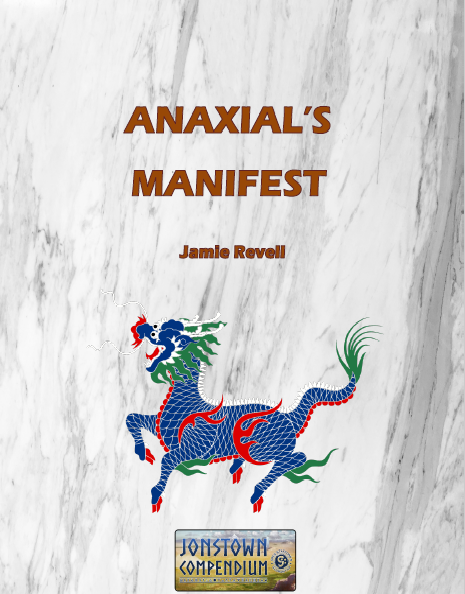
Jamie Revell released Anaxial’s Manifest, a bestiary sourcebook for RuneQuest Glorantha. It contains “a compilation of 46 Gloranthan creatures and embodied spirits not previously described in RuneQuest“.
I assume that the name of the book is a nod to the HeroWars sourcebook Anaxial’s Roster, which did something similar for the HeroWars system. Anaxial is a flood-myth figure of Glorantha, so this is sort of appropriate.
The Duel at Dangerford, in Japanese
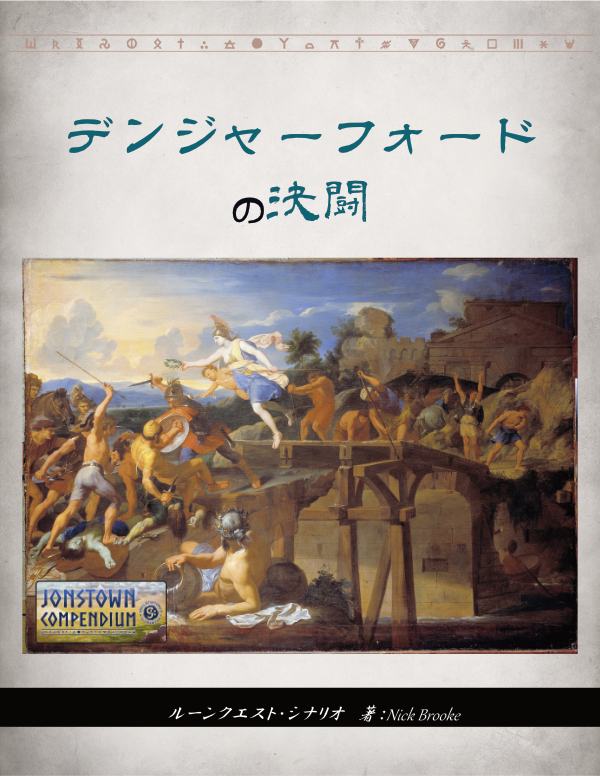
Nick Brooke’s early Jonstown Compendium entry has now been translated in Japanese! It features some extra art and… that’s about all I can tell you about it because my Japanese isn’t nearly good enough!
Jeff’s Notes

Jeff Richard, the current mastermind on everything Gloranthan at Chaosium, is often posting notes and thoughts on the RuneQuest Facebook group. Here’s our curated list from the past week. A partial archive of these sources is compiled on the Well of Daliath.
The Maruts and the Thunder Brothers
Jeff points us to Vedic mythology (late bronze age northwest India) as a source of inspiration for the Thunder Brothers, the sons and daughters of Orlanth who are typically worshiped as part of his broader cult. He points us to the Maruts in particular, who are the sons of storm god Rudra.
A good real world comparison is the Maruts who follow Indra and serve as his followers and companions. Socially they are a model for the companions of the Prince, to whom their deeds are often attributed.
So Indra is another storm god, but what’s more interesting to me is the second part.
First, the Thunder Brothers are models for “companions of the Prince”, which I assume is the Prince of Sartar. This means that if you’re followers of Kallyr or later Argrath (or whoever gets the throne in your timeline), you could try and “get in a role” of a particular Thunder Brother to add some roleplaying opportunities and some questing or sacred regalia ideas to your GM.
Second, the deeds of the Thunder Brother companions are “often attributed” to their leader, which means the Prince and/or Orlanth. The way I see it, when your PCs are companions of the Prince, they might do some really cool stuff but need the… ahem… politeness of letting their boss take credit for it. I hope the PCs have some high Honor and Loyalty Passions! But I understand it also as applicable to Orlanth himself. So one can imagine variations of myths attributed to Orlanth where it’s one of the Thunder Brothers doing the cool stuff. These variations might be taught in some parts of Sartar based on regional traditions, and when heroquesting, you may not have to identify with the big blue guy, you could instead identify to one of his children. It might not provide as big a boon as when heroquesting as Orlanth, but it might also be safer…
The Bad Rain
We already discussed before how Orlanth sometimes summons monstrosities and enemies out of his own bad moods. This is the “Bad Rain”, which is summoned in order to start a heroquest of the Lightbringers Quest.
The Bad Rain is the Shadow of Orlanth – the brooding, repressed darkness within Orlanth such as kinstrife, murder, and wanton destruction – and terrible consequences of Orlanth’s deeds. Orlanth conquered the world, but in doing so he let Darkness and Chaos into the world. As the Greater Darkness approaches, Orlanth broods and the Bad Rain comes.
In many stories this is linked with the emergence of trolls in the Middle World. When Harmast summoned the Bad Rains in 424, it was easy because “every rain we made was a Bad Rain then.” Angorsk Ig, a son of the Only Old One, was summoned, along with the “red trolls, the ones that came with heat” (Zorak Zoran cultists).
The Bad Rain and its monsters attack the ceremony, and it is not uncommon for participants to be killed. Harmast himself killed Angorsk Ig with the Manthi Flints by accident, out of desperation.
Orlanth isn’t the only one with a shadow, by the way:
This recognition of the Shadow is key to the Orlanth cults heroquesting and a source of power. This approach was rejected by the Fire/Sky cults until the Red Goddess herself embraced her Shadow as part of her Goddess Quest.
Jeff muses (but does not confirm) that Ragnaglar may be Storm Bull’s shadow.
Urain, a personification of the Bad Rain in some story, is not Chaotic, despite what might have slipped into some past publications. Jeff shares that some of Greg Stafford’s notes make it clear.
There is also some information about Kallyr’s failed Lightbringers Quest:
When Kallyr began her Lightbringers Quest, she also summoned the Bad Rain, which made manifest all of her subconscious fears and guilt. Many were killed, but the Bad Rain was driven off, and the ritual became a heroquest.
[…]
Kallyr’s guilts, failures, and fears were great as well and she found it easy to summon the Bad Rain. Her fears of what she was bringing into the world – Darkness, Disorder, and Chaos – were made manifest and needed to be beat off at great price.
Two decades later Argrath barely had to twitch to summon the Bad Rain and his heroquest took him deeper than the Underworld.
The Orlanthi often say that a hero is made out of their failures, guilt, and fears. Without those, there is nothing to overcome and thus no hero.
This is a key to Greg’s storytelling. His protagonists – Harmast, Argrath, Arkat, the Red Goddess, Sartar, Tarkalor, etc., – all had failures, fears, and regrets that they needed to confront in order to be a hero. And that unconscious Shadow did not cease to exist as a result of the experience, but the hero could coexist with it and was no longer in danger of being destroyed by their own Shadow.
In some cases, like Arkat, the confrontation with the Shadow was quite literal – Arkat embraced his own Shadow and became a troll in order to defeat Nysalor.
So Jeff wants us to figure out what was Kallyr’s Shadow, and what was Argrath’s. The short discussion that follows points at Kallyr being too “literal and unwavering” about this, whereas Argrath, with his draconic connection, is better able to “embrace contradictions”.
Community Roundup
The community roundup is our highlight of interesting things being mentioned in the Glorantha-related Facebook groups, sub-Reddits, and other similar online places.
Awesome Custom RuneQuest Miniature
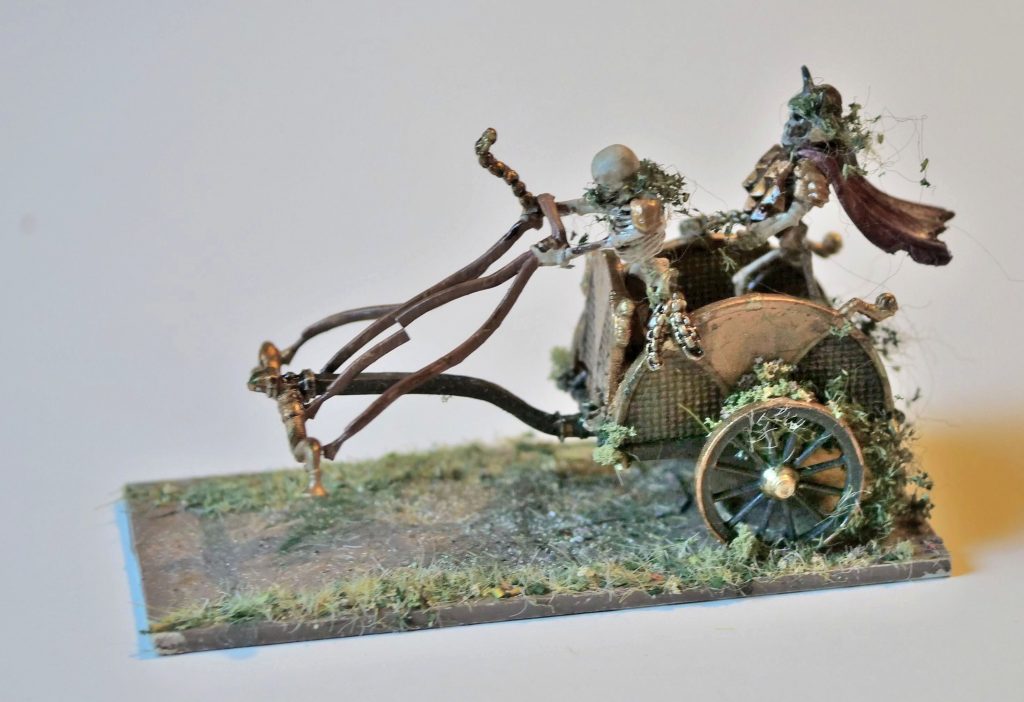
On the BRP forums, Scornado shared this picture of an awesome custom RuneQuest miniature.
It uses a modified Victrix chariot with Wargames Factory and Zvezda skeleton parts.
The miniature is designed for use in a published adventure (also available here) that I won’t name here to avoid spoiling it.
Down a Rabbit Hole with Milk
I love this: Varanis from Beer With Teeth went down a rabbit hole about Praxian mounts and the nutritional value of their milk. And it comes with graphs! Check it out, it’s awesome.
SkullDixon on the Disorder Rune
As promised, SkullDixon has written an article about what the Disorder Rune, and what it means for creating stories in Glorantha.
I feel that a lot of gamemasters and players see the Disorder Rune as just a source and cause for Misfortune. But I think it has a lot more to offer us other than being the source of ill luck and I want to try to explore that fully here.
Besides outlining his many thoughts about the nature of the Disorder Rune, SkullDixon also offers four adventure seeds with Disorder as the common theme.
Unprofessional Unboxing of the Starter Set
Hey this is not a judgement on my part, but merely the title of Scott’s video series!
Unboxings of the RuneQuest Starter are getting extremely common these days (everybody is getting theirs!) but that’s all I have until I can receive mine… especially since the recent floods in British Columbia are making shipping even more complicated!
On The Origins of Ducks
Jajagappa has some funny Eurmal-infused take on the origin of ducks over at BRP Central.
Eurmal, of course, thought this was all very funny. He had the bird folk perform all sorts of silly rituals. He had them hop on one leg across a river – without ever getting wet. He had them fly upside down so that the Sun would illuminate their bellies and the shadows would darken their backs (that’s why all the Ducks have white bellies, even now). He had them dive deep into the Sea to return with the seven Sea Snails – which Eurmal ate, of course, because he was hungry. And he had them perform even sillier rituals. At last, the bird folk grew tired of these tasks and demanded that Eurmal reveal the truth of the leaves.
Read the whole thing, especially if you have ducks in your campaign and you want to throw in yet another possible myth for them… that’s always fun!
Thank you for reading
That’s it for this week! Please contact us with any feedback, question, or news item we’ve missed!


